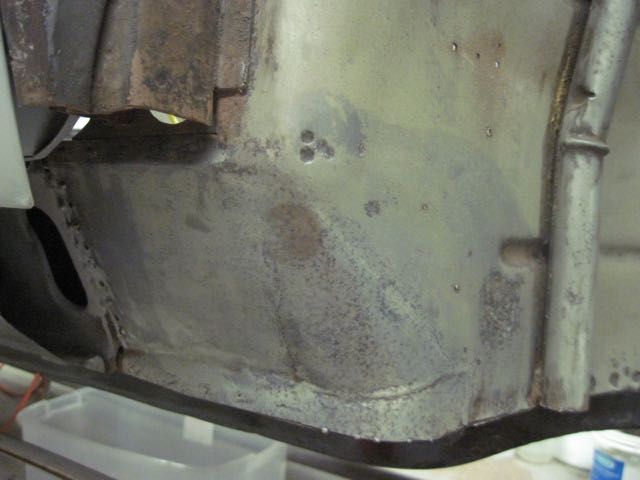The CAD program uses very different graphics, so I will have to find a format in common. I'll see what I can do.
screen capture as a jpeg?
Thanks for the suggestion, JFB. Sometimes I over-think things.
Here is the constraints layer:
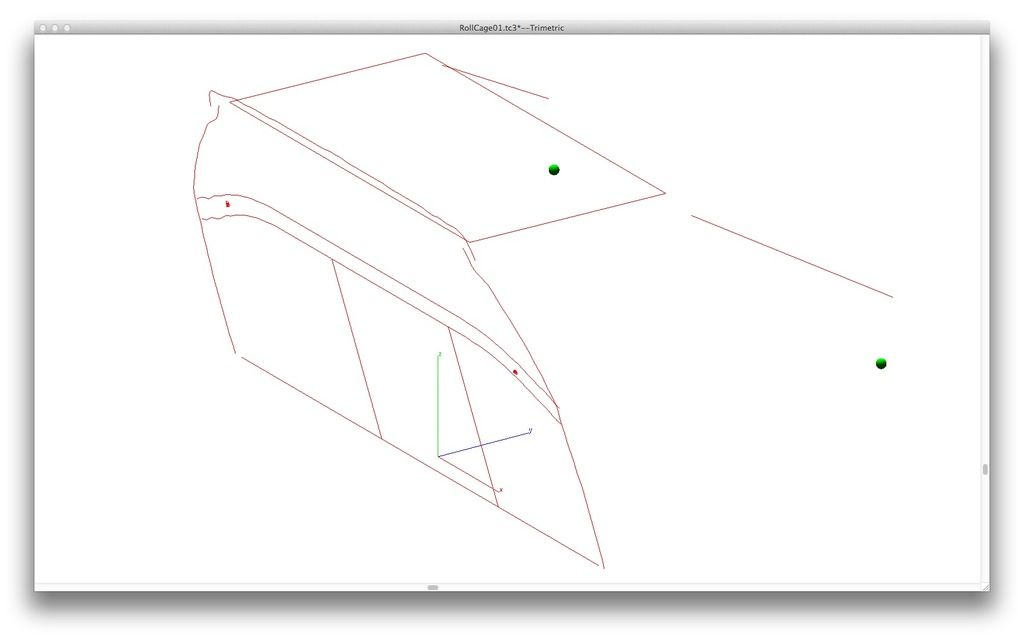
For perspective, imagine you are standing outside the car, off of the right (passenger) rear tire, looking toward the steering wheel.
The fire wall is obvious, the roughly rectangular pattern top center is the roof line from an interior point of view, the angled segments top and right are the A pillars along either side of the windshield, and the green balls are the left and right ends of the dash board where the cage has to clear them.
Next I've turned off the constraints and turned on the tubing layers:
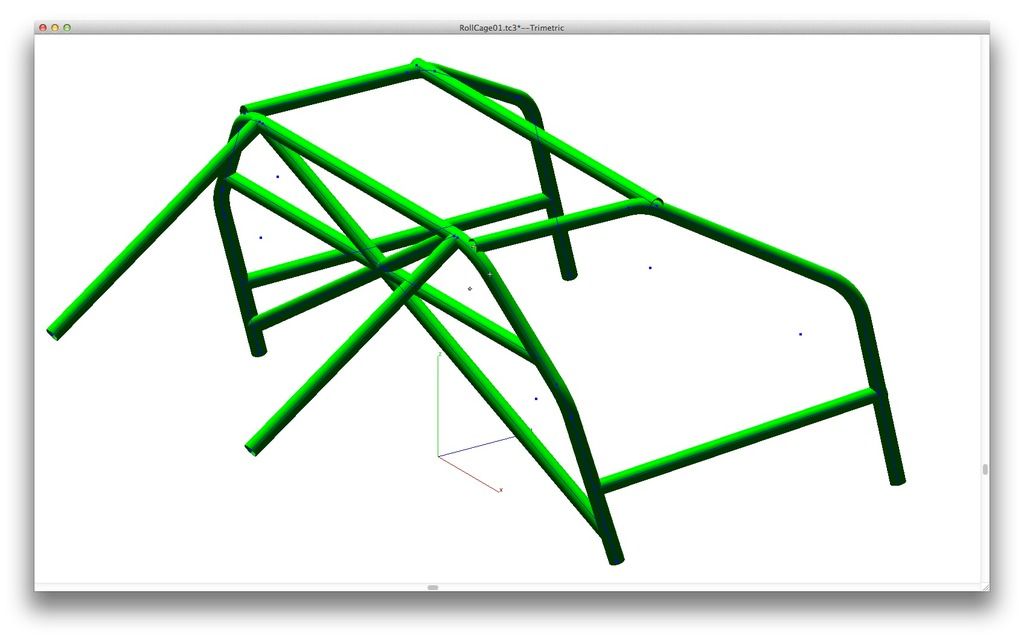
Here the main hoop, the horizontal brace that goes across the cockpit at the shoulder belt attach line, and the side hoops that surround the door openings, are the only parts that have been mocked up so far. The rest only exist in the drawing, and are subject to change. I'm sure I will have to adjust the X brace at the fire wall to allow for access to the engine hatch. The struts back to the rear wheel house attach points are just a first guess also.
Here is the constraints layer:

For perspective, imagine you are standing outside the car, off of the right (passenger) rear tire, looking toward the steering wheel.
The fire wall is obvious, the roughly rectangular pattern top center is the roof line from an interior point of view, the angled segments top and right are the A pillars along either side of the windshield, and the green balls are the left and right ends of the dash board where the cage has to clear them.
Next I've turned off the constraints and turned on the tubing layers:

Here the main hoop, the horizontal brace that goes across the cockpit at the shoulder belt attach line, and the side hoops that surround the door openings, are the only parts that have been mocked up so far. The rest only exist in the drawing, and are subject to change. I'm sure I will have to adjust the X brace at the fire wall to allow for access to the engine hatch. The struts back to the rear wheel house attach points are just a first guess also.
With the stiffener installed, I can finish the mid-rocker and front wheel well surround repairs. The larger, trapezoid shaped piece was a bear; took a couple of tries to get it right.
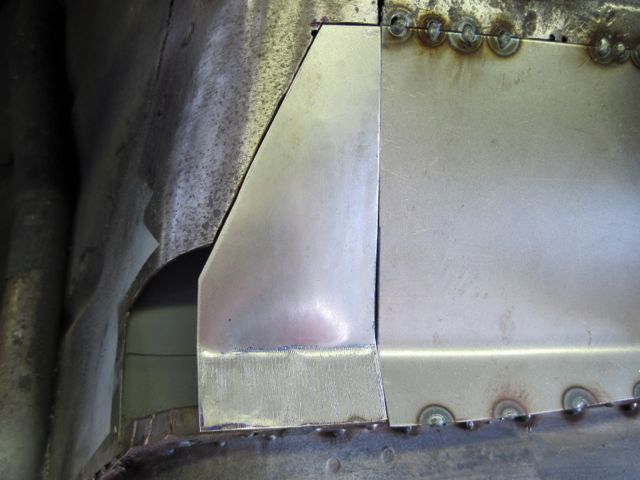

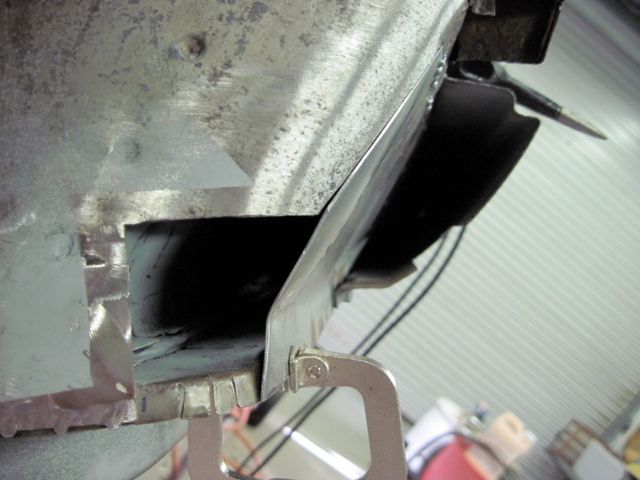
I decided to put a drain / access hole here, so I can spray primer and rust proofing inside later:
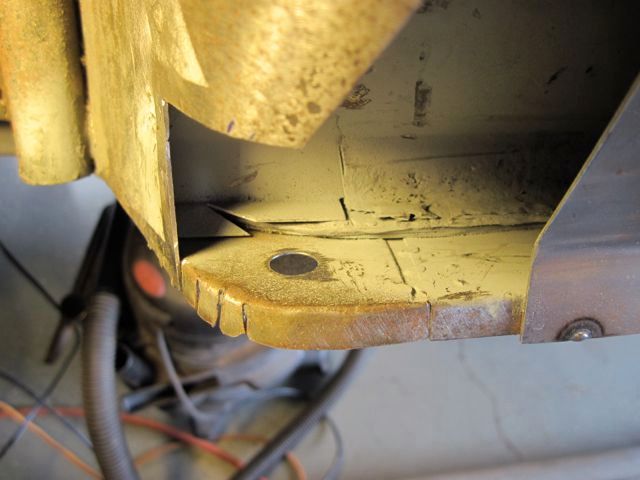
Finishing up here:

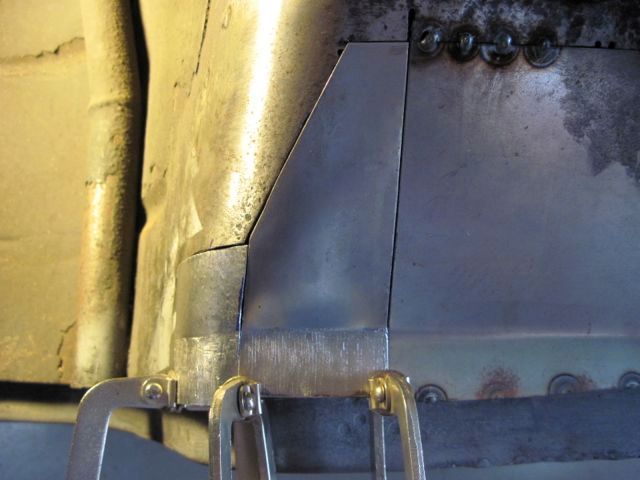

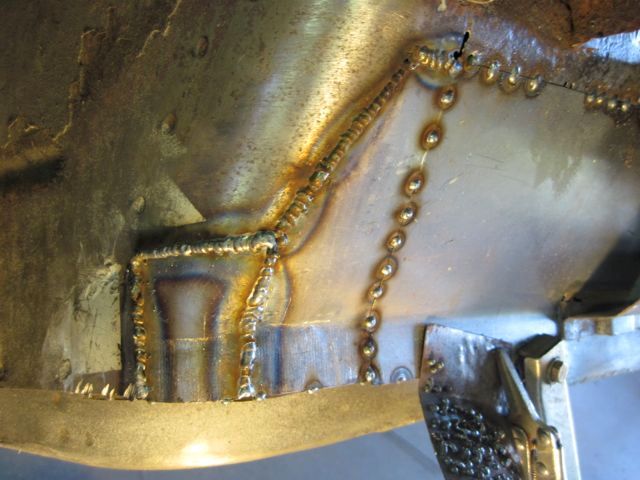
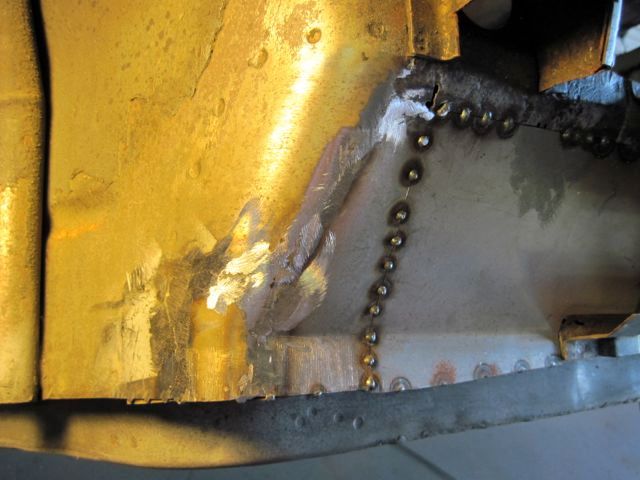
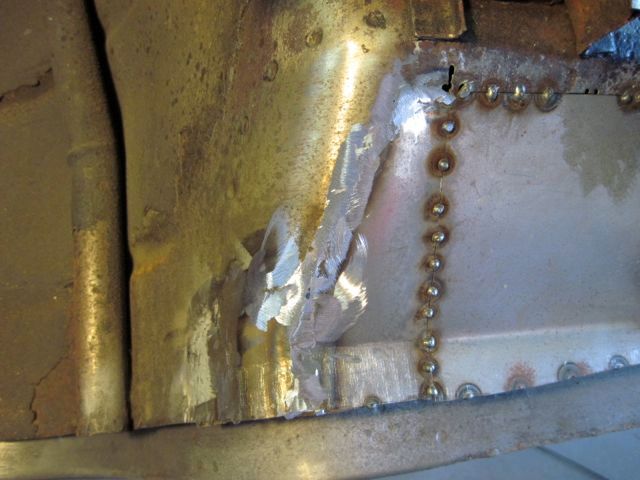
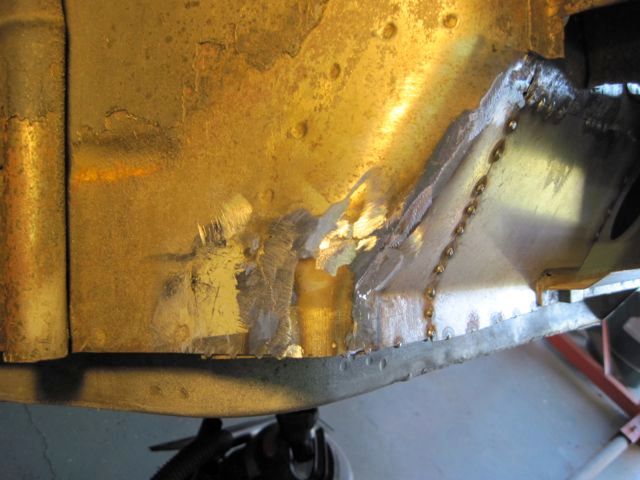
Now I need to rebuild the bottom of the A pillar itself. I chose to use a simple wedge shaped structure. This will restore the original strength, but was also a minor goof up, as I’ll describe in a bit:
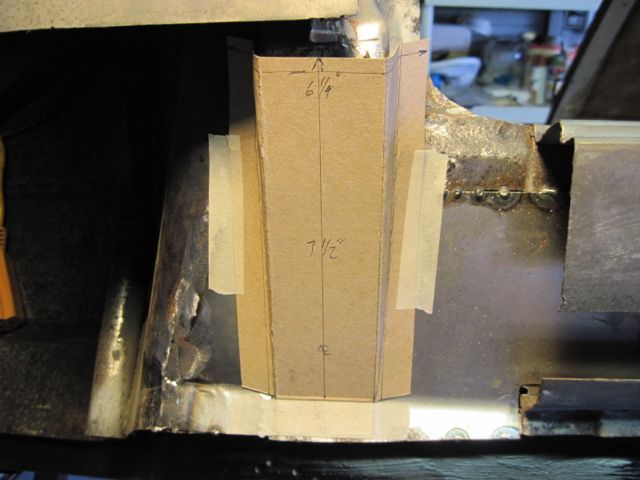

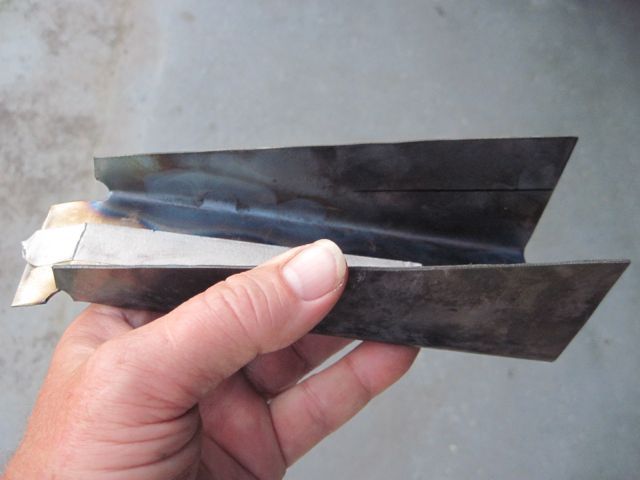
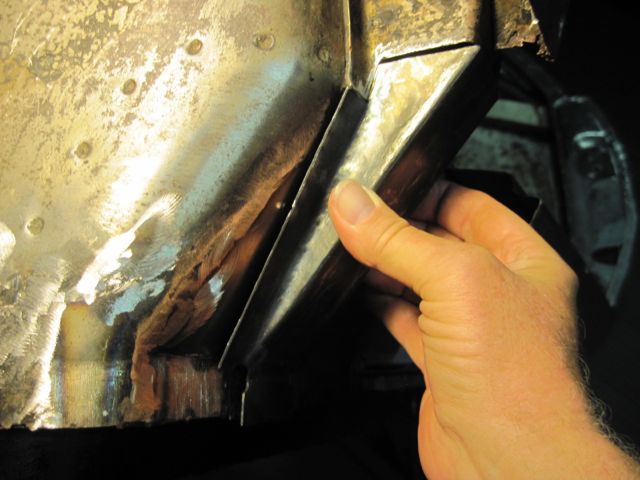

I find that the contour filler panel and fender are rust damaged up a little higher than I thought, so another 1/2 inch or so has to come off:
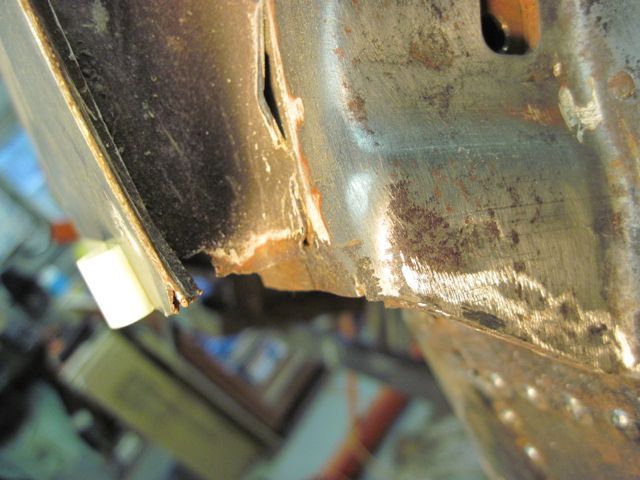
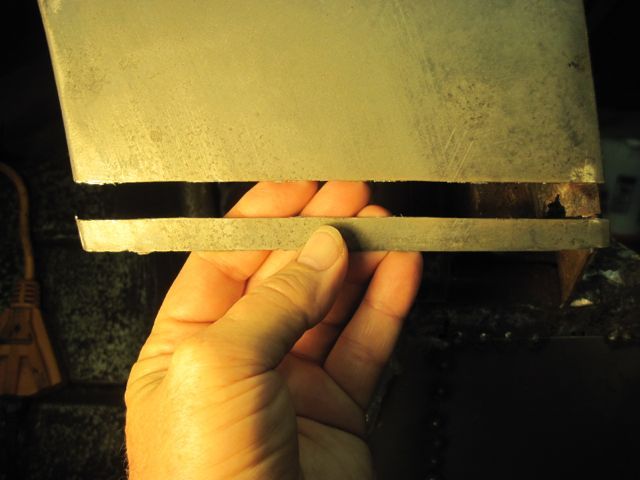
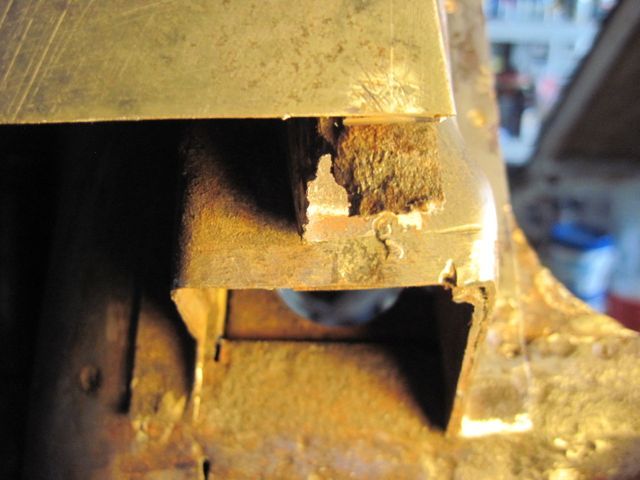
Here I test fit a piece of metal to repair the outer rocker; making sure it will mate up with the work I’ve done so far:
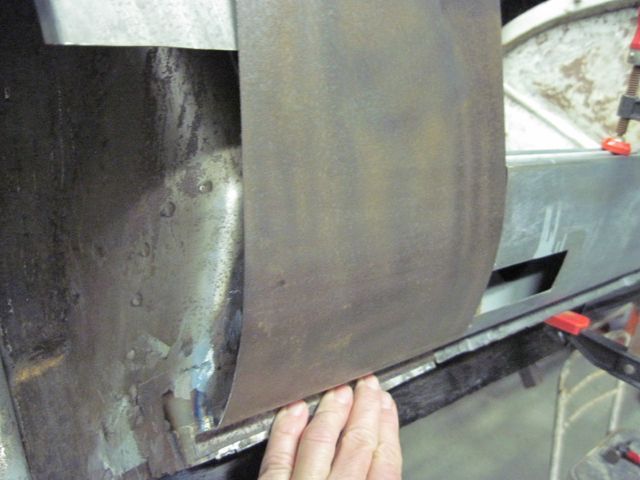
Now to weld in the A pillar repair:


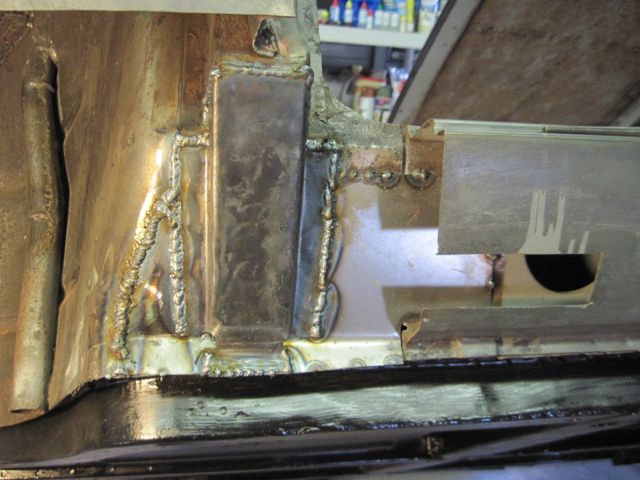
Here is just a small leveling piece. At the factory they just pinched the rocker flange in here and spot welded the snot out of it. This area was very uneven, so it will help to have a clean flat piece to weld on:
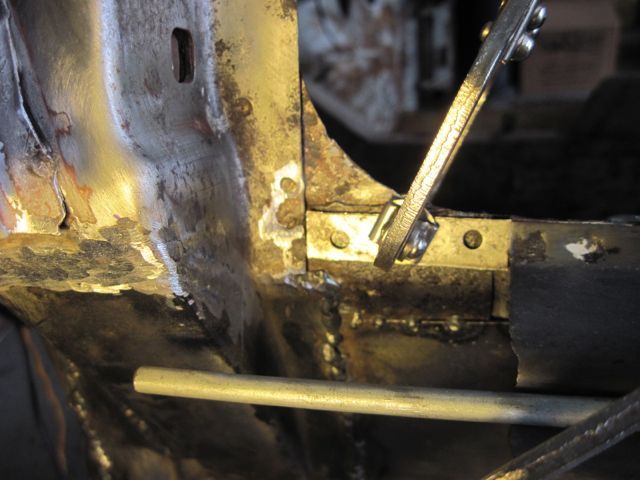
Here is what I meant by a minor goof up. That steel rod you see at right center is laid in the door sill; it helps me line up things. In the previous pic, you can see that it misses the A pillar repair piece by a 1/4 inch or so. That part of the outer rocker that forms the door sill, continues forward to form the flange where the rocker and fender panel join. It should also be tack welded to the A pillar for support. Oops. Likewise, the bottom of the contour fill panel extends down to the same flange, and lays flat against the A pillar. Oops. I need to add a piece to bring the A pillar out further here. It is mostly cosmetic, so a light piece should do:
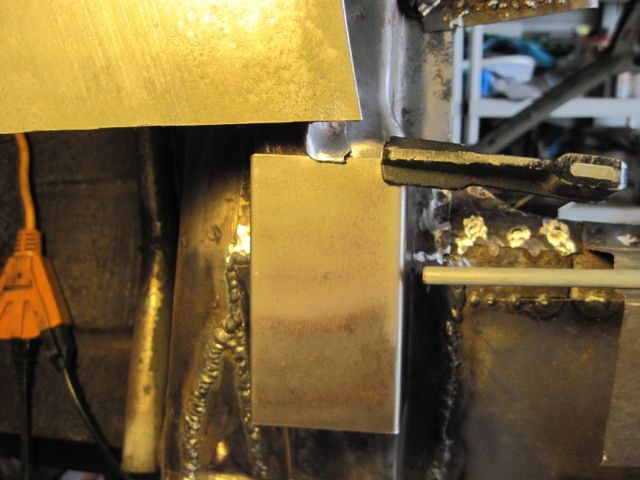
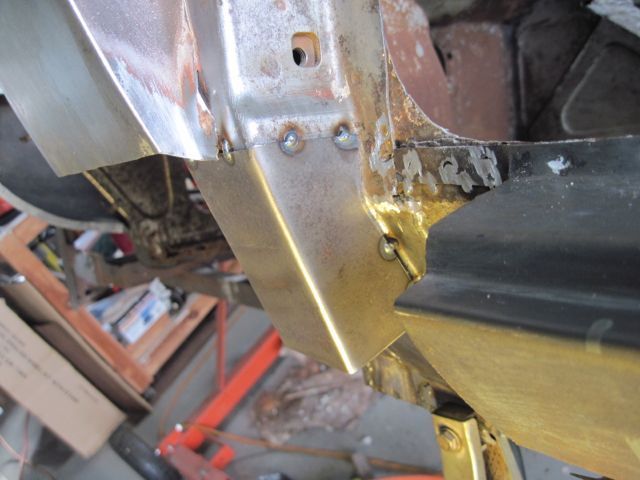
Next I’ll add a backer strip behind where the original metal and new metal join. This helps two ways. In many places, it is not necessary to weld a full bead along a junction like this; a good spot weld every 1/2 inch or so is enough. I also do not have to trim the edges so perfectly. When I’m done with the metal work, I’ll back fill this junction with epoxy, and she’ll be good as new.
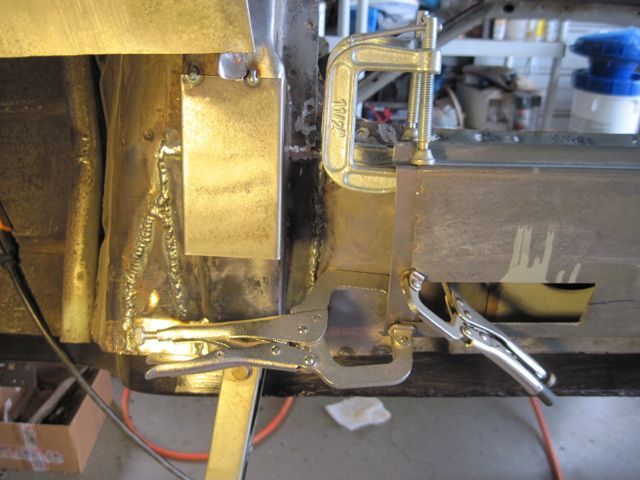
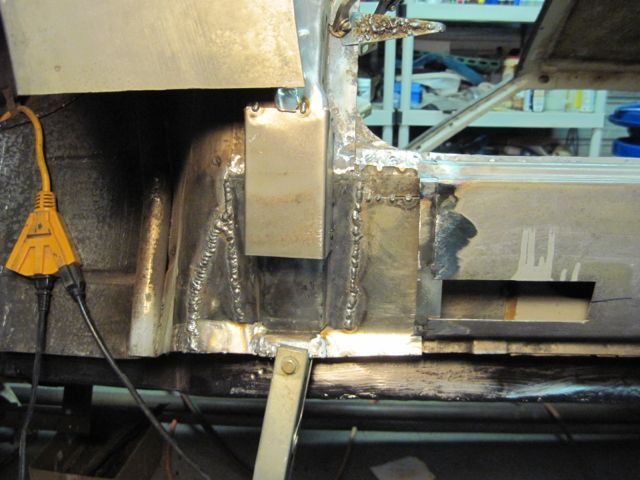
Now I use the steel rod again to position the piece of the door sill I cut out earlier, and weld it back in:
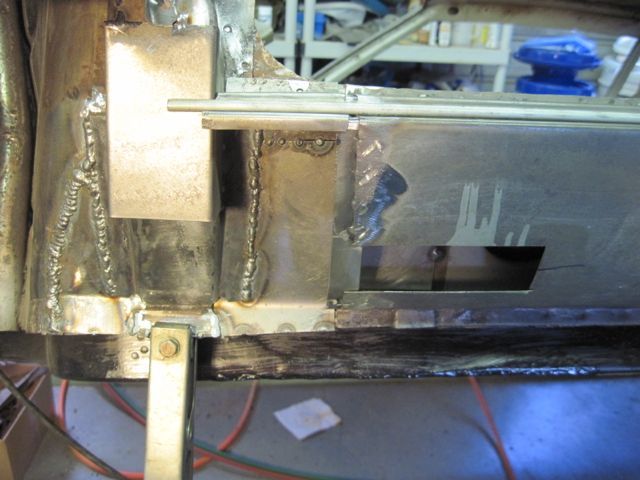
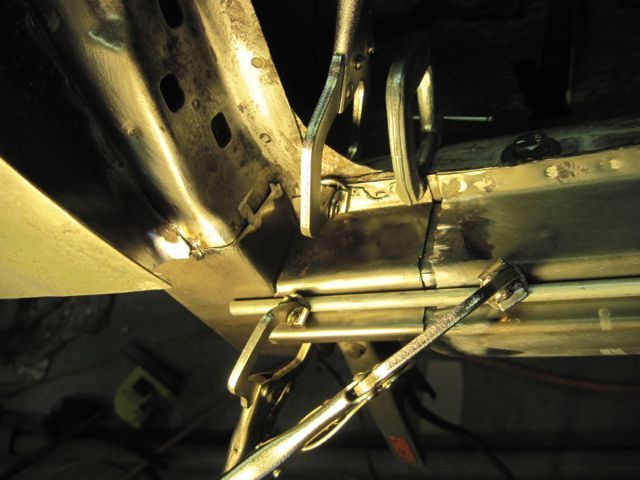
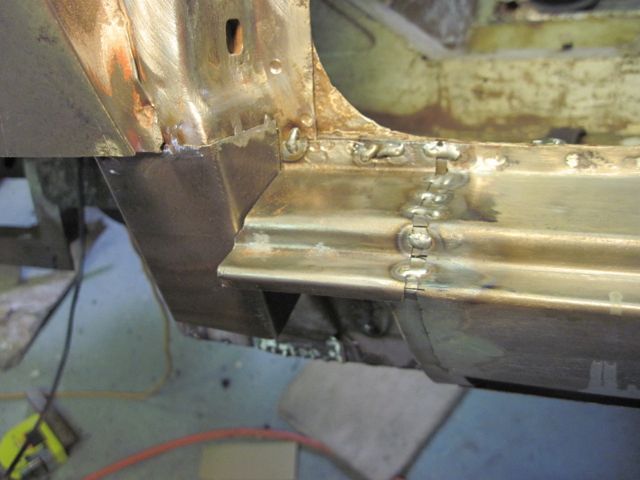
Can you guess what this is going to be?
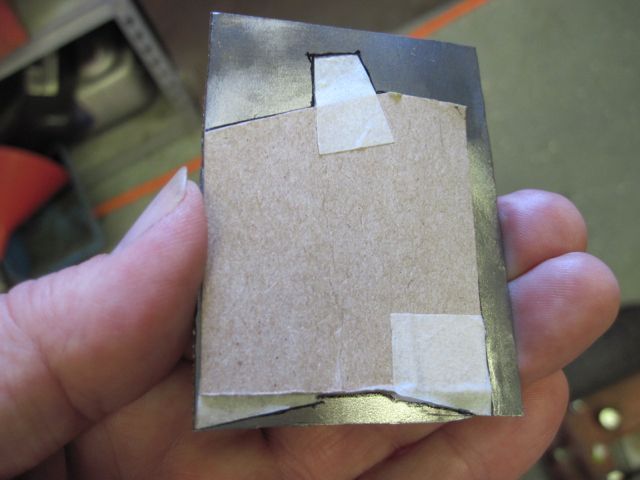
Now?

Now??
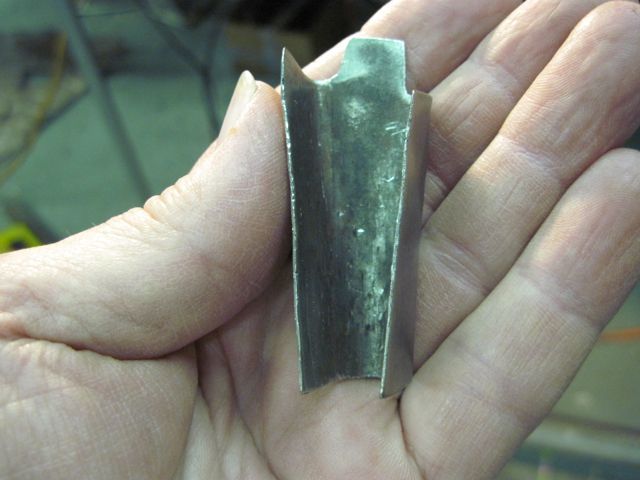
Here is where it goes:
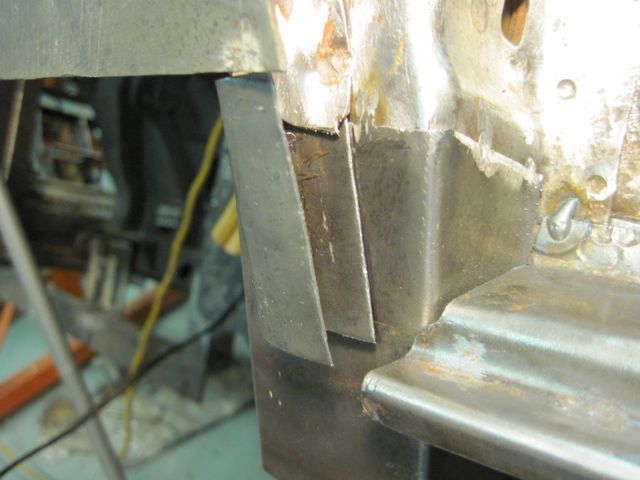
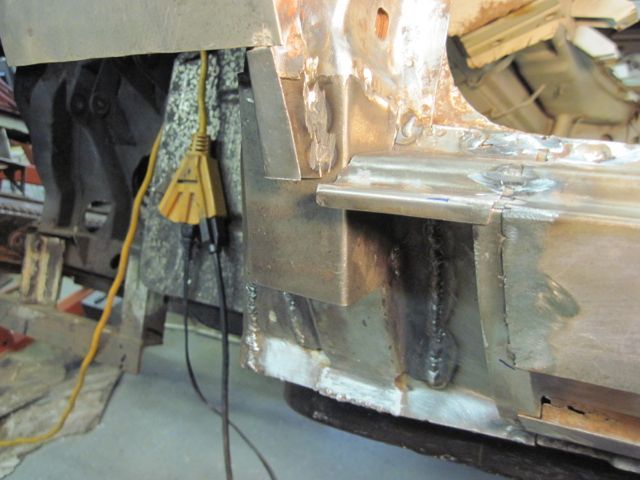
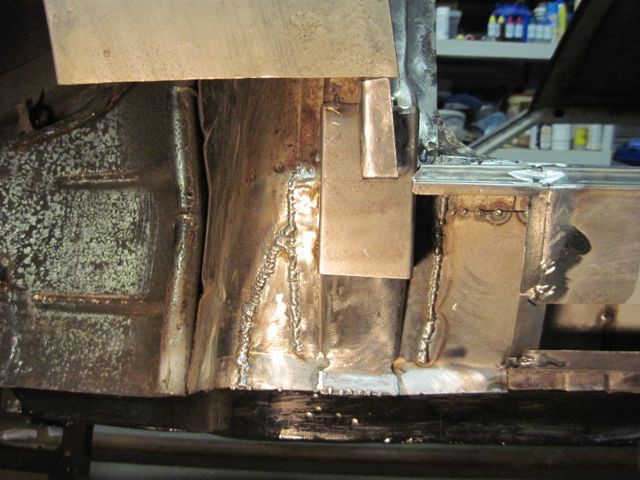
Next to replace the bottom of the fender panel I had to cut off:
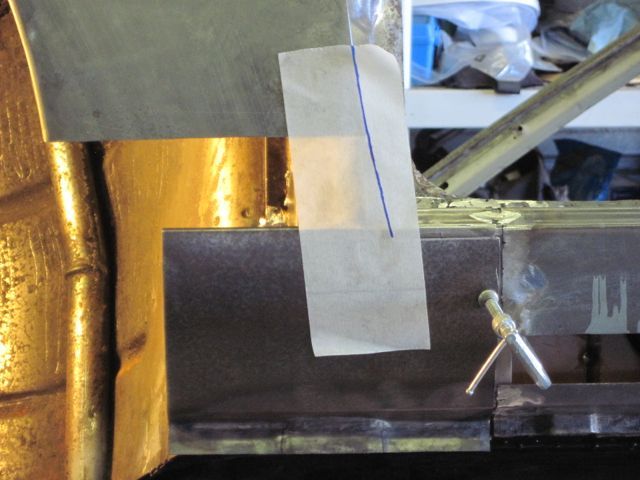
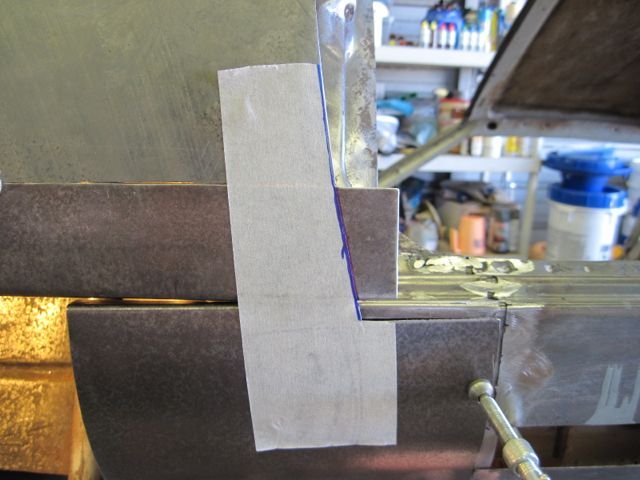
Fitting the new pieces along with the old:
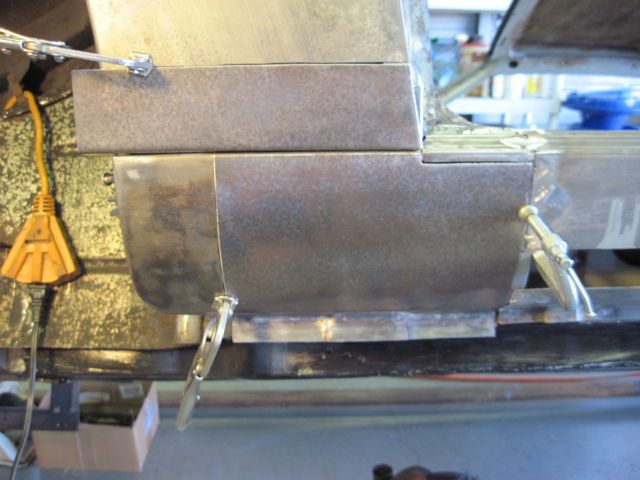
Adding a backer strip:
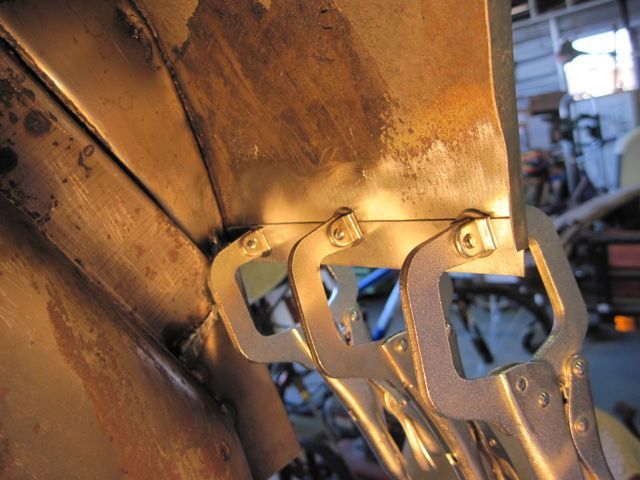
More fitting
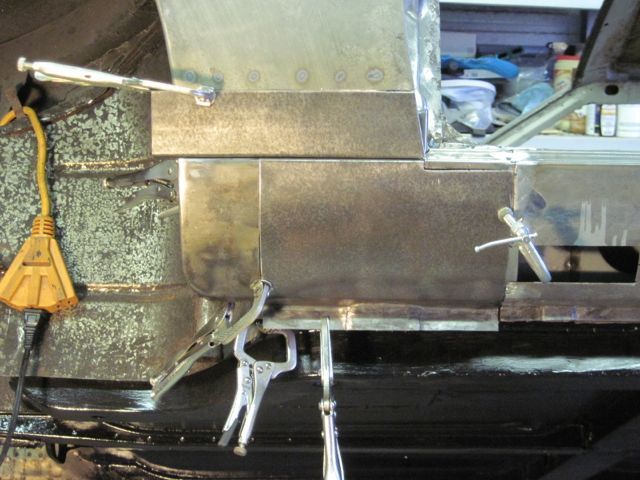
The repair of the fender ready to install:

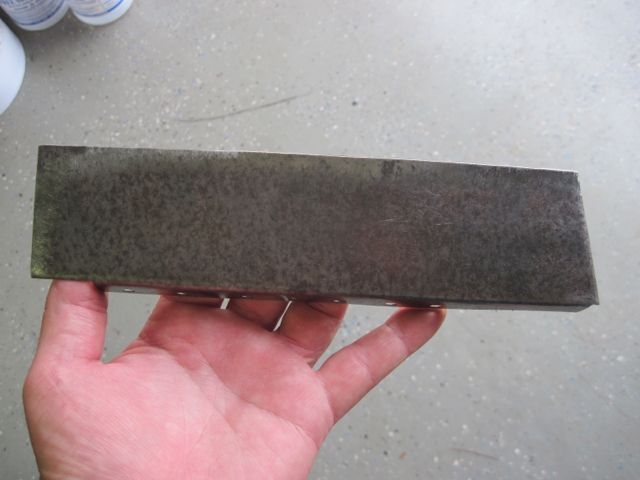
When crimping an edge, I use the extra piece of metal as kind of a pad, so as not to leave jaw marks on the finished piece:
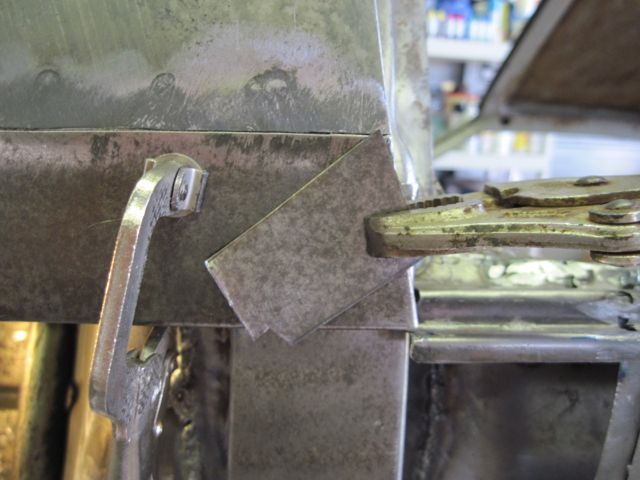
Finally ready to weld it up:
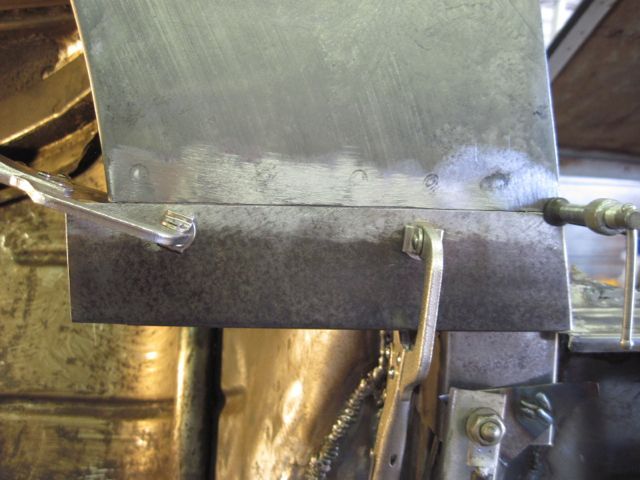
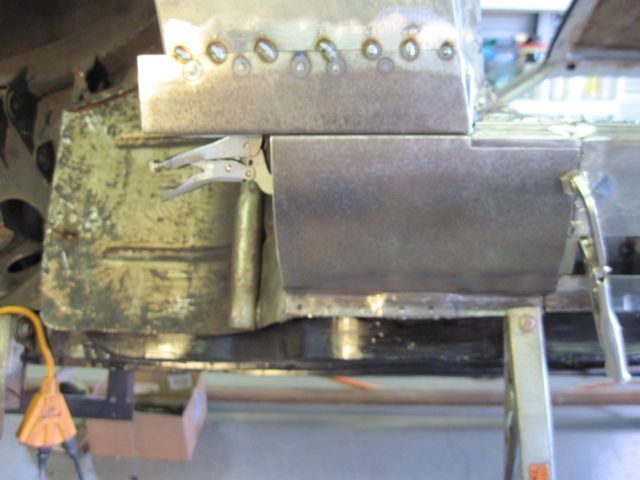
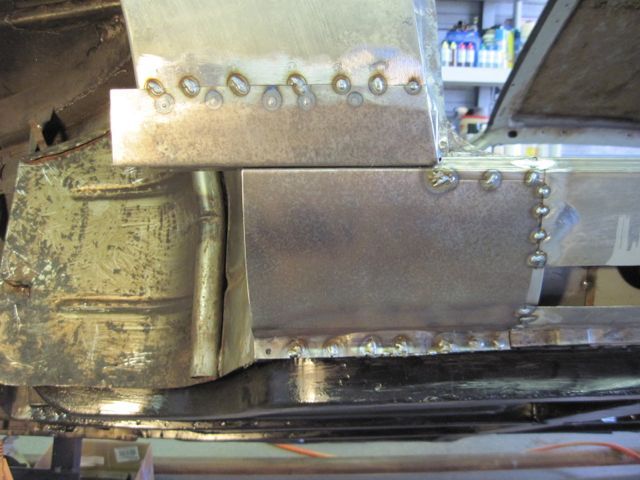
I added a backer strip to this original piece:
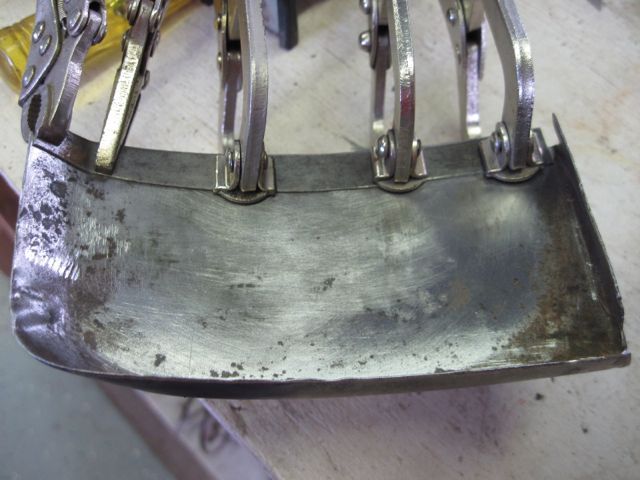
And welded it in:

From the back side:
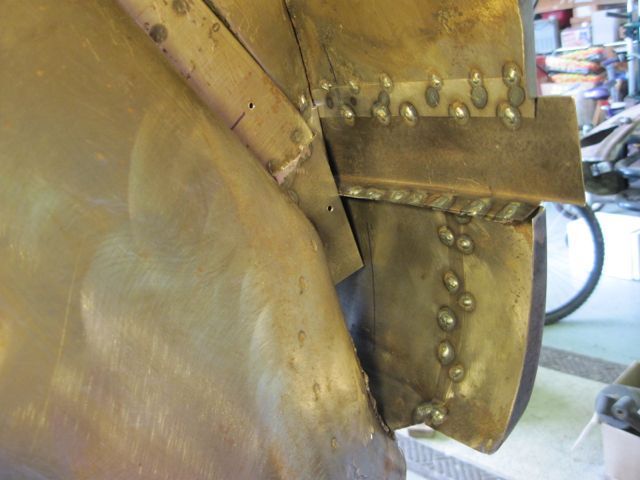
I should have used backers on this piece too, but didn’t. No choice but to weld it all around. The welding is not that hard; the post weld grinding is time consuming:
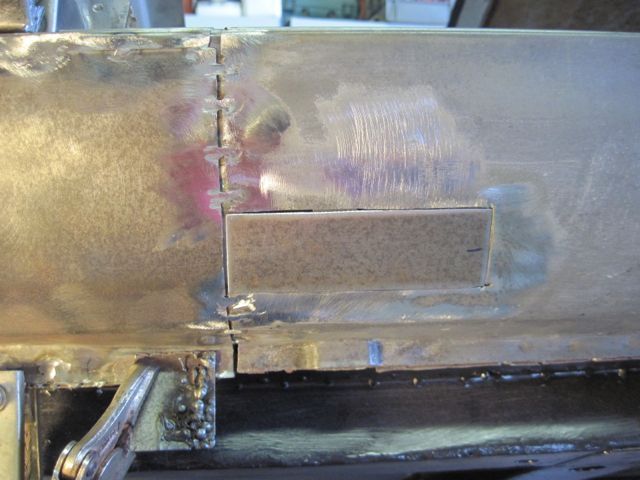
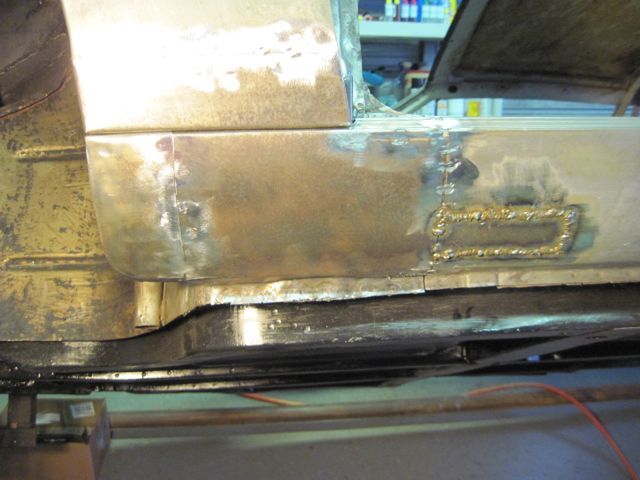
Finally, inside and out:

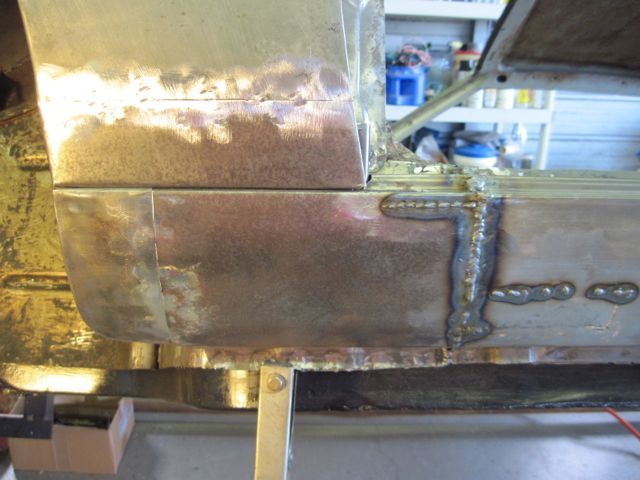
Next up: splash shields. Stay tuned.



I decided to put a drain / access hole here, so I can spray primer and rust proofing inside later:

Finishing up here:







Now I need to rebuild the bottom of the A pillar itself. I chose to use a simple wedge shaped structure. This will restore the original strength, but was also a minor goof up, as I’ll describe in a bit:





I find that the contour filler panel and fender are rust damaged up a little higher than I thought, so another 1/2 inch or so has to come off:



Here I test fit a piece of metal to repair the outer rocker; making sure it will mate up with the work I’ve done so far:

Now to weld in the A pillar repair:



Here is just a small leveling piece. At the factory they just pinched the rocker flange in here and spot welded the snot out of it. This area was very uneven, so it will help to have a clean flat piece to weld on:

Here is what I meant by a minor goof up. That steel rod you see at right center is laid in the door sill; it helps me line up things. In the previous pic, you can see that it misses the A pillar repair piece by a 1/4 inch or so. That part of the outer rocker that forms the door sill, continues forward to form the flange where the rocker and fender panel join. It should also be tack welded to the A pillar for support. Oops. Likewise, the bottom of the contour fill panel extends down to the same flange, and lays flat against the A pillar. Oops. I need to add a piece to bring the A pillar out further here. It is mostly cosmetic, so a light piece should do:


Next I’ll add a backer strip behind where the original metal and new metal join. This helps two ways. In many places, it is not necessary to weld a full bead along a junction like this; a good spot weld every 1/2 inch or so is enough. I also do not have to trim the edges so perfectly. When I’m done with the metal work, I’ll back fill this junction with epoxy, and she’ll be good as new.


Now I use the steel rod again to position the piece of the door sill I cut out earlier, and weld it back in:



Can you guess what this is going to be?

Now?

Now??

Here is where it goes:



Next to replace the bottom of the fender panel I had to cut off:


Fitting the new pieces along with the old:

Adding a backer strip:

More fitting

The repair of the fender ready to install:


When crimping an edge, I use the extra piece of metal as kind of a pad, so as not to leave jaw marks on the finished piece:

Finally ready to weld it up:



I added a backer strip to this original piece:

And welded it in:

From the back side:

I should have used backers on this piece too, but didn’t. No choice but to weld it all around. The welding is not that hard; the post weld grinding is time consuming:


Finally, inside and out:


Next up: splash shields. Stay tuned.
Well done UFO. I love how you're tackling the tasks... lining em up and knocking em down. Hell...at this rate...you'll be driving it this summer...
UFO, You and I are performing a similar restoration. Albeit, yours a bit deeper. What gauge steel are you using?
There are several different gauges needed. Most all of the cosmetic panels are 22 gauge, so are the floor pans. The mid-rockers, front wheel well surrounds, and other structural bits are mostly 16 gauge. I've used some 18 gauge pieces also. I try to pay attention; been more than once I've made a piece of the wrong thickness and had to do it over. I can get small pieces of 22 and 16 locally, the others I have to order.
John, what are you working on now? Your gorgeous 5079 is all done, is it not? Rodney
John, what are you working on now? Your gorgeous 5079 is all done, is it not? Rodney
As you might imagine, after having to repair so much rust damage, I have a keen interest in preventing it from happening again. While I had it torn apart, I spent some time looking at it to see why the rust formed where it did, and what I could do to prevent it. Any place within sight of a tire needs extra attention for rust prevention. The tires throw up sand, rocks, road debris, water, salt, tar, and all manner of trash. This junk hits anything nearby like a corrosive sandblaster. Any coating will eventually be eroded away, exposing the metal, which will also succumb.
Rust also forms anywhere debris and water are trapped. It’s impossible to prevent all water and debris from getting inside the unibody structure, so it is important to give it a way to get out.
My approach is to coat the underbody metal with epoxy primer. In areas exposed to the tire blast, undercoating will be used as well. Splash shields will protect the most vulnerable areas, and be removable for repair or replacement as needed. Some extra drain holes may also be added.
I started making the templates for these shields before I finished the A pillar work, because the area is easier to get to. Here is the cardboard and tape mock up:

The lower round hole is for the antenna wire, which I’ll not be using, so I will plug it. I’ll make a cover for the obround hole in the longeron, and cover the upper round hole along with the gap that is exposed into the ventilation cowl.
Here the area is cleaned up and the obround hole is covered:

The shields are held in with sheet metal screws:
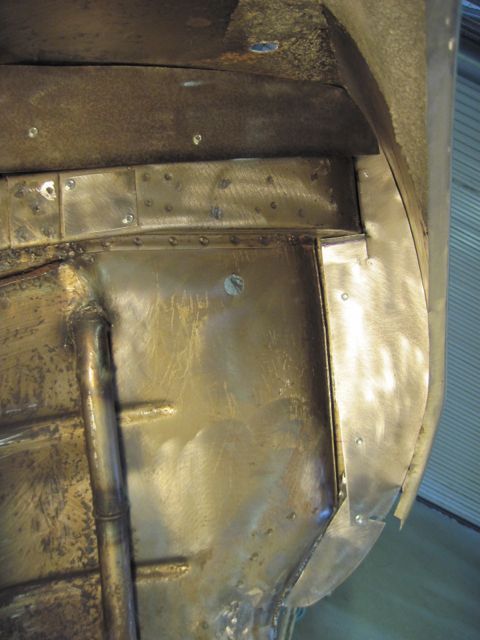
These pieces are ready for their first coat of paint. The center and right ones are for the left front wheel well / A pillar. The left one in this pic is for behind the left B pillar. It would normally be hidden by the gas tank.

The more complex shields are made in pieces. It is easier to make them that way, and also to install and remove them.

Stay tuned for my next installment! Rodney
Rust also forms anywhere debris and water are trapped. It’s impossible to prevent all water and debris from getting inside the unibody structure, so it is important to give it a way to get out.
My approach is to coat the underbody metal with epoxy primer. In areas exposed to the tire blast, undercoating will be used as well. Splash shields will protect the most vulnerable areas, and be removable for repair or replacement as needed. Some extra drain holes may also be added.
I started making the templates for these shields before I finished the A pillar work, because the area is easier to get to. Here is the cardboard and tape mock up:

The lower round hole is for the antenna wire, which I’ll not be using, so I will plug it. I’ll make a cover for the obround hole in the longeron, and cover the upper round hole along with the gap that is exposed into the ventilation cowl.
Here the area is cleaned up and the obround hole is covered:

The shields are held in with sheet metal screws:

These pieces are ready for their first coat of paint. The center and right ones are for the left front wheel well / A pillar. The left one in this pic is for behind the left B pillar. It would normally be hidden by the gas tank.

The more complex shields are made in pieces. It is easier to make them that way, and also to install and remove them.

Stay tuned for my next installment! Rodney
Hi Rodney,
Looks great. Just a thought...might you consider making them just a bit undersized and use some "bulb" type weather strip seal on them? This will offer a better seal than trying to cut it as exact fit.

Just food for thought....
Looks great. Just a thought...might you consider making them just a bit undersized and use some "bulb" type weather strip seal on them? This will offer a better seal than trying to cut it as exact fit.

Just food for thought....
Good idea, Rob. That looks like a JCW item, right? I think I will caulk / undercoat the semi-permanent shields in. Use the whether strip on those that need to come out more often, like in front of the right rear tire. I moved my battery tray there.
Rodney, my current project is 7159. The car is remarkably rust free above the rocker panels. However both rockers and the front valence are compromised. I not sure how this happened. Perhaps a flood car? regardless, I purchased the car knowledgably and have finished rebuilding the valence area and support frame behind it. I am now rebuilding the passenger rocker area. As you know, the work is slow as fabricating parts and reassembling the structure is tedious. I'll post some pics later of the effort. Since I removed the entire outer rocker, there is a bit more to see. I purchased Wilkinsons, not the factory's, outer replacement rockers. They are side generic requiring you to trim of the extra to fit the side you desire. I also bought replacement middle rockers. However, the passenger side will not require replacement. My fingers are crossed that when I remove the driver's side, it is also repairable. It will be nice to get my money back on those inner rockers. Wishing that I had a 40" metal shear.
I buy that kind of stuff from McMaster Carr Link
OK, now on to rust repairs to the bottom of the left B-pillar. First I strip away old paint, bondo, and some lead, so I can see the extent of the damage. At least that which can be seen from outside:
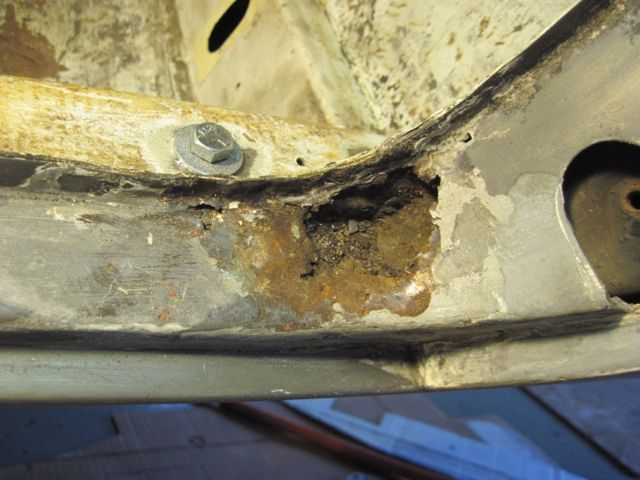
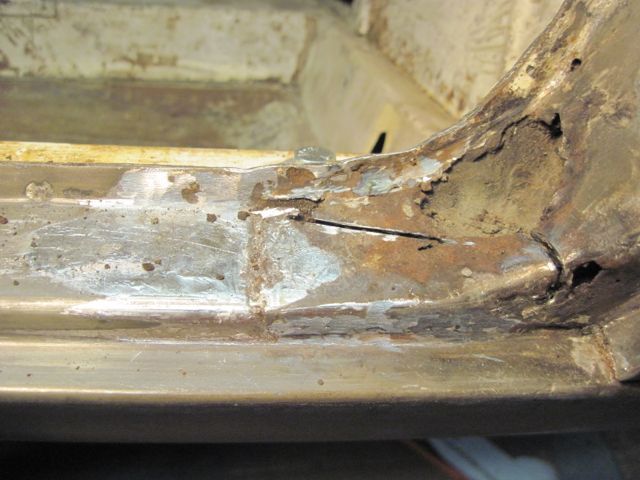

I’ll use some masking tape to section off the damaged parts, with attention to locate the spot welds and drains:
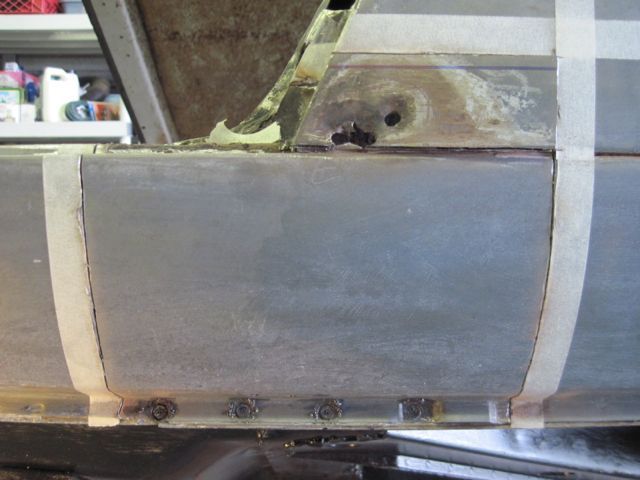
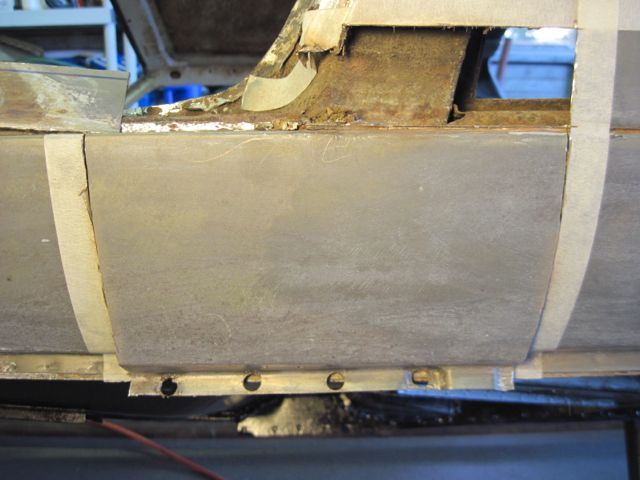
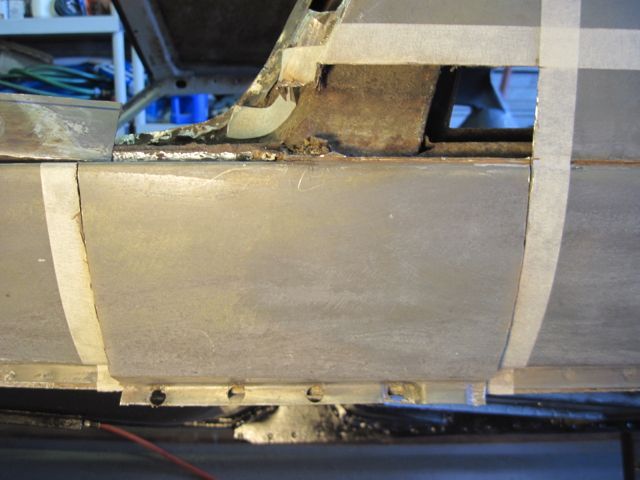
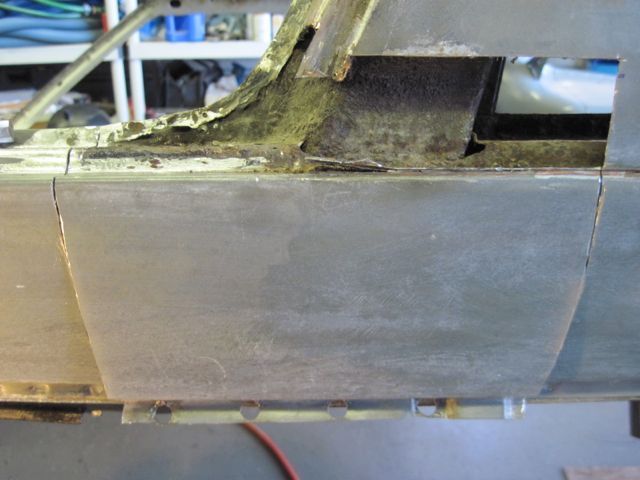
I may be able to save some of this outer rocker panel piece, but not what I find under it:
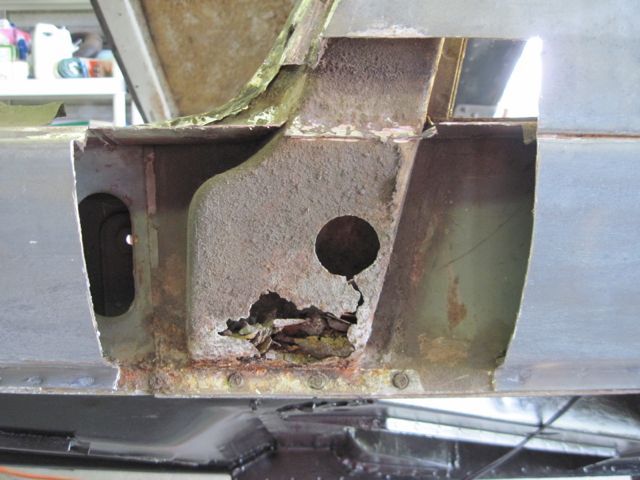

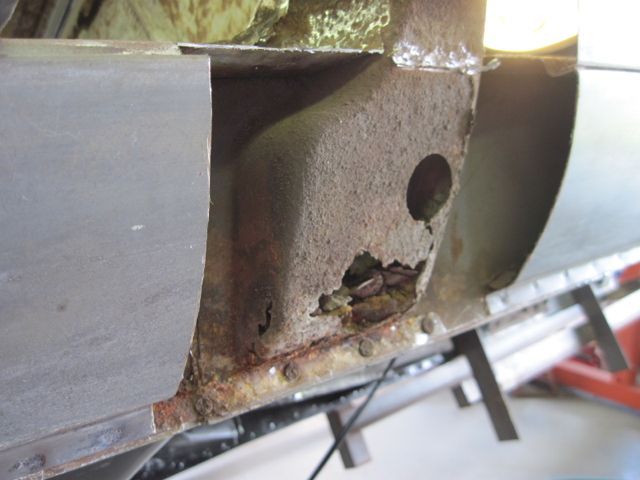
Now I have scuffed off the worst of the rust scale. I find what seems to be a good place to cut away the bottom of the B pillar:
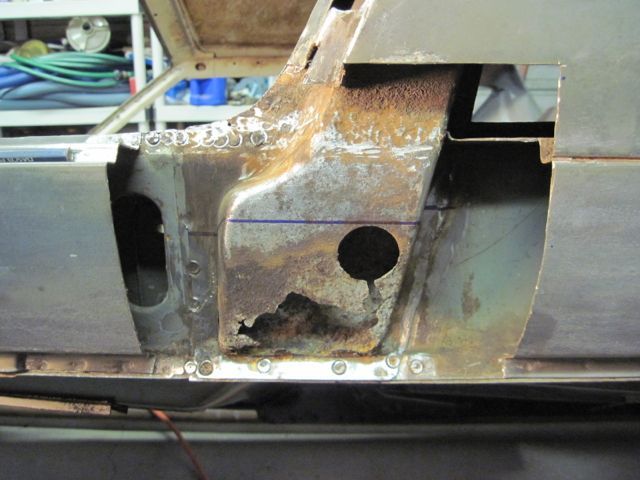
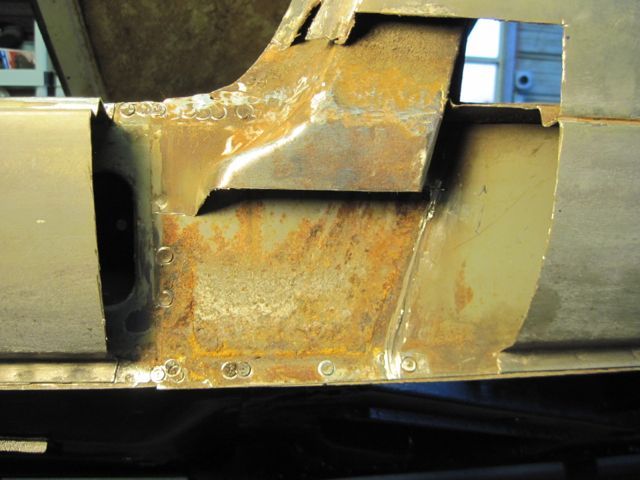
This WAS 16 gauge steel:
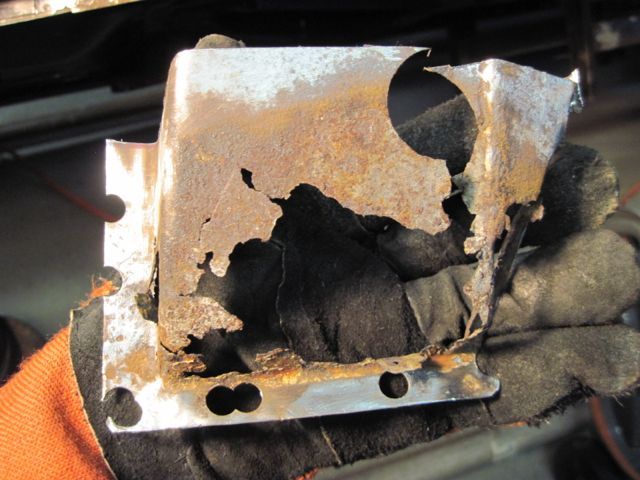
So was this - the mid rocker:
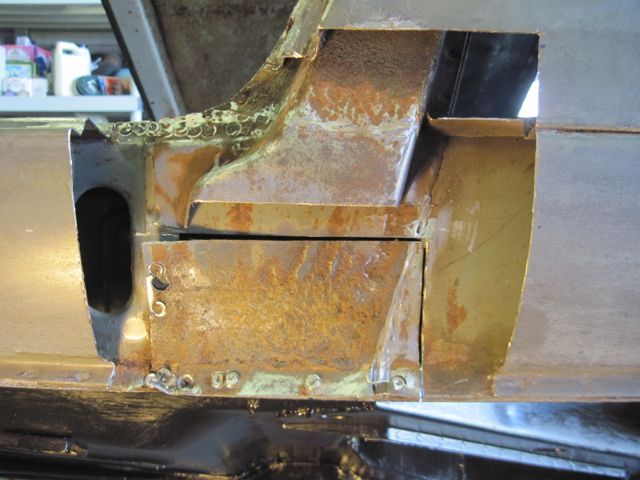
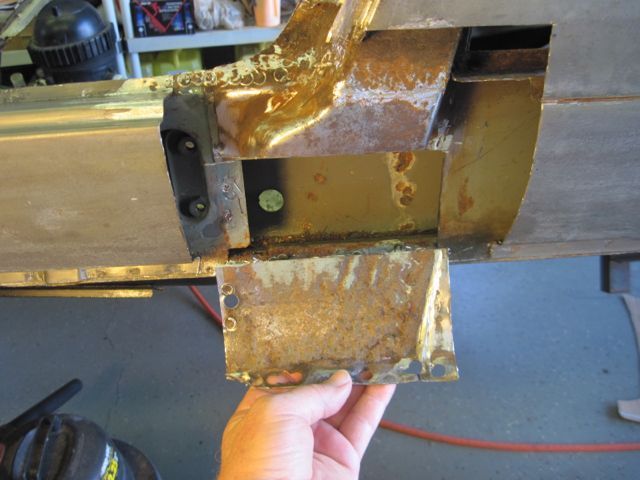
Notice here the mid rocker is made in sections. I did not know this, and just happened to uncover a place where the lap weld is. Good to see the rust is only behind the B pillar.
This is the floor pan, just under and forward of where I am working. I spotted this damage earlier, and painted around it, knowing I would have to cut it out:
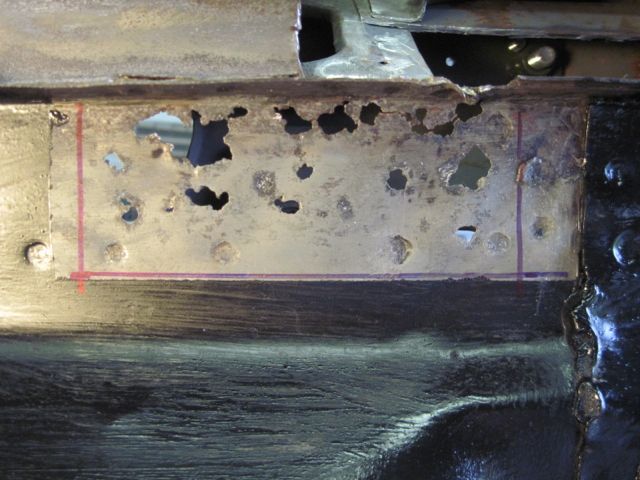
Cutting this away reveals the flange of the inner rocker rusted away too. I had to cut this out a little bit beyond what can be seen in this picture, to get back to solid metal.
I made a repair piece and welded it in, but did not get a picture of it.
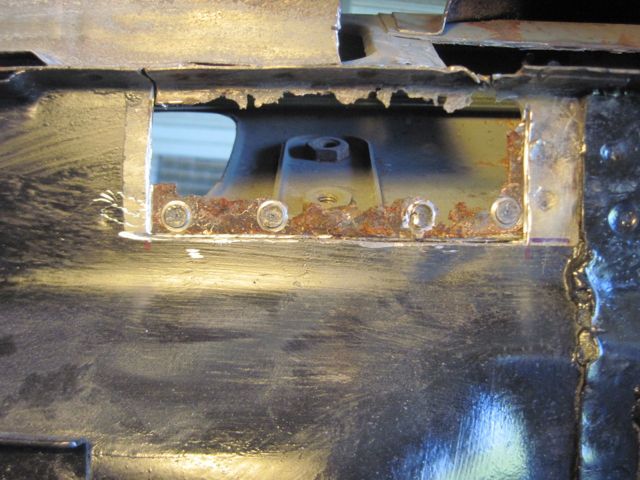
Next to weld in a piece of 22 gauge to fill in the floor pan here.

Now I have all the rust cut out, and some of the pieces replaced. I mask the edges where I know I have more welding to do. Then I spray zinc primer inside, as I will not be able to it after this next patch:
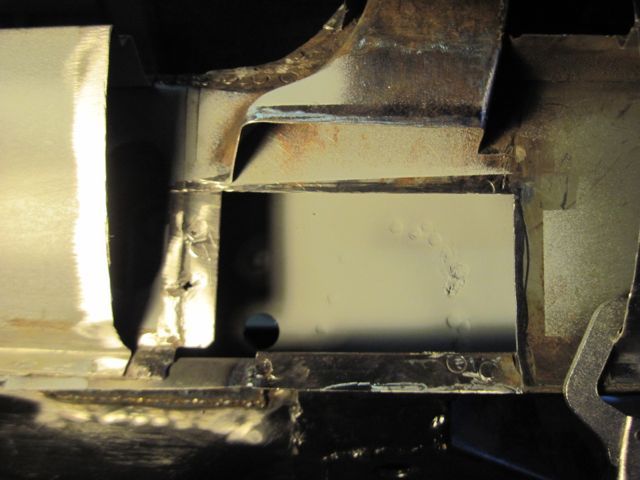
This patch of 16 gauge steel was not too hard to make:
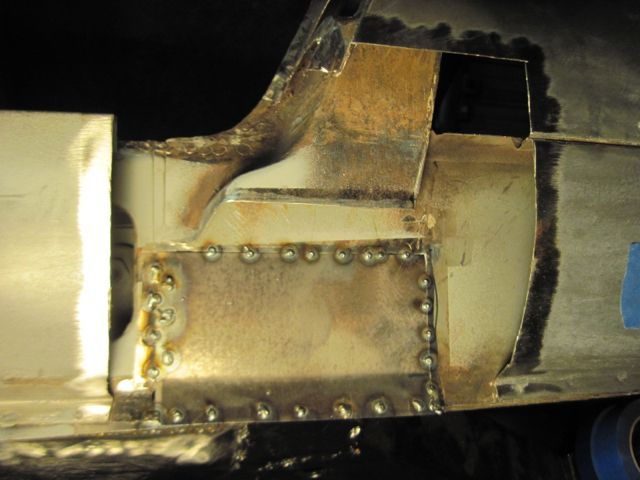
Next episode; I’ll make the B pillar structural repair, and start on some of the more cosmetic bits. Stay tuned.



I’ll use some masking tape to section off the damaged parts, with attention to locate the spot welds and drains:




I may be able to save some of this outer rocker panel piece, but not what I find under it:



Now I have scuffed off the worst of the rust scale. I find what seems to be a good place to cut away the bottom of the B pillar:


This WAS 16 gauge steel:

So was this - the mid rocker:


Notice here the mid rocker is made in sections. I did not know this, and just happened to uncover a place where the lap weld is. Good to see the rust is only behind the B pillar.
This is the floor pan, just under and forward of where I am working. I spotted this damage earlier, and painted around it, knowing I would have to cut it out:

Cutting this away reveals the flange of the inner rocker rusted away too. I had to cut this out a little bit beyond what can be seen in this picture, to get back to solid metal.
I made a repair piece and welded it in, but did not get a picture of it.

Next to weld in a piece of 22 gauge to fill in the floor pan here.

Now I have all the rust cut out, and some of the pieces replaced. I mask the edges where I know I have more welding to do. Then I spray zinc primer inside, as I will not be able to it after this next patch:

This patch of 16 gauge steel was not too hard to make:

Next episode; I’ll make the B pillar structural repair, and start on some of the more cosmetic bits. Stay tuned.
Thank you for posting how you are doing your restoration work, especially the photos. It is very instructive and helpful! I wish I had your talent and patience.
Jack
Jack
Rodney -
You must cry everytime you cut a piece away, and find 2-3 more places to fix... Or maybe you are expecting it....
Keep up the great work!
Rocky
You must cry everytime you cut a piece away, and find 2-3 more places to fix... Or maybe you are expecting it....
Keep up the great work!
Rocky
Pretty much expecting it by now Rocky. Some of the damage is obvious, and some leaves tell tale clues for me to find. What is cry - worthy is how much time it takes.
Jack, the patience I guess I was born with. The "talent" is just a matter of starting with the easier jobs and working up to the harder ones.
Oh, and lest I forget, a big part of "talent" is reading most everything that appears on this forum, and studying the work of Rob, Rick, Rocky, David, George, Comp2, Goran, Jack, JT, Johnny, Marlin, Larry; too many to name them all. A whole bunch of skill, talent, experience, and imagination is at your fingertips here.
Jack, the patience I guess I was born with. The "talent" is just a matter of starting with the easier jobs and working up to the harder ones.
Oh, and lest I forget, a big part of "talent" is reading most everything that appears on this forum, and studying the work of Rob, Rick, Rocky, David, George, Comp2, Goran, Jack, JT, Johnny, Marlin, Larry; too many to name them all. A whole bunch of skill, talent, experience, and imagination is at your fingertips here.
On the structural parts that are not cosmetic (will not be seen when finished), I do not worry too much about making it look pretty or original. I have also learned that trying to make multiple bends in a repair piece is a good way to end up with scrap metal. Now I keep the pieces as simple as possible, and make more complex pieces by welding simple pieces together.
Here is a template for this repair using just masking tape:
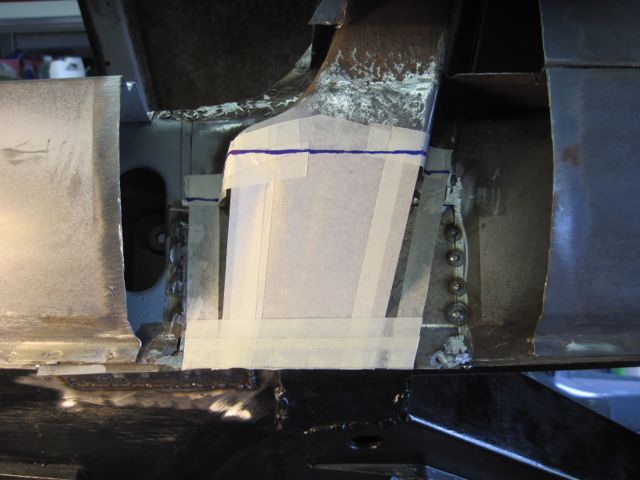
Next I remove the template and use it to rough cut the repair pieces. Meanwhile, I mask off the welding zones, and spray in more primer:

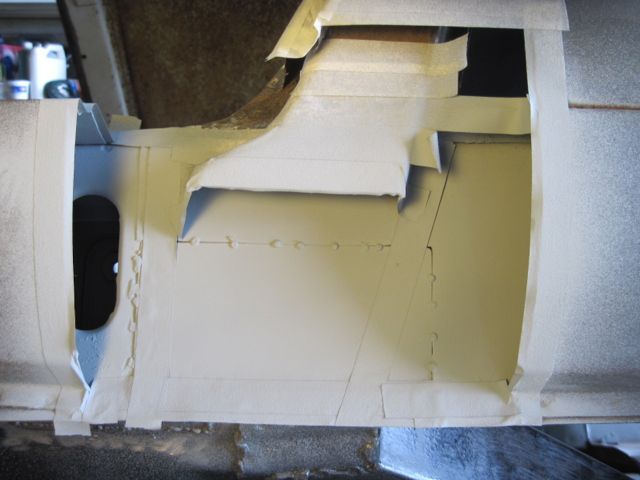
This repair is done in 3 pieces; a flat panel with two wedge shaped bits on either side:
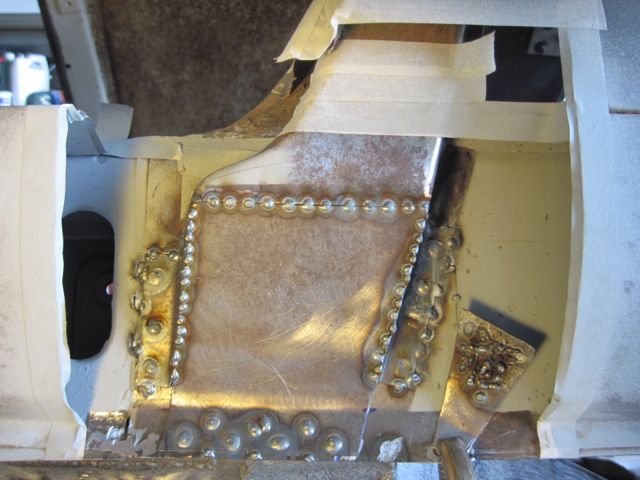
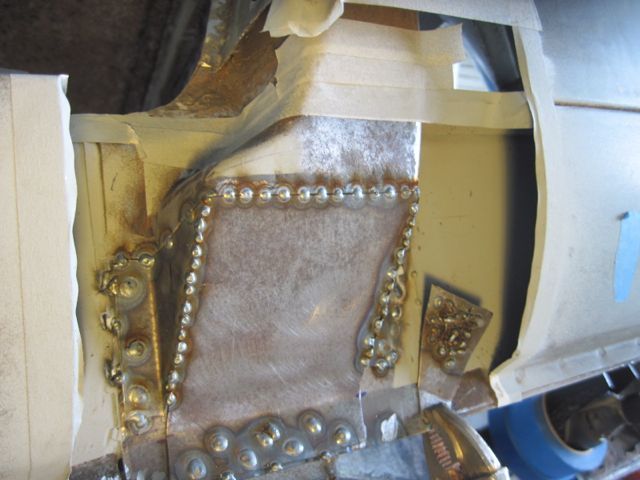
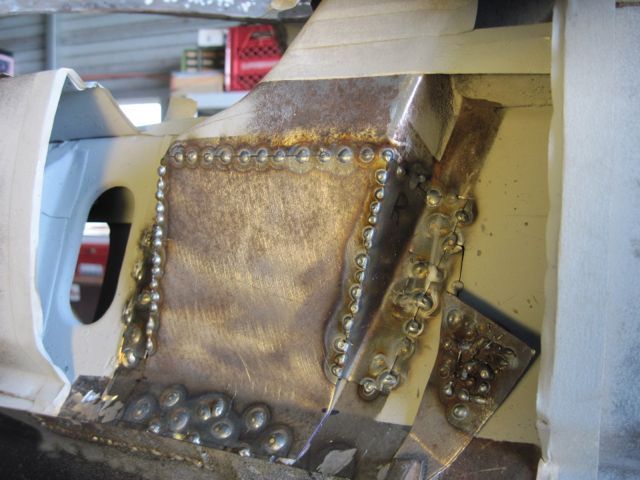
A little welding tip: that ugly bit of scrap metal clamped nearby is what I call my arc strike target. It serves two functions. The first arc strike or two with a MIG are usually not good. The wire is cold and the gas is not flowing. I use a scrap of the same gauge of metal I am about to weld. A few test strikes there gets the wire hot, the gas flowing, and makes sure my set up is right before I move on to the real work.
Again I mask and spray primer after the repair pieces are welded in place:

A few inches rearward, there were some rust through spots here, where the rear quarter meets the outer rocker. I cut out the rusty part, made a patch piece, drilled through a couple of new drain holes (not visible in this pic), and welded in the patch:
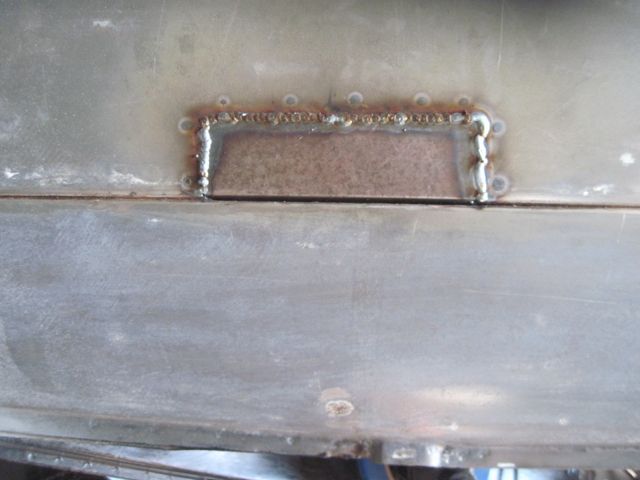
And after some clean up work:
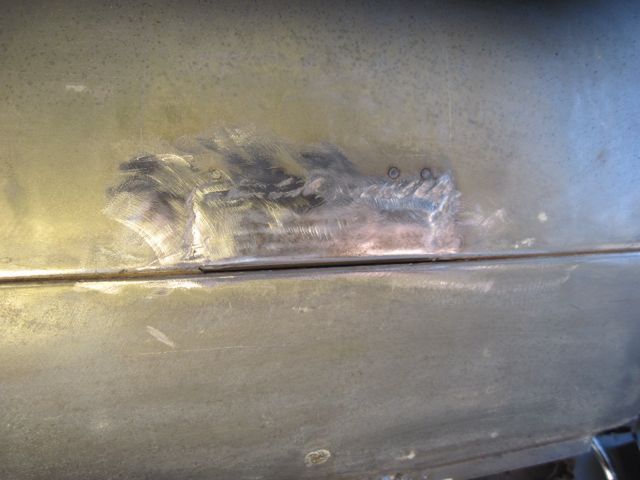
This is a good example of how hard it is to get the contours and bends exactly right. Just off by a tiny bit, and it is plainly visible. Later, after the first coat of epoxy primer, I’ll smear a bead of epoxy (like JB Weld) into this crease, and after it sets up, I’ll burnish it smooth to match the original contours.
Tune in again for my next episode; I’ll wrap up the repairs to this area.
Here is a template for this repair using just masking tape:

Next I remove the template and use it to rough cut the repair pieces. Meanwhile, I mask off the welding zones, and spray in more primer:


This repair is done in 3 pieces; a flat panel with two wedge shaped bits on either side:



A little welding tip: that ugly bit of scrap metal clamped nearby is what I call my arc strike target. It serves two functions. The first arc strike or two with a MIG are usually not good. The wire is cold and the gas is not flowing. I use a scrap of the same gauge of metal I am about to weld. A few test strikes there gets the wire hot, the gas flowing, and makes sure my set up is right before I move on to the real work.
Again I mask and spray primer after the repair pieces are welded in place:

A few inches rearward, there were some rust through spots here, where the rear quarter meets the outer rocker. I cut out the rusty part, made a patch piece, drilled through a couple of new drain holes (not visible in this pic), and welded in the patch:

And after some clean up work:

This is a good example of how hard it is to get the contours and bends exactly right. Just off by a tiny bit, and it is plainly visible. Later, after the first coat of epoxy primer, I’ll smear a bead of epoxy (like JB Weld) into this crease, and after it sets up, I’ll burnish it smooth to match the original contours.
Tune in again for my next episode; I’ll wrap up the repairs to this area.
This area was badly rusted out, and after taking it apart, it is easy to see why. I’ve cut away the top part of the outer rocker here (what was left of it). It used to extend all the way back to the B pillar, where just a notch was cut out of it, and it continued rearward. The door striker cosmetic panel was curved down and forward, lapped over, and welded to the rocker / door sill about where my cut line is in these photos. This formed a wedge shaped little cavity just perfect for trapping all sorts of dirt, trash and water in there.
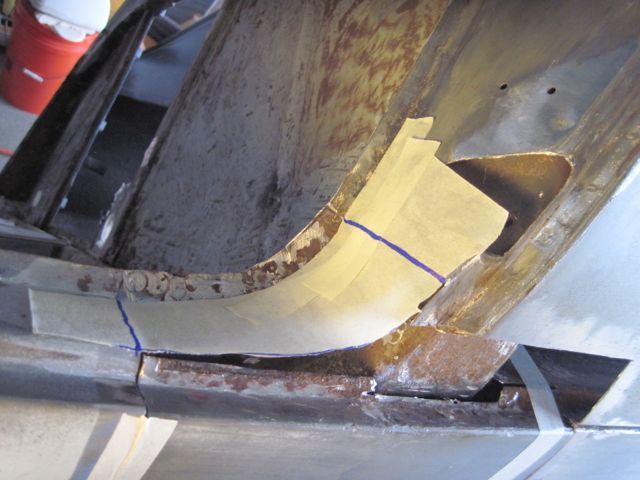
The masking tape helps me rough out the shape of the patch needed:

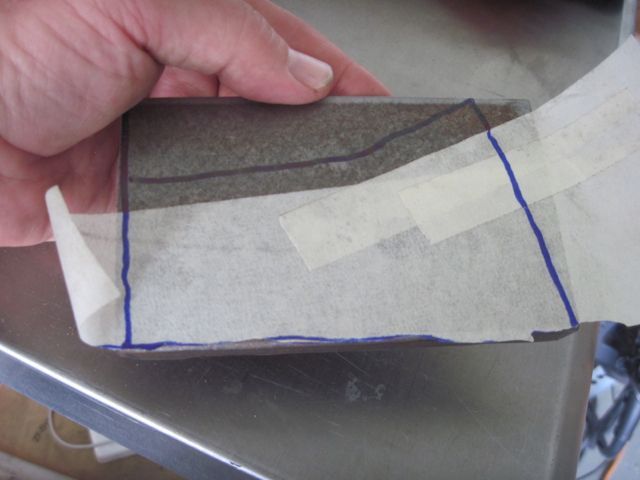
Here is the rough cut:
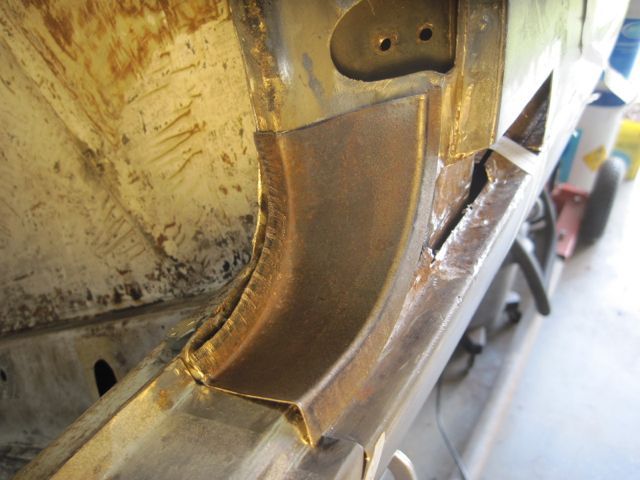
After some trimming and contouring:
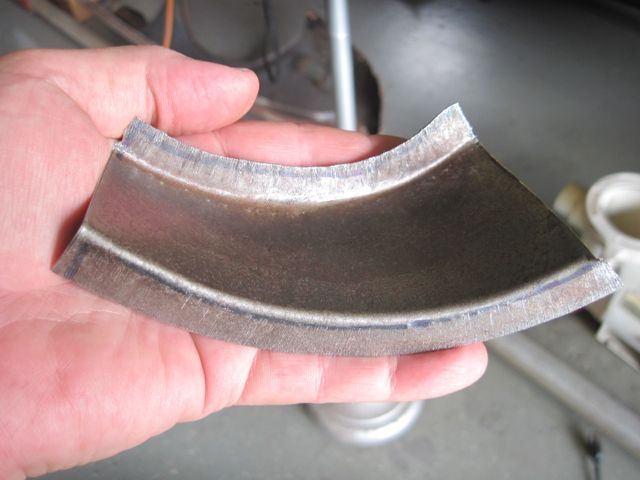
I decided to use backer strips on this one, so I do not have to get it so perfect:
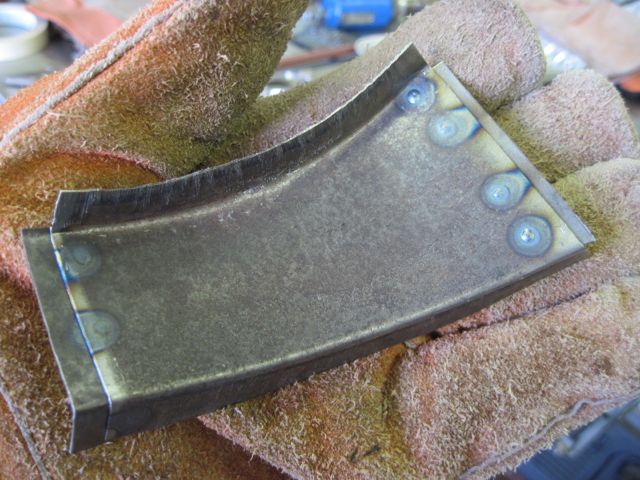
Test fitting looks good so far:
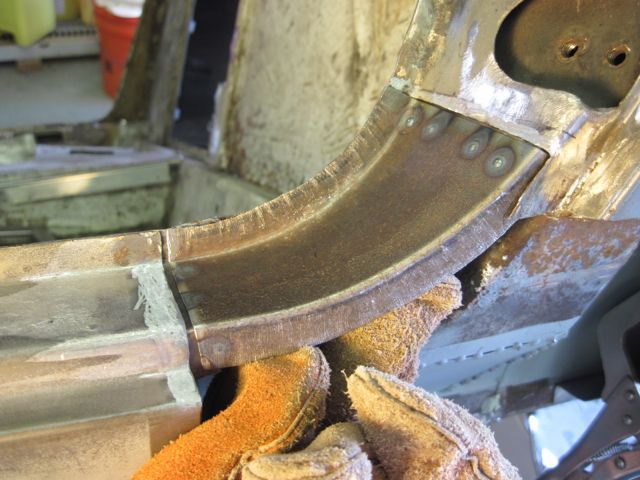
Clamping it in place to be sure it fits up right:
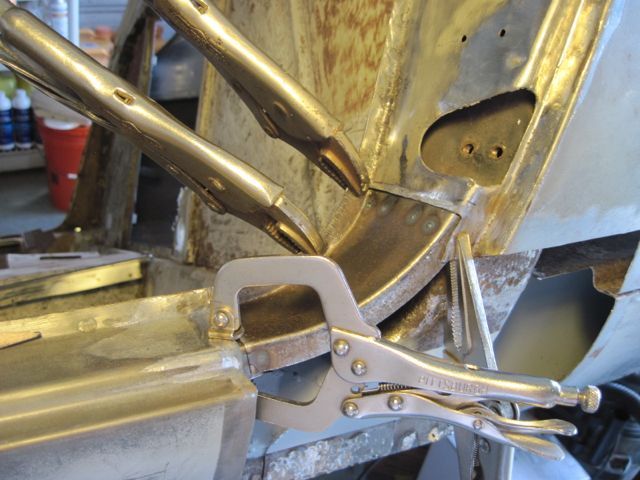
Next I have to make up pieces to patch the quarter panel and the top flange of the outer rocker:
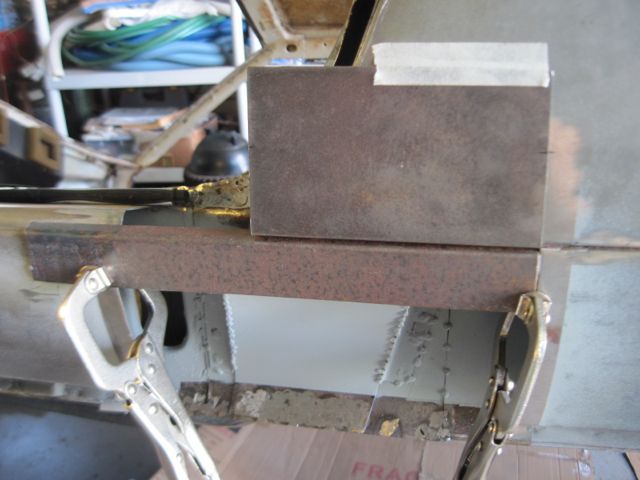
The bottom of the outer rocker piece had some rust through holes too, so I made a patch for it:
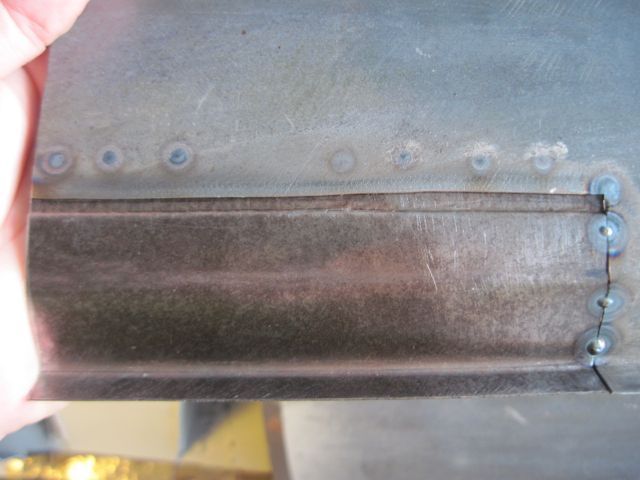
Here I am just test fitting the repaired piece:
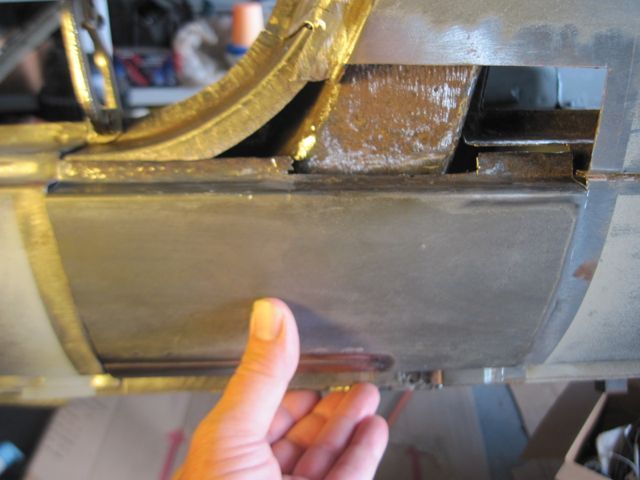
And the other repair pieces are taking shape:
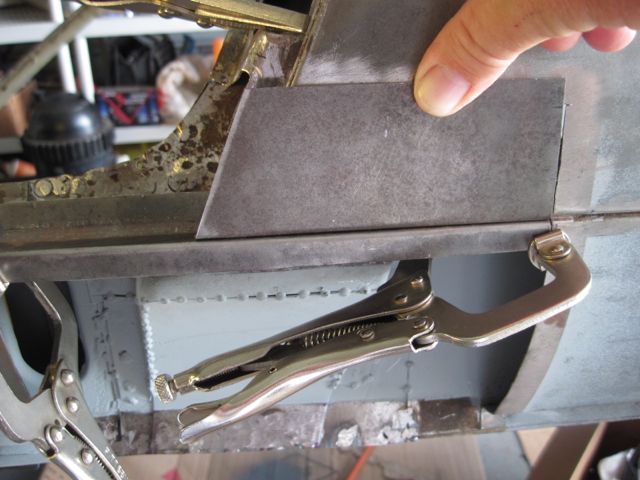
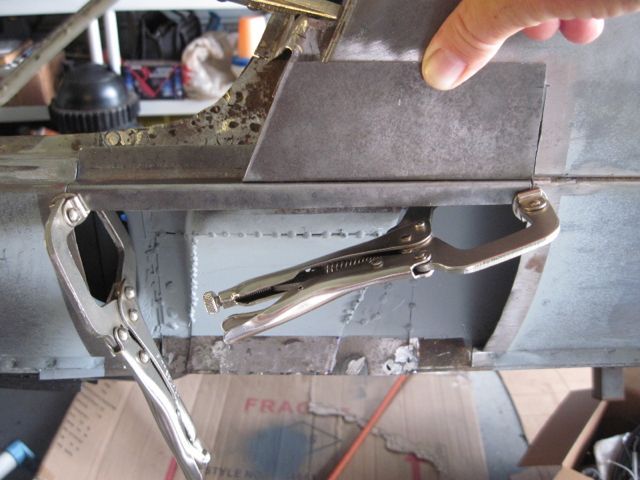
More test fitting:
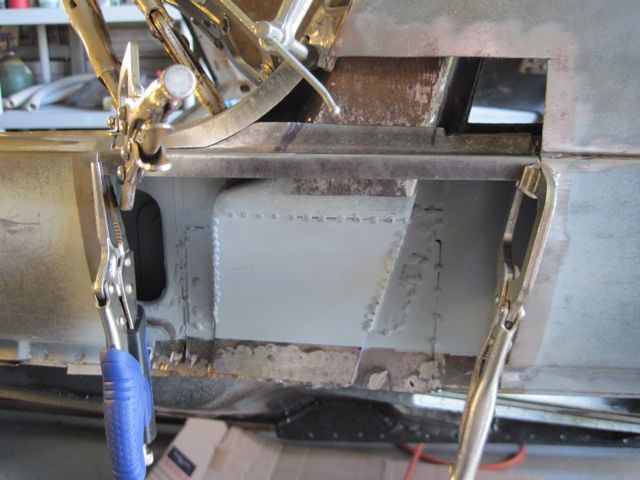
I flanged the top of this piece:

This little piece is needed to fill in a gap:
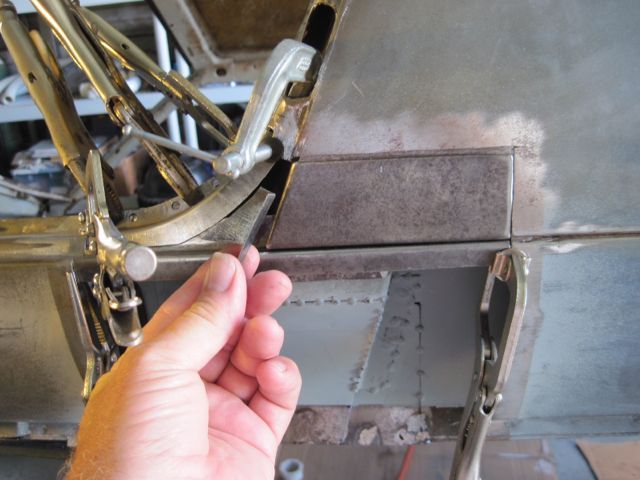
One last test fit with all the pieces in place:

Now to start welding:
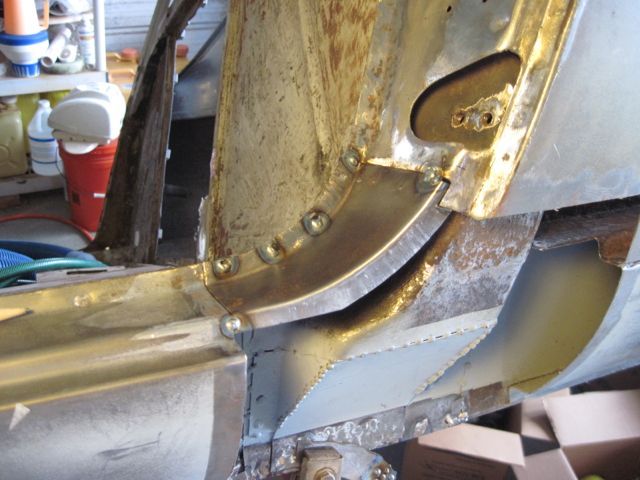

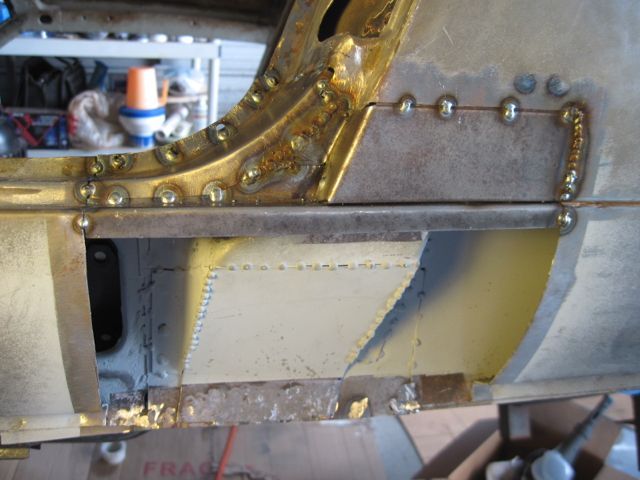
One of the challenging questions is which piece to do last. It is easy to paint yourself into a corner, so to speak:
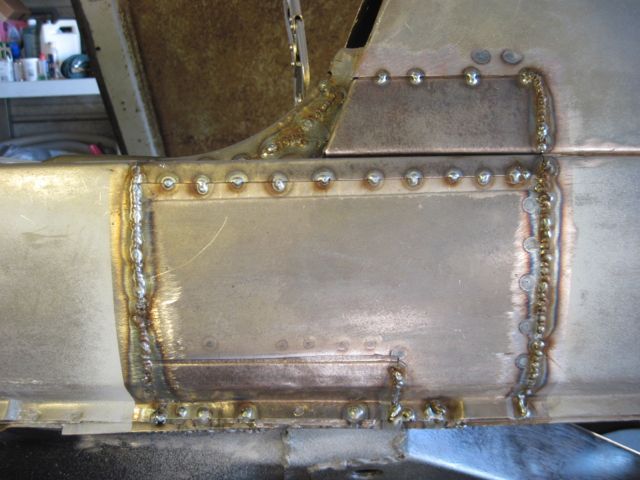
I do not have a pic of the repair after clean up. I’ll try to remember to take one. It looks better than this.
Tune in again for my next episode; the infamous rear wheel house repairs!

The masking tape helps me rough out the shape of the patch needed:


Here is the rough cut:

After some trimming and contouring:

I decided to use backer strips on this one, so I do not have to get it so perfect:

Test fitting looks good so far:

Clamping it in place to be sure it fits up right:

Next I have to make up pieces to patch the quarter panel and the top flange of the outer rocker:

The bottom of the outer rocker piece had some rust through holes too, so I made a patch for it:

Here I am just test fitting the repaired piece:

And the other repair pieces are taking shape:


More test fitting:

I flanged the top of this piece:

This little piece is needed to fill in a gap:

One last test fit with all the pieces in place:

Now to start welding:



One of the challenging questions is which piece to do last. It is easy to paint yourself into a corner, so to speak:

I do not have a pic of the repair after clean up. I’ll try to remember to take one. It looks better than this.
Tune in again for my next episode; the infamous rear wheel house repairs!
If your doing that kind of work to the doors, it wouldn't hurt to put the door on and check fit. I cut the door jam on mine and pulled it out fitting new metal to make the doors fit better:



I also welded music wire to the fender to tighten the gap making a real nice fit:





I also welded music wire to the fender to tighten the gap making a real nice fit:


Yes, I will be doing that; thanks for posting your work on this. I remember reading it at the time.
I'm waiting on a new set of striker - receivers, so I will get back to this task when they arrive. I also had to buy new doors; mine were rusted beyond saving, so I will have quite a lot of "fitting" to do.
Question for you - did yours fit this badly? I remember this area was heavily leaded up when I took it apart.
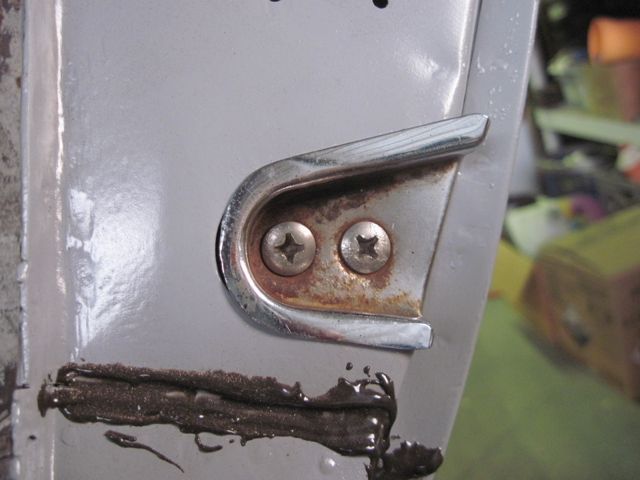

I'm waiting on a new set of striker - receivers, so I will get back to this task when they arrive. I also had to buy new doors; mine were rusted beyond saving, so I will have quite a lot of "fitting" to do.
Question for you - did yours fit this badly? I remember this area was heavily leaded up when I took it apart.


The fit was sloppy with lots of lead and lots of gaps. It's just the way they were. Many don't address it during restoration and it shows.
Looking good Rodney. Making crazy progess man.
How did you get the curve in that piece? It looks perfect. Curious how you stretched and shrank the flanges to get such a nice finished piece.
Steve
Steve
Funny you should ask, Steve. I bought the stretcher and shrinker tools from HFT. In the pic where I have the masking tape on the flat piece of metal, the outer flange has already been bent, so not easy to see in that pic. The inner flange is sketched on in marker. It is only 22 gauge, so it cuts and bends easily. I just bend the flanges to about 90* on the piece, then shrink the inside flange and stretch the outside one till the curve fits like I want it. Then trim off the excess if necessary.
This is pretty much a text book example of rear wheelhouse structural rust. I used a panel nibbler to cut upward just to find where the rust ends, and I have sketched some marks about where I think I need to go.
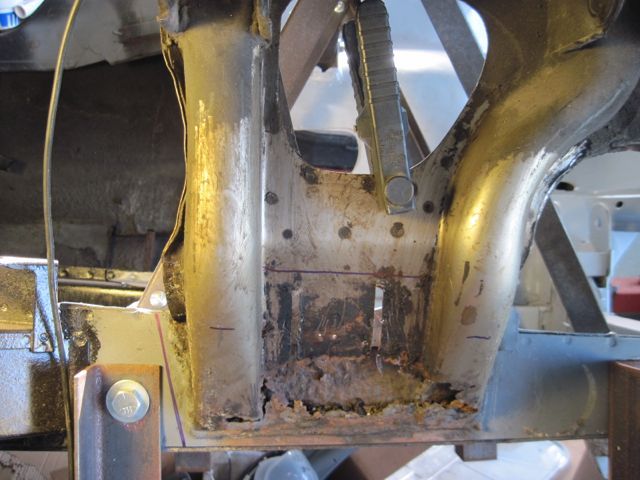
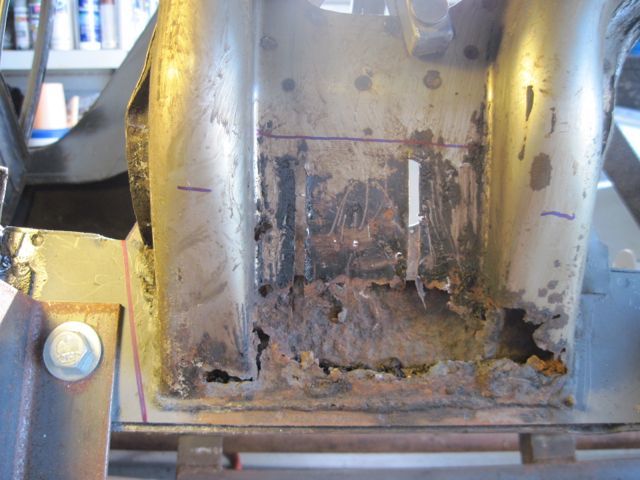
I used the plasma cutter here, since I could see this was trashed pretty much through and through. A little collateral damage is no big deal.
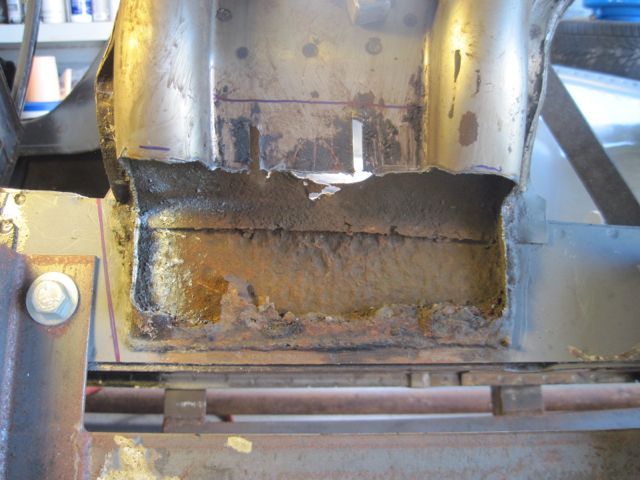
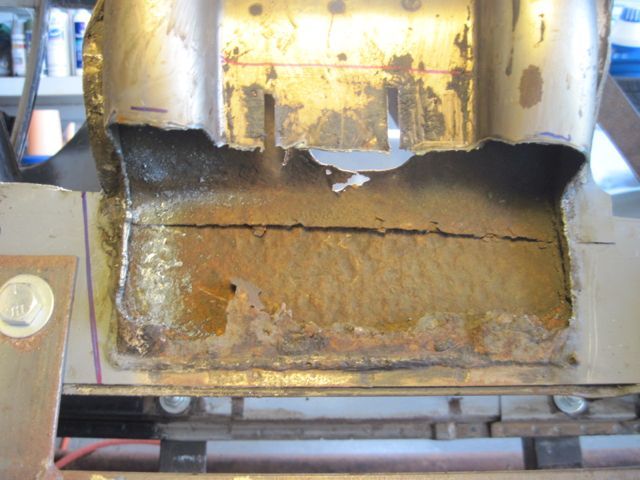
This is kind of strange, how this is put together. The light gauge inner panel must have been welded to the heavier outer stamping, then the subassembly welded to the frame rail. The outside panel of the frame rail is rusted and has to be replaced, but I have to cut away the inner panel just to get at the top welds. Not an issue in this case, since the inner panel is rusted also. If the inner panel were undamaged, I would still have to cut it away to fix this.
Before I start cutting this all apart, I made an “A” frame support to keep the rear end pieces in position. It connects the rear most suspension points to the bay brace, and to the fixed cross member just above the forward mounting points. I thought I had a better picture of it, and I’ll put one up later if I can find it.
Here you can see part of it, while I prepare to cut off the inner panel just below the obround hole:
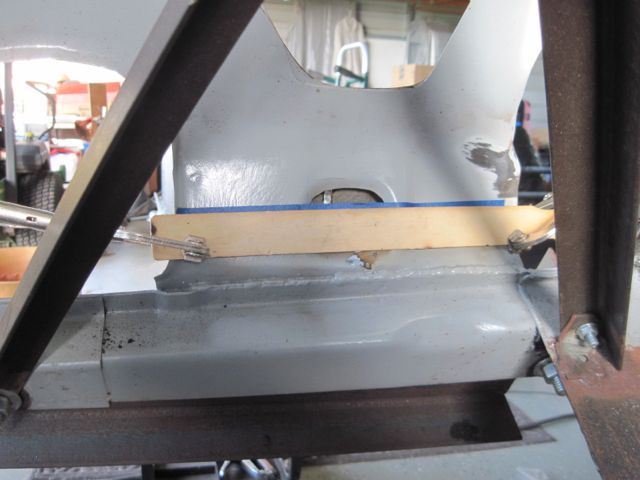
With that out of the way, I can cut the spot welds and slice the outer frame rail panel to cut out the rusty section and the old welds all at once. I used a cutting wheel for this, since I don’t know for sure what is inside:
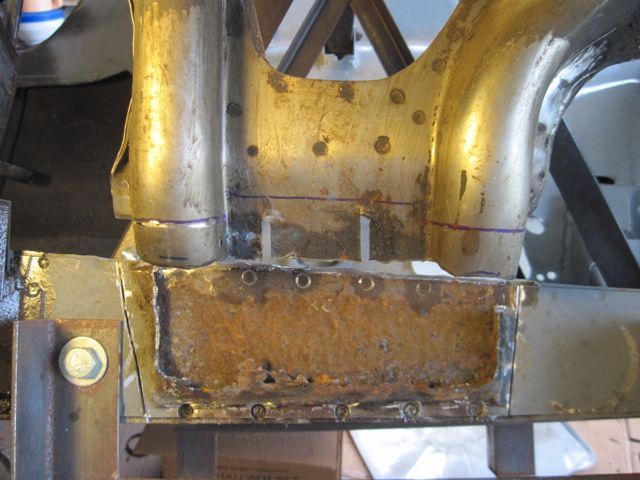
I also cut the wheelhouse again, up higher, because the rust damage went up farther than I thought. Using the cutting wheel gives me a clean straight edge to work with:
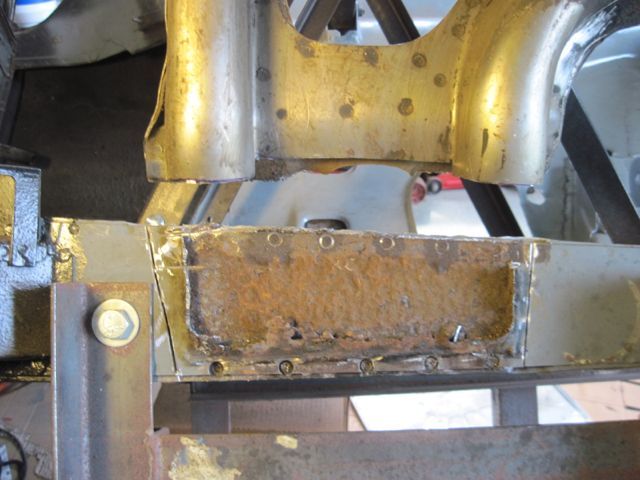
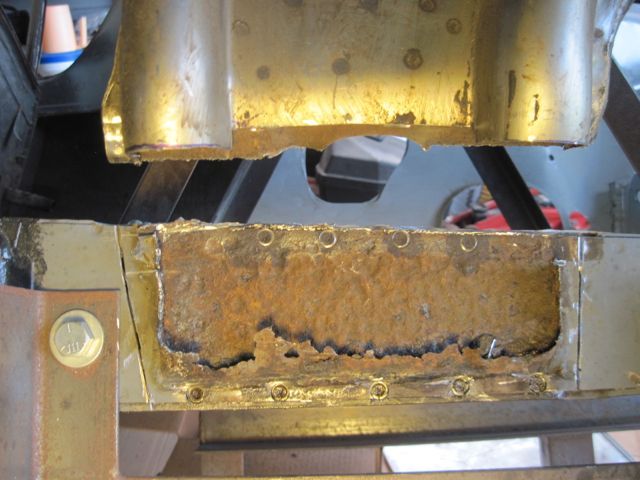
Finally it comes off:
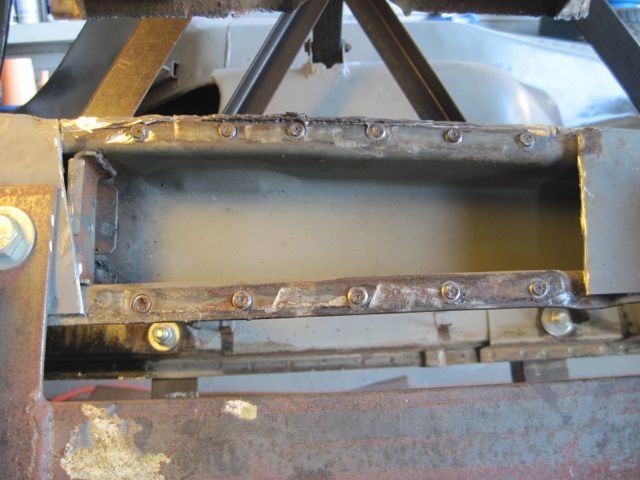
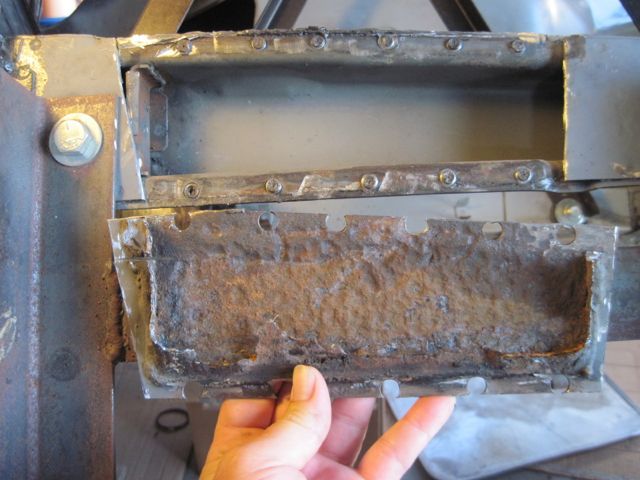
Thankfully, clean and nearly rust free on the inside:
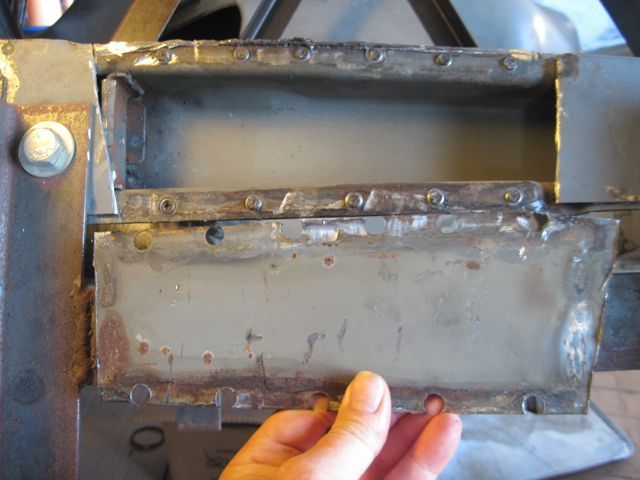
Here is the frame stiffener inside, next to the mount points. This is why I don’t use the plasma cutter when I don’t know what is in there; I could have destroyed this piece:

I decided to move my emergency brake assembly rearward, to make the cables shorter. This is where it ended up, and I’m welding some nuts on the inside to make for a stronger mount. If you stay with the stock arrangement, you do not have to do this:
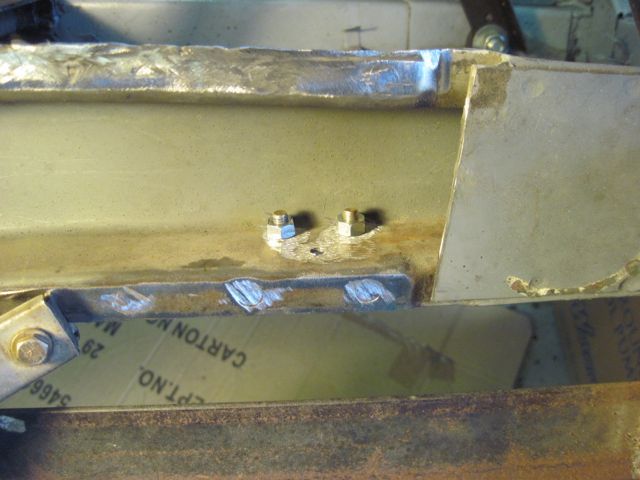
With the area cleaned up, I spray in some zinc primer:

Next episode, I’ll dig into making the repair pieces.


I used the plasma cutter here, since I could see this was trashed pretty much through and through. A little collateral damage is no big deal.


This is kind of strange, how this is put together. The light gauge inner panel must have been welded to the heavier outer stamping, then the subassembly welded to the frame rail. The outside panel of the frame rail is rusted and has to be replaced, but I have to cut away the inner panel just to get at the top welds. Not an issue in this case, since the inner panel is rusted also. If the inner panel were undamaged, I would still have to cut it away to fix this.
Before I start cutting this all apart, I made an “A” frame support to keep the rear end pieces in position. It connects the rear most suspension points to the bay brace, and to the fixed cross member just above the forward mounting points. I thought I had a better picture of it, and I’ll put one up later if I can find it.
Here you can see part of it, while I prepare to cut off the inner panel just below the obround hole:

With that out of the way, I can cut the spot welds and slice the outer frame rail panel to cut out the rusty section and the old welds all at once. I used a cutting wheel for this, since I don’t know for sure what is inside:

I also cut the wheelhouse again, up higher, because the rust damage went up farther than I thought. Using the cutting wheel gives me a clean straight edge to work with:


Finally it comes off:


Thankfully, clean and nearly rust free on the inside:

Here is the frame stiffener inside, next to the mount points. This is why I don’t use the plasma cutter when I don’t know what is in there; I could have destroyed this piece:

I decided to move my emergency brake assembly rearward, to make the cables shorter. This is where it ended up, and I’m welding some nuts on the inside to make for a stronger mount. If you stay with the stock arrangement, you do not have to do this:

With the area cleaned up, I spray in some zinc primer:

Next episode, I’ll dig into making the repair pieces.
Here, I found the pics I was looking for.
First are a couple I took while taking the rear suspension off. The undercoating hides the extent of the rust damage:
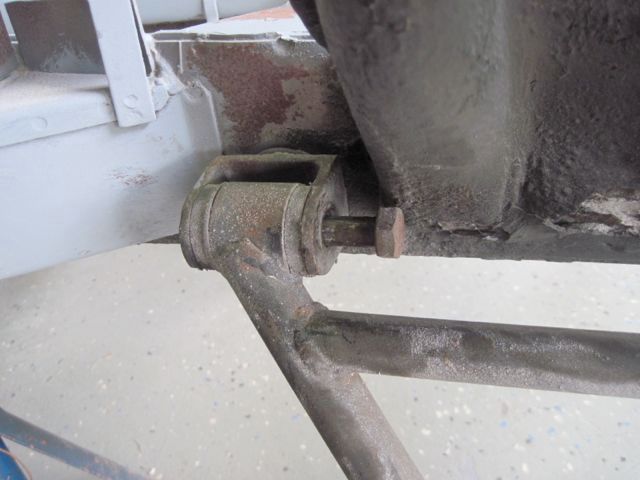

That is not why I took the photos. See how little clearance there is for that bolt head? It cannot be put in the other way, because the motor mount structure is there. I must be sure to leave enough clearance to get this bolt in and out, when I rebuild this part.
Here is the brace I made to hold the rear end pieces in position while I do the repairs:

First are a couple I took while taking the rear suspension off. The undercoating hides the extent of the rust damage:


That is not why I took the photos. See how little clearance there is for that bolt head? It cannot be put in the other way, because the motor mount structure is there. I must be sure to leave enough clearance to get this bolt in and out, when I rebuild this part.
Here is the brace I made to hold the rear end pieces in position while I do the repairs:

This pic shows a technique I came up with to make models of complex pieces. On simple pieces, cardboard and / or tape works ok; I often use breakfast cereal boxes. On curved pieces it does not conform easily nor hold the shape. I tried aluminum foil, but it is too delicate. This is aluminum too, but heavier. I save “disposable” cooking pans from the kitchen, clean them out, and cut out the bottom of the pan. After smoothing and flattening the material, it works great for mocking up parts like this.
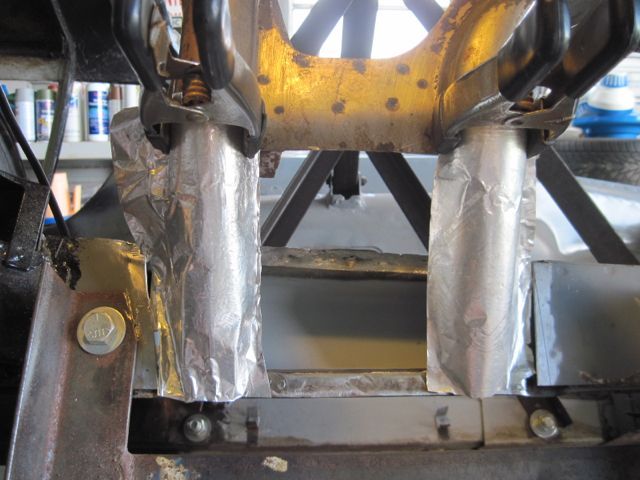
Earlier, JT asked me about the gauge of steel needed. This is one of the 18 gauge pieces I had to order. I could have used 16 I suppose, but it would have made for some uneven steps I had to weld across. Probably not too important, but thought you would like to know.
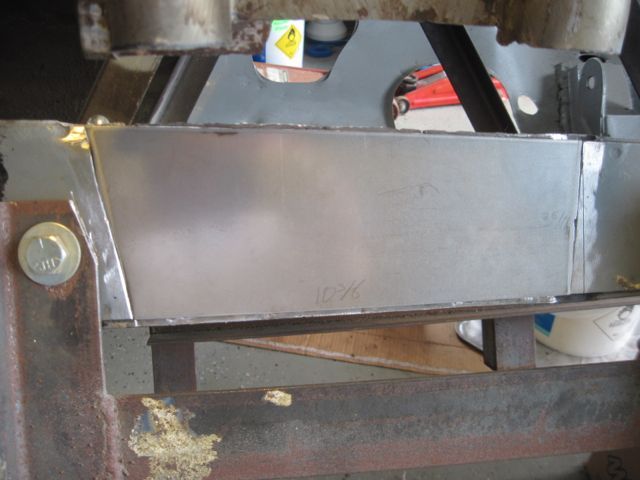
I had to cut away the inner wheelhouse panel here, which left me with a choice; do I reproduce the obround hole, or eliminate it. I decided to eliminate it. The rear most part of this panel is nearly flat, but the front part is concave, so I made it in two pieces:

Here I have cleaned up the weld zones, added a hole to allow rust proofing to be put in, and sprayed in some zinc primer:
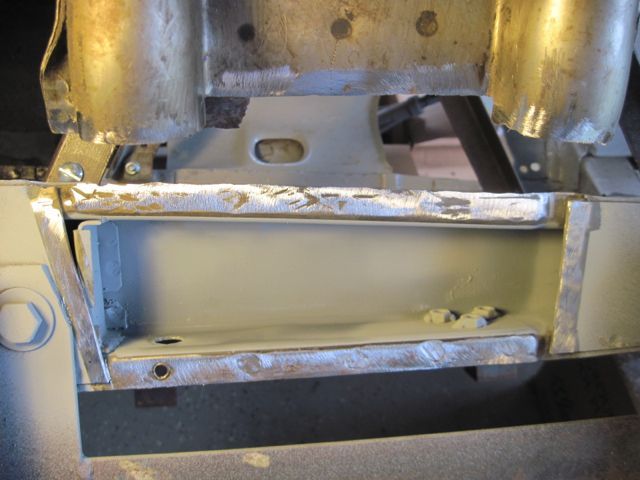
On this frame rail repair piece, I decided to scallop the top to make places to weld. I just wanted less post weld clean up to do, since I have more pieces to weld in this same area:

Now tacked in place:

Here I am starting to weld in the inner panel repairs. This is 22 gauge, and I am welding it from the inside so it looks better on the visible side:
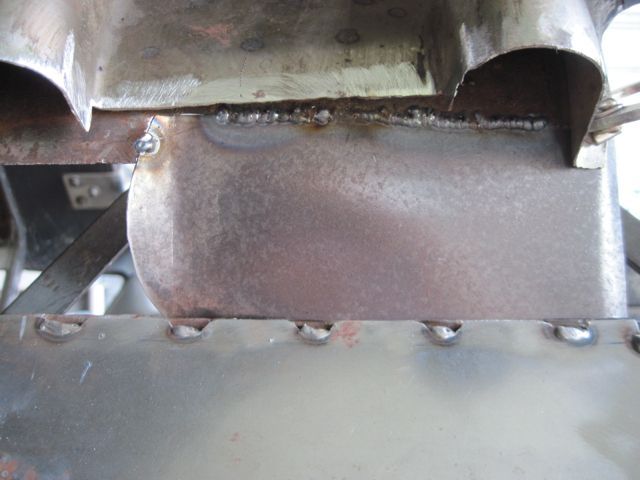
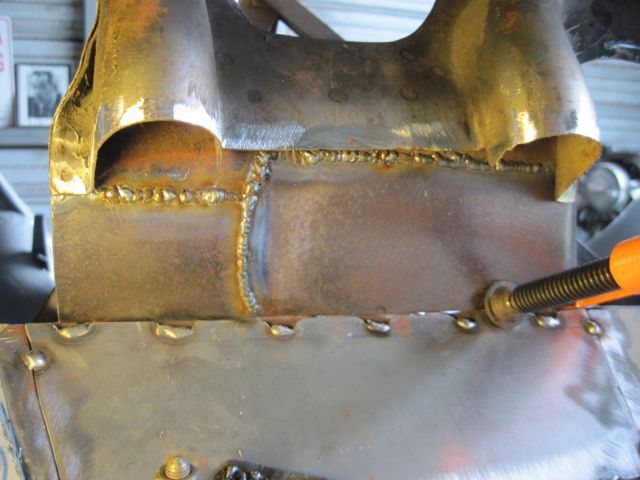
I had to weld from this side down where it joins the frame rail, but the upper seam came out quite nice:

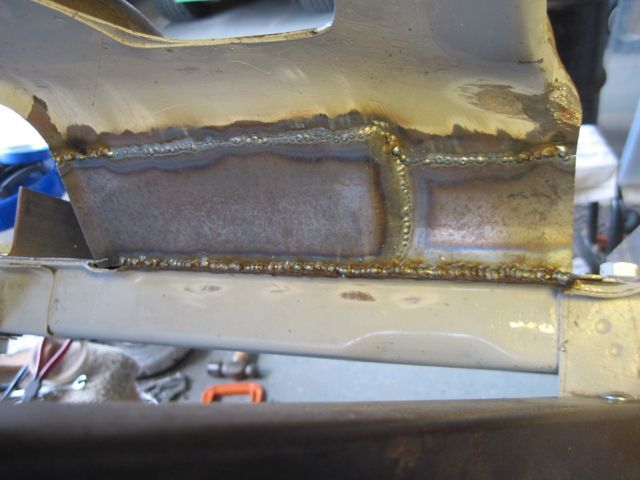
Now to mask off the weld zones, and spray some primer in there:

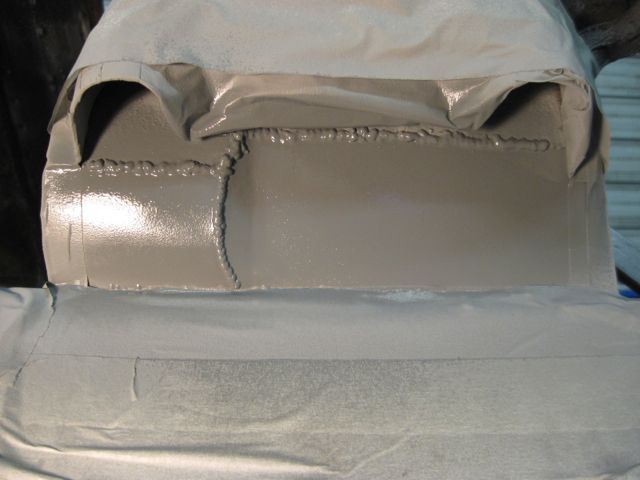
I decided to make the structural repair in 3 pieces. With the simple workshop tools I have, it is just too hard to make all of these bends and get them just right. This is 16 gauge steel, and I have already tacked in the flat center piece:
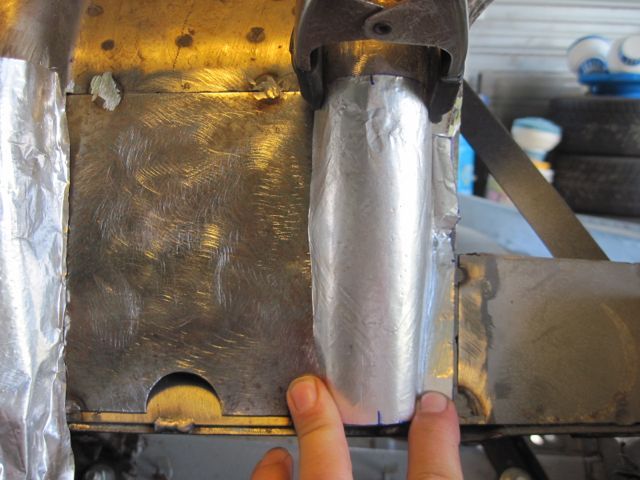
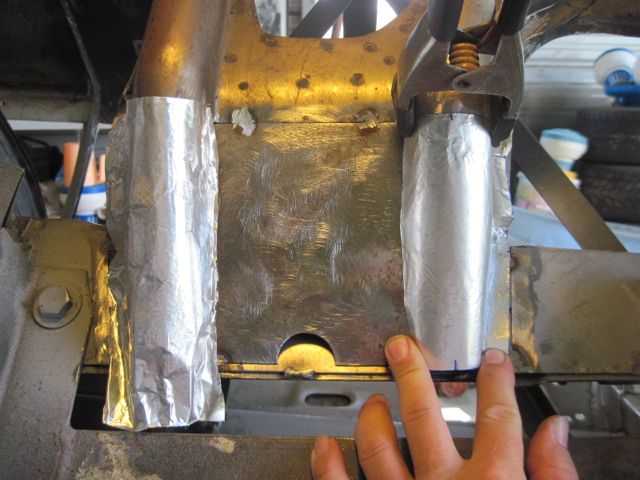
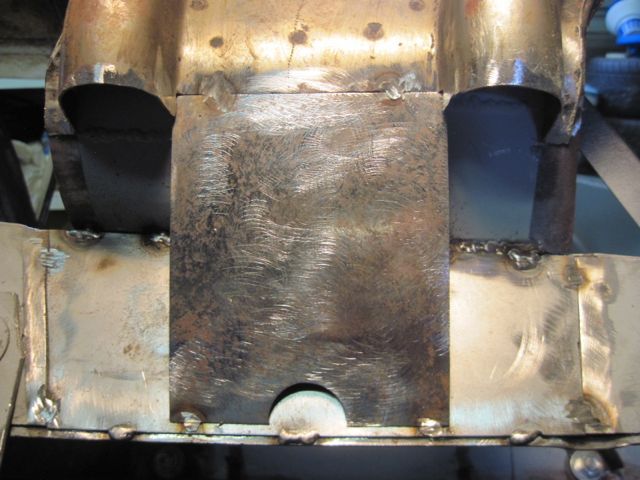
This is my first try at this. Getting it round at the top and kind of rectangular at the bottom was a PAIN.
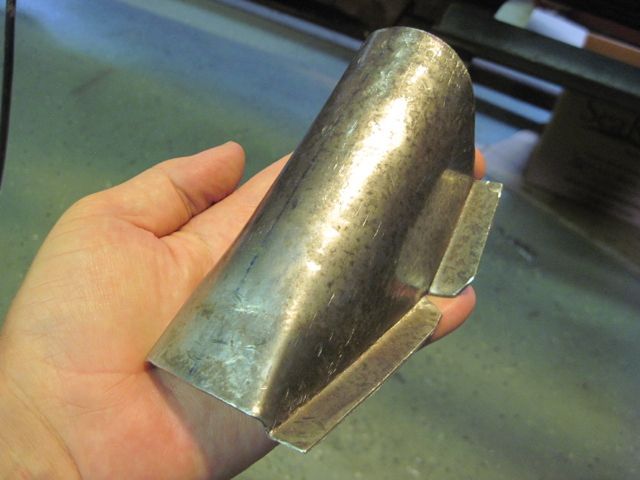
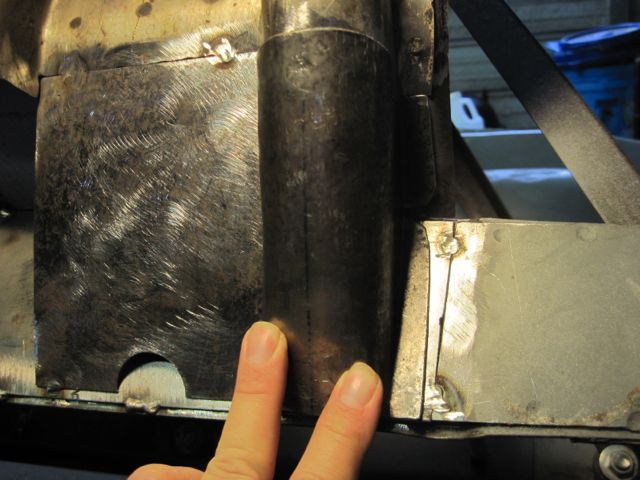
I decided to do away with the side flanges; I just could not get them right. I “T” welded the pieces instead. Here it is just about done with welding:
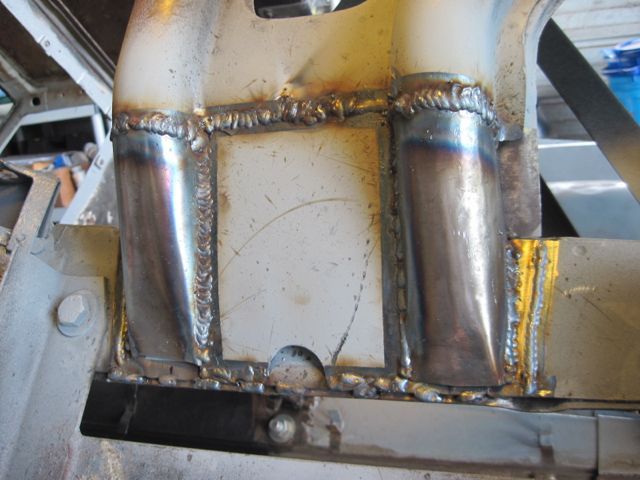
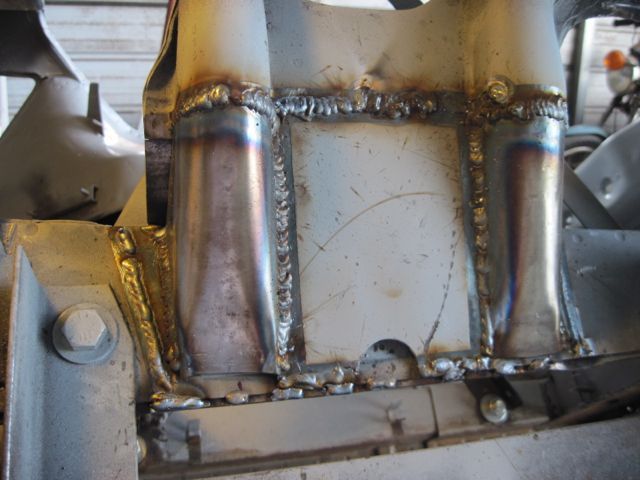
And after several coats of zinc primer, I’ll declare victory and move on:
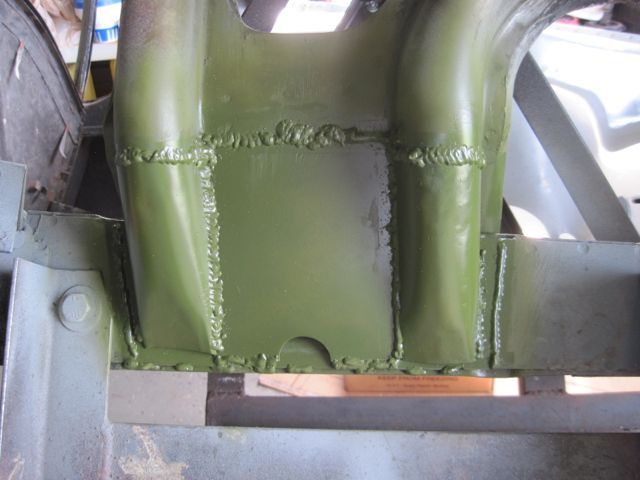
Not sure what I will go after next; tune in again to find out!

Earlier, JT asked me about the gauge of steel needed. This is one of the 18 gauge pieces I had to order. I could have used 16 I suppose, but it would have made for some uneven steps I had to weld across. Probably not too important, but thought you would like to know.

I had to cut away the inner wheelhouse panel here, which left me with a choice; do I reproduce the obround hole, or eliminate it. I decided to eliminate it. The rear most part of this panel is nearly flat, but the front part is concave, so I made it in two pieces:

Here I have cleaned up the weld zones, added a hole to allow rust proofing to be put in, and sprayed in some zinc primer:

On this frame rail repair piece, I decided to scallop the top to make places to weld. I just wanted less post weld clean up to do, since I have more pieces to weld in this same area:

Now tacked in place:

Here I am starting to weld in the inner panel repairs. This is 22 gauge, and I am welding it from the inside so it looks better on the visible side:


I had to weld from this side down where it joins the frame rail, but the upper seam came out quite nice:


Now to mask off the weld zones, and spray some primer in there:


I decided to make the structural repair in 3 pieces. With the simple workshop tools I have, it is just too hard to make all of these bends and get them just right. This is 16 gauge steel, and I have already tacked in the flat center piece:



This is my first try at this. Getting it round at the top and kind of rectangular at the bottom was a PAIN.


I decided to do away with the side flanges; I just could not get them right. I “T” welded the pieces instead. Here it is just about done with welding:


And after several coats of zinc primer, I’ll declare victory and move on:

Not sure what I will go after next; tune in again to find out!
Best thread on the forum! Great progress!
Thanks Garth. Did you get your block fixed after it inhaled the air cleaner screw?
It seems that photo bucket has messed up my pic links. Dang, as if I don't have enough stuff to fix.
It seems that photo bucket has messed up my pic links. Dang, as if I don't have enough stuff to fix.
It seems like it's back now.
It had messed with everyone....
PS - Did you see how Peter Fenlon had built his uprights? He and his "tinbender" did a great job...
Scroll Down for #3840 Upright Repair
It had messed with everyone....
PS - Did you see how Peter Fenlon had built his uprights? He and his "tinbender" did a great job...
Scroll Down for #3840 Upright Repair
No, I had not seen Peter's work. He did a great job. Wish I had thought of that. I also have to fix the rear crossmember, bent from jacking.
Photos seem to be linking correctly now, but I still have hundreds of error messages from photo bucket; they look like sticky notes on the background of my browser display, making it hard to read anything other than the thread.
It's late and I have to get to bed, work tomorrow. Hope this will be cleared up by then.
Photos seem to be linking correctly now, but I still have hundreds of error messages from photo bucket; they look like sticky notes on the background of my browser display, making it hard to read anything other than the thread.
It's late and I have to get to bed, work tomorrow. Hope this will be cleared up by then.
It seems the photo bucket problem is resolved. That had me worried; no way I wanted to try to re-link all these photos with the text. I have learned a trick, though. To post this stuff up, I first choose the pics I want to use, then export them and upload to photo bucket. Then, I open a simple text file, write the copy I want with the pics, and put the links from photo bucket into my text file and save it on my machine. Then I just copy and paste the whole works at once into the forum entry window. That way, if it ever gets messed up, I can just pull up my text file, and I have all the information right there.
So on with the show. Here are just a few pics of the overall progress. Just to recap, I started with the deck lid and trunk lid. The metal work is done on them and they are in primer, wrapped in plastic and stored away. Then I cleaned up the engine bay and painted it. I removed the doors and dismantled all of the glass, trim and so on. The doors were so badly rusted I bought a set. Meanwhile, I pulled the fixed glass, and did the metal repairs around them as far as I could. The new doors arrived, and I stripped and repaired them as needed, painted, and test fitted all the mechanisms to make sure I had no surprises waiting there. They too are wrapped up and stored away. Next I repaired the floor pans, which had both rust and jacking damage. Then I worked my way down the driver’s side, front to back, repairing all of the rust damage. There is very little accident damage on this side of the car.
At this point, I cleaned up what I had done so far, and rolled it outside for primer, as you see here:
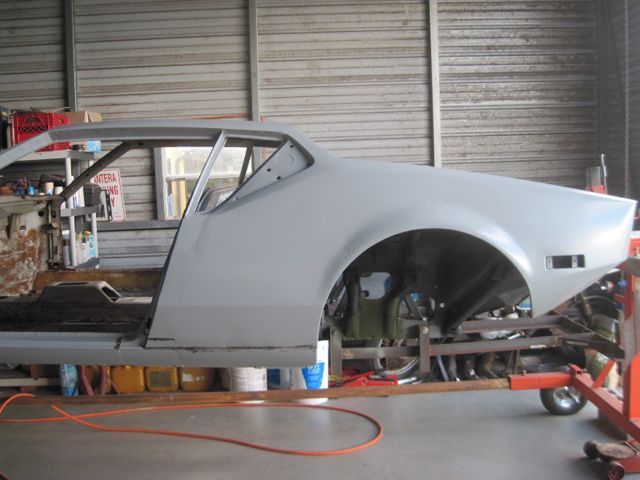

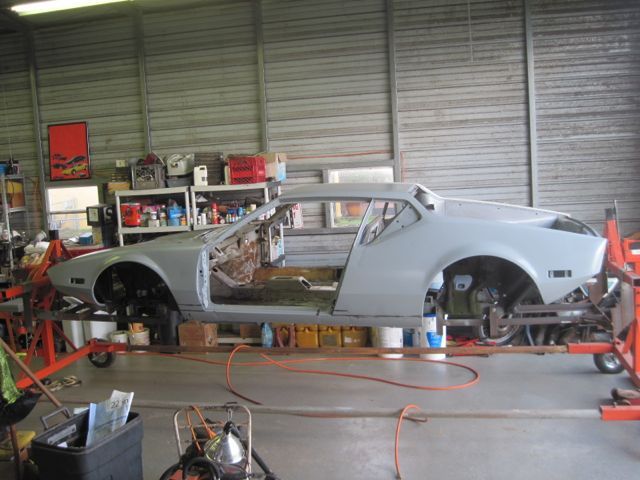
You can see I’ve already put some epoxy into the body seams where I need to contour them to make them uniform again. I won’t mess with it anymore until I am ready to do the second coat of primer over the whole thing. I have a few minor wrinkles to fix around the rear wheel arch, but for the most part, I’m about done with this side.
This side needs a bit of work yet:

When I work my way up this side, from rear to front this time, I’ll roll it outside and primer it again. Then I’ll take it off the rotisserie to do the front and rear repairs.
Stay tuned!
So on with the show. Here are just a few pics of the overall progress. Just to recap, I started with the deck lid and trunk lid. The metal work is done on them and they are in primer, wrapped in plastic and stored away. Then I cleaned up the engine bay and painted it. I removed the doors and dismantled all of the glass, trim and so on. The doors were so badly rusted I bought a set. Meanwhile, I pulled the fixed glass, and did the metal repairs around them as far as I could. The new doors arrived, and I stripped and repaired them as needed, painted, and test fitted all the mechanisms to make sure I had no surprises waiting there. They too are wrapped up and stored away. Next I repaired the floor pans, which had both rust and jacking damage. Then I worked my way down the driver’s side, front to back, repairing all of the rust damage. There is very little accident damage on this side of the car.
At this point, I cleaned up what I had done so far, and rolled it outside for primer, as you see here:



You can see I’ve already put some epoxy into the body seams where I need to contour them to make them uniform again. I won’t mess with it anymore until I am ready to do the second coat of primer over the whole thing. I have a few minor wrinkles to fix around the rear wheel arch, but for the most part, I’m about done with this side.
This side needs a bit of work yet:

When I work my way up this side, from rear to front this time, I’ll roll it outside and primer it again. Then I’ll take it off the rotisserie to do the front and rear repairs.
Stay tuned!
The right side repairs are almost the same as the left, so much the same work needs to be done. Stripping off the undercoat reveals the rust damage:
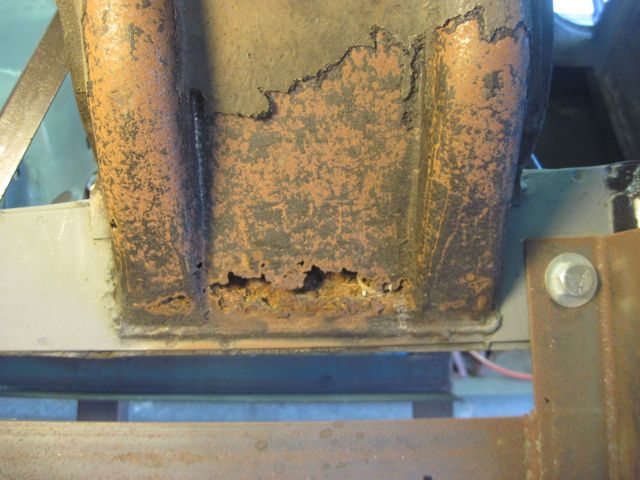
The inside is always worse:
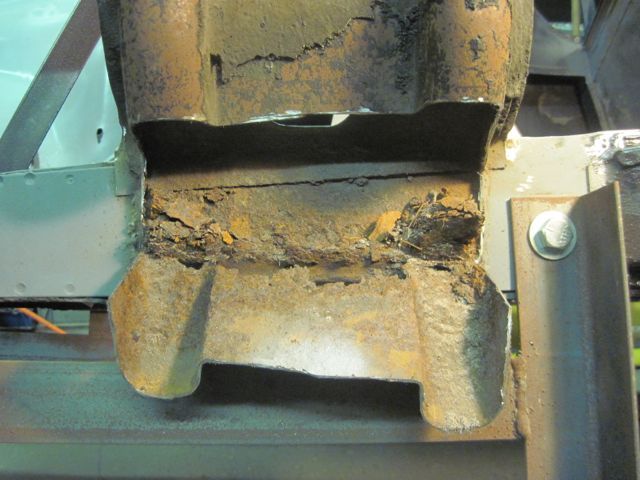
This side is not as bad as the left. I can see through the access hole that the damage on this side does not extend up so far:
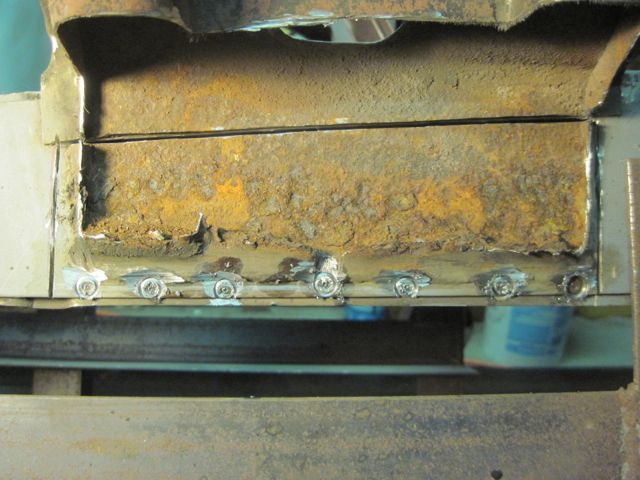
This time I use the grinding disc to start, not the plasma cutter. Just to save myself from doing it twice, since I have a better idea about the extent of the damage that needs to be cut away:


Cutting the spot welds along the lower frame rail flange finally cuts this piece free:

Again, thankfully, very little rust on the inside:
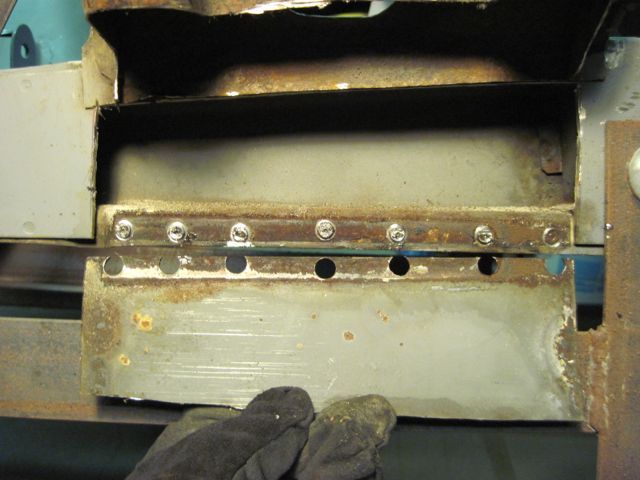
Here I have trimmed away another 1/2 inch of the inner wheel house metal. Just to satisfy myself that there is only surface rust and scale between these pieces. Because of this, I do not have to cut the outer frame rail panel all the way to the top.
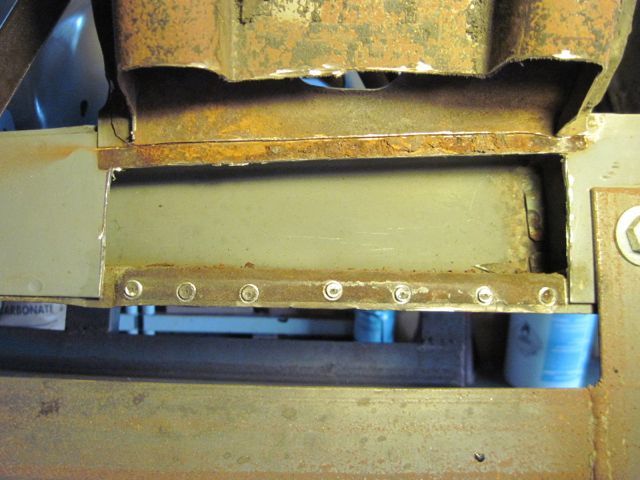
They are not welded together inside this structure, only on the engine bay side. This also gets the thin inner wheel house metal out of my way, so I can clean the frame rail pieces up for priming and welding:

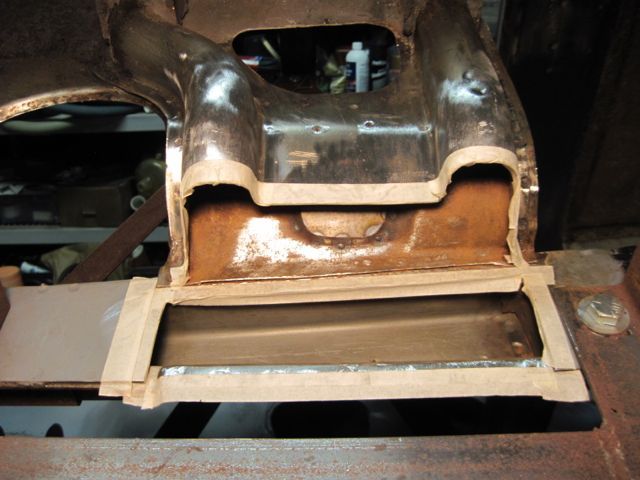
Now, however, I have a hole on the right side, and not on the left. The simple answer is to weld a cover over this one:
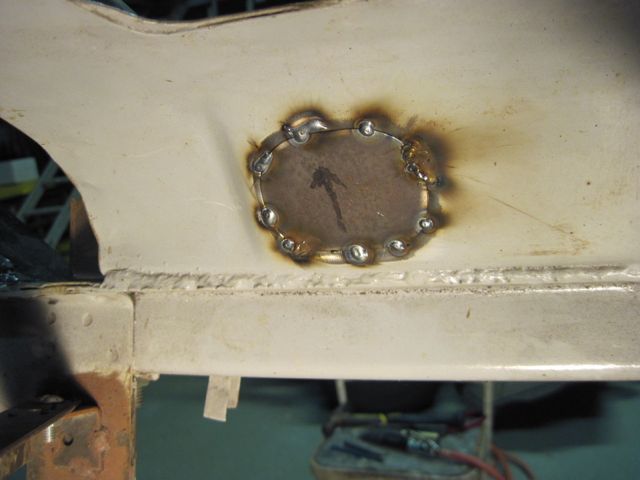
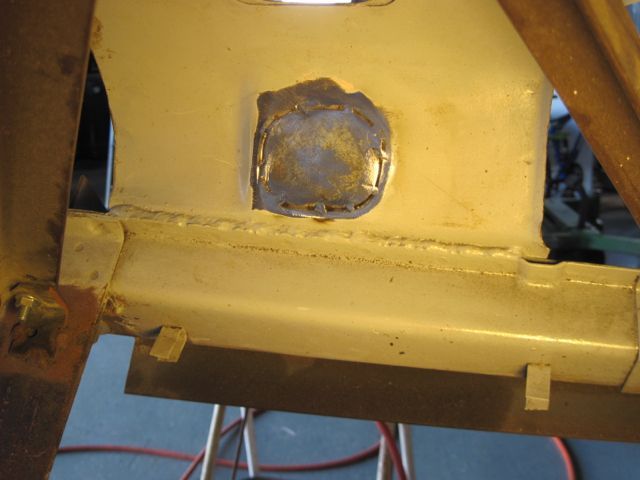
Next, the frame rail repair piece is welded in:
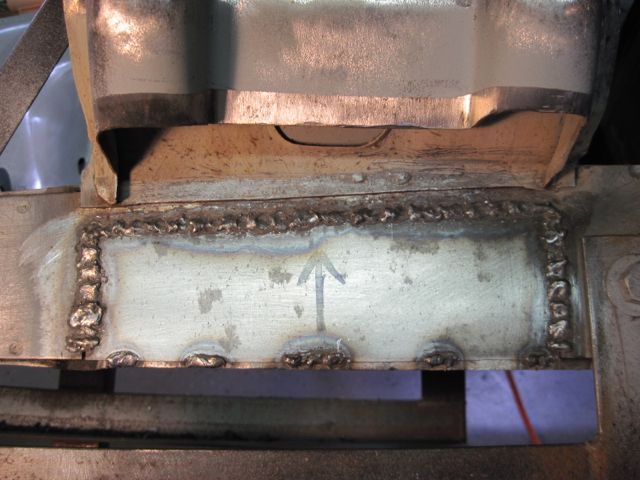
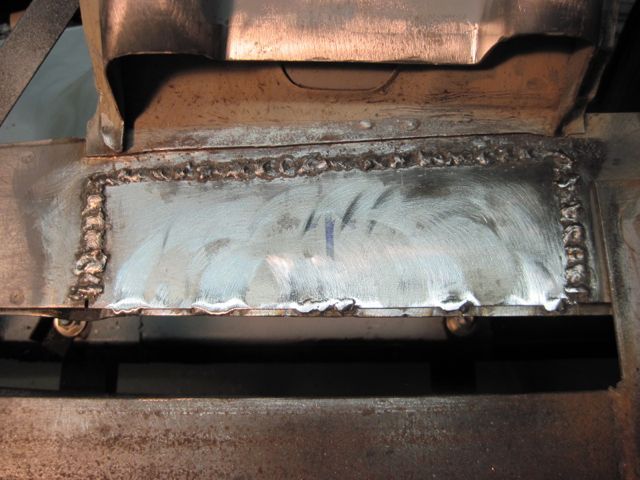
Now to rebuild the outer structure:
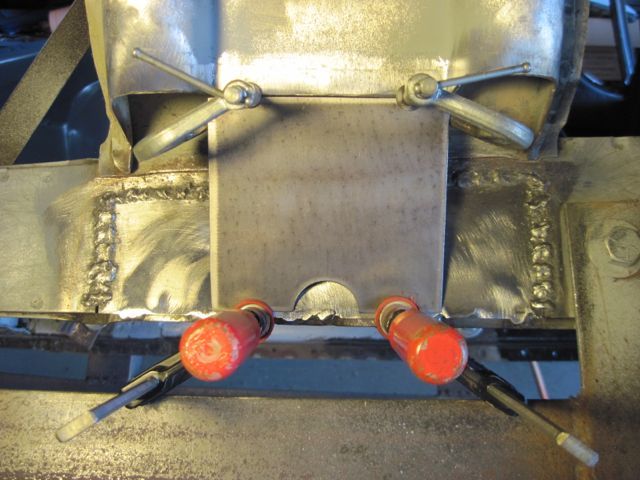


Almost done:
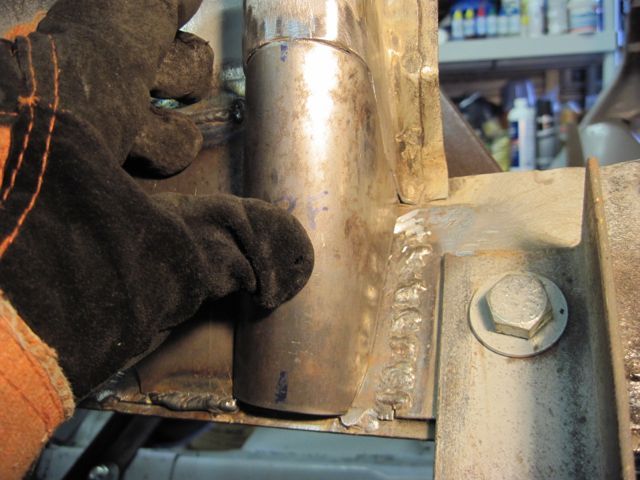
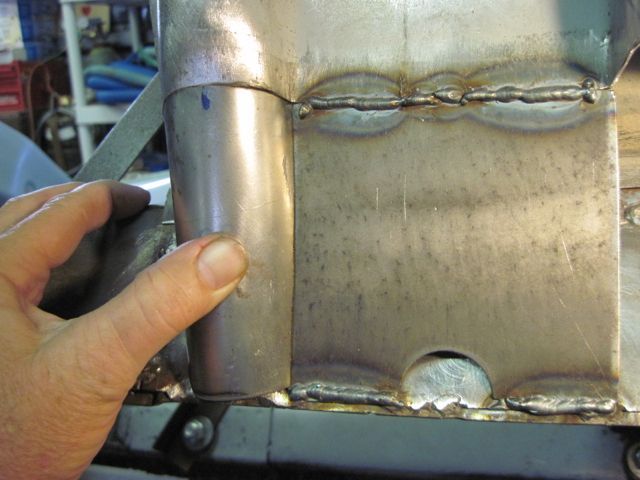
Ready to do the last few welds:
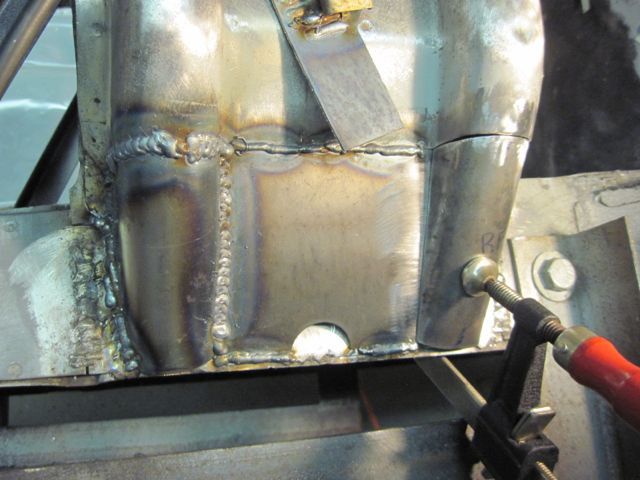
Next episode; I’ll go back in time (a bit) to fill in some gaps.

The inside is always worse:

This side is not as bad as the left. I can see through the access hole that the damage on this side does not extend up so far:

This time I use the grinding disc to start, not the plasma cutter. Just to save myself from doing it twice, since I have a better idea about the extent of the damage that needs to be cut away:


Cutting the spot welds along the lower frame rail flange finally cuts this piece free:

Again, thankfully, very little rust on the inside:

Here I have trimmed away another 1/2 inch of the inner wheel house metal. Just to satisfy myself that there is only surface rust and scale between these pieces. Because of this, I do not have to cut the outer frame rail panel all the way to the top.

They are not welded together inside this structure, only on the engine bay side. This also gets the thin inner wheel house metal out of my way, so I can clean the frame rail pieces up for priming and welding:


Now, however, I have a hole on the right side, and not on the left. The simple answer is to weld a cover over this one:


Next, the frame rail repair piece is welded in:


Now to rebuild the outer structure:



Almost done:


Ready to do the last few welds:

Next episode; I’ll go back in time (a bit) to fill in some gaps.
I got things a bit out of order. I actually did some of the right A pillar repairs along with the left. As they are more - or - less mirror images of each other, it seemed like a good idea to make some of the repair pieces at the same time.
Here is a look at the area before stripping it down:
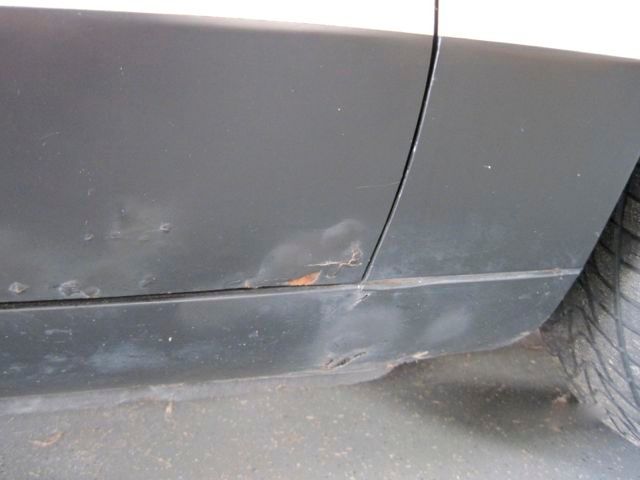
It is amazing how much damage can be covered with bondo and paint. Scary:
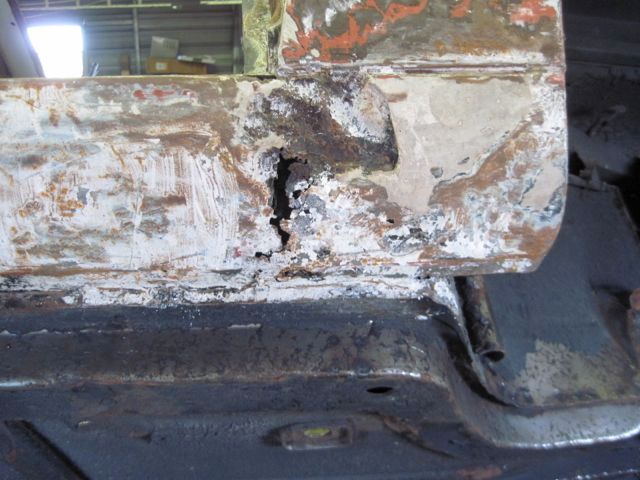
No point in wasting time, taking the bondo off of a piece that obviously has to be thrown away and rebuilt from scratch:
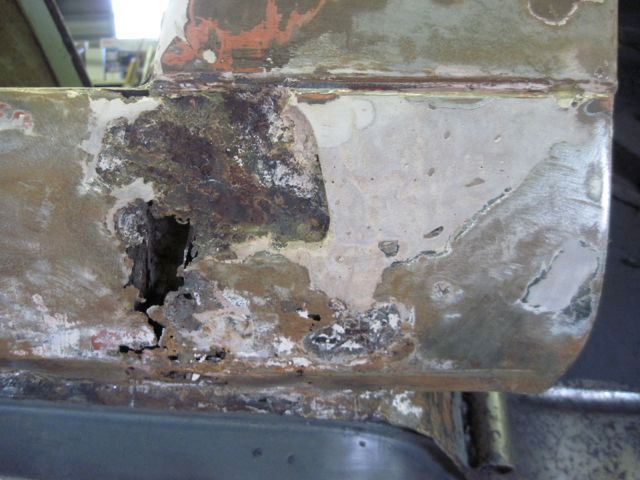
I will toss it in the junk bucket and keep it till I’m done, however. Even a nasty scrap like this is helpful to recreate the contours in the replacement piece.
This is the lower front corner of the door frame, just below the hinge:
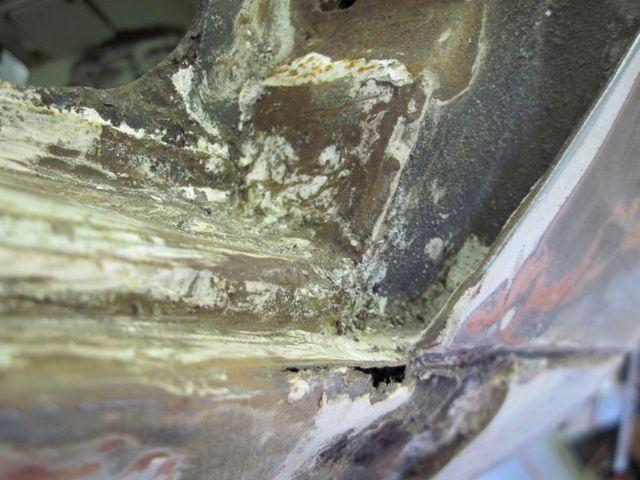
And here the inside view:
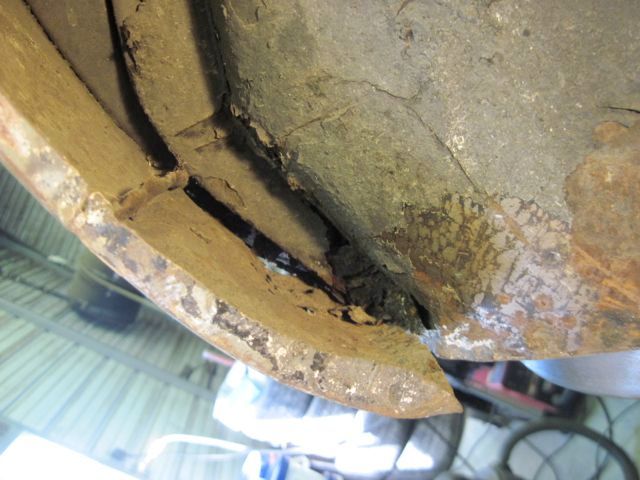
A shame the factory did not put a rock shield here. A simple piece of sheet metal would have made a big difference. You can be sure I’m going to put one in.
Starting to strip paint off the fender:
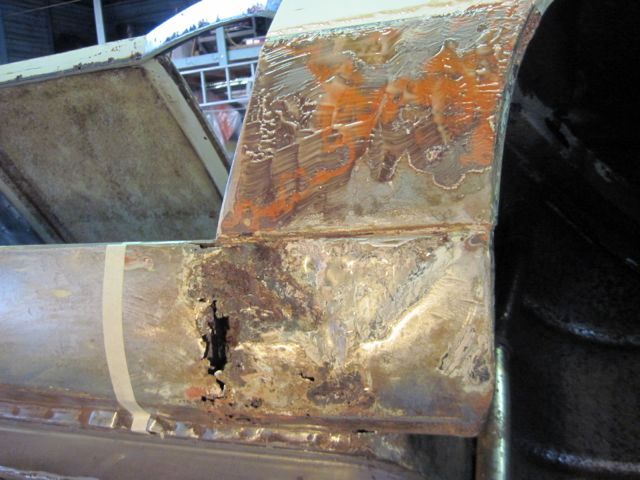
Cutting spot welds and sectioning the pieces to be cut apart:
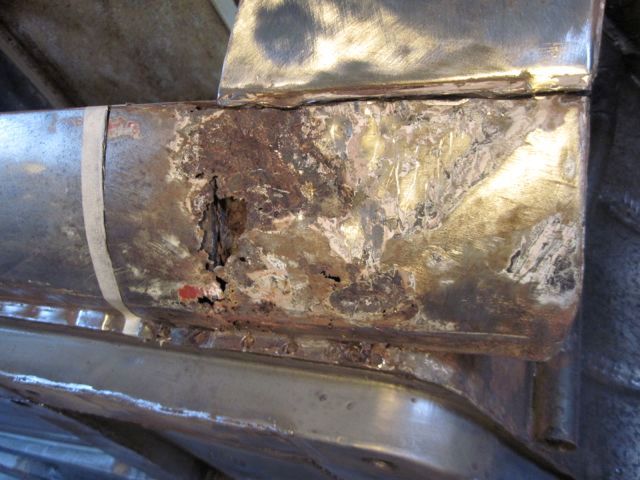
The forward most piece of the outer rocker is cut free:
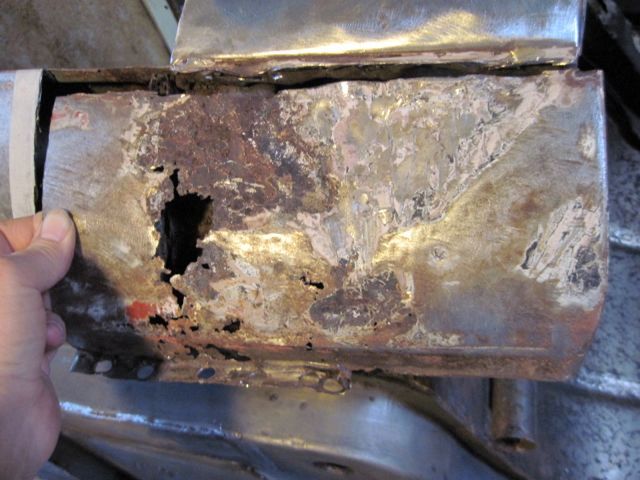
Revealing more nastyness:
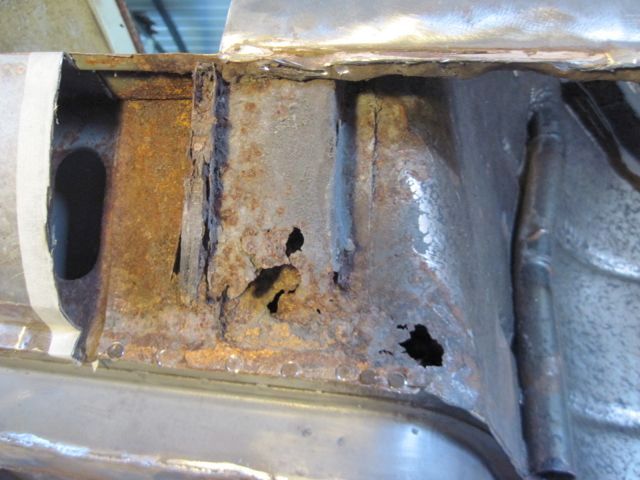
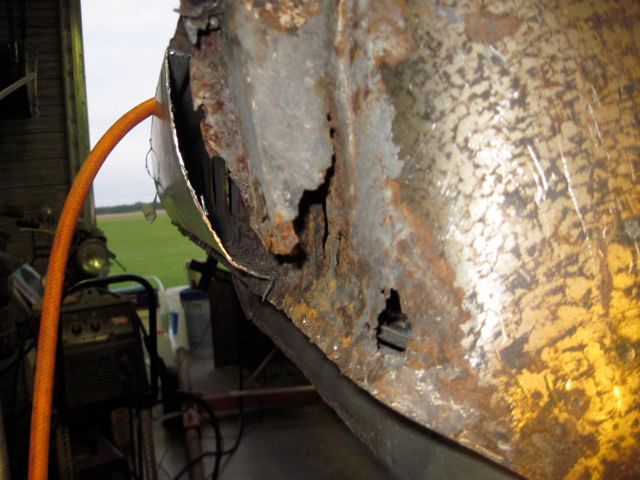
Heating bondo and putty with a propane torch will soften it up, but be careful; it will burn if you get it hot enough:
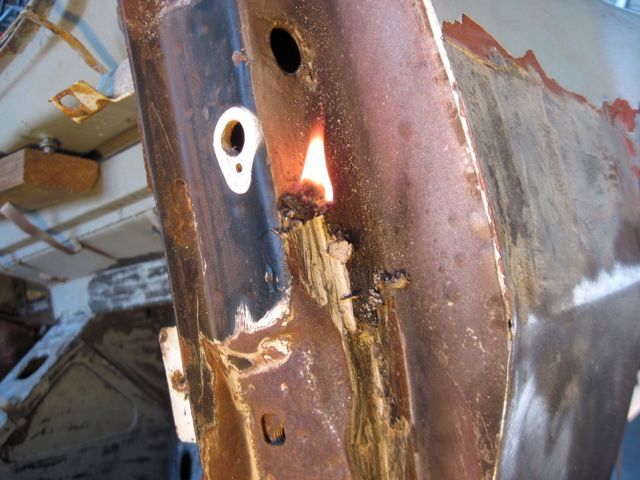
There was a lot of bondo in here, covering up a slightly bent A pillar. I think this contour panel was replaced. I can’t see how you could bend the A pillar without destroying it. I’ll be looking closely at this area when I get to fitting the new doors:
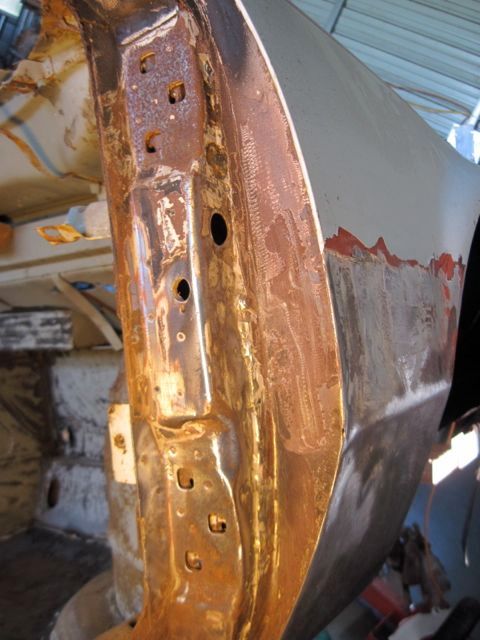
Just like on the driver’s side, the bottom of this A pillar has to be cut off:
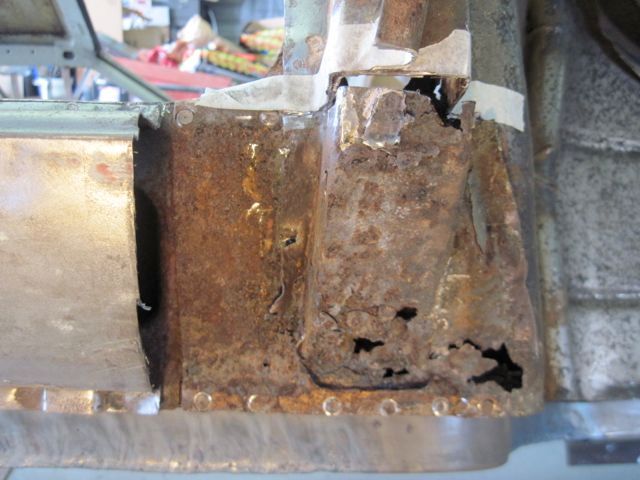
Rust never sleeps:
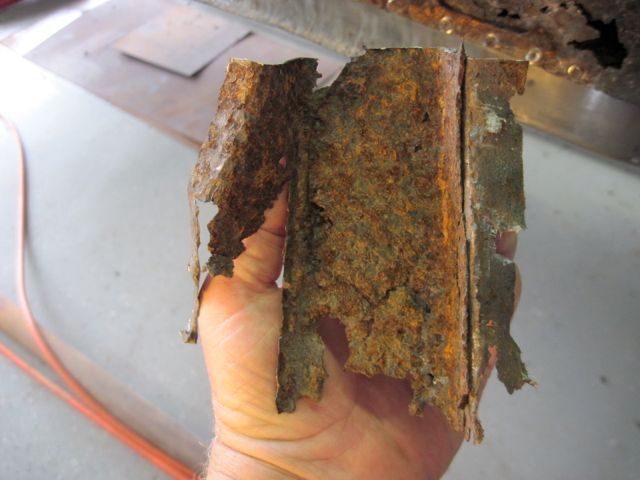
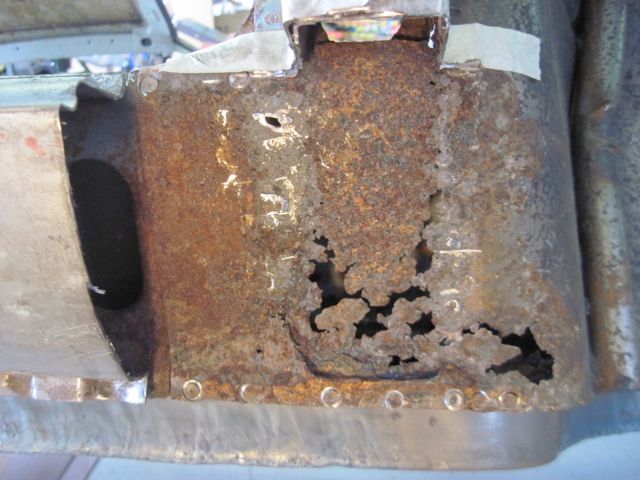
Starting to cut away the wheel well surround from the mid rocker and floor pan. Now having had the other side apart, I know where the lap seam is:
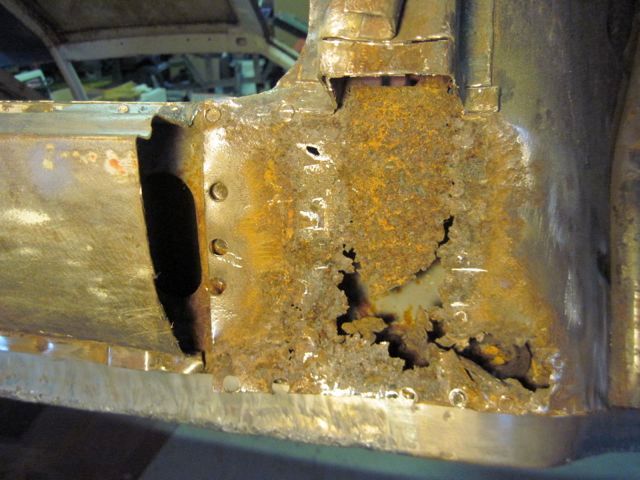
I had to cut another 1/2 inch off the bottom of the A pillar to get at the rusty metal under it. The tape is my guide for cutting away the damaged section:
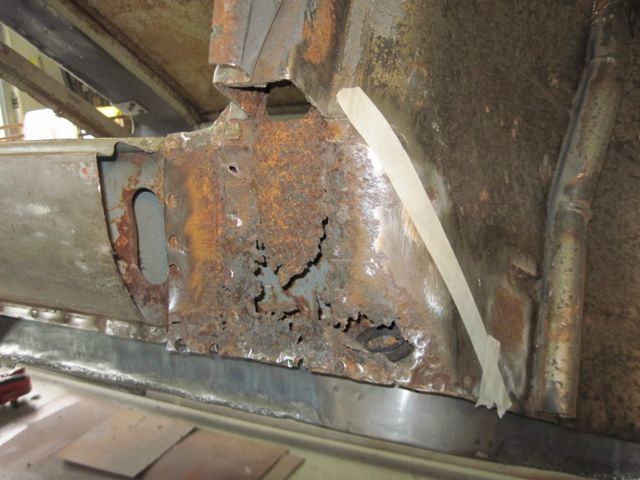
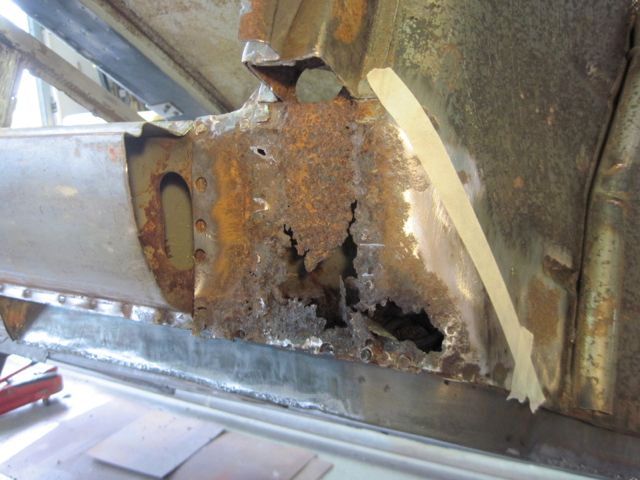
And off it comes:
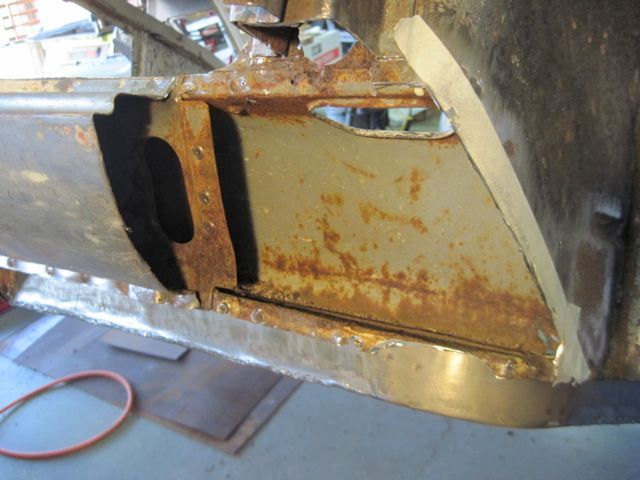
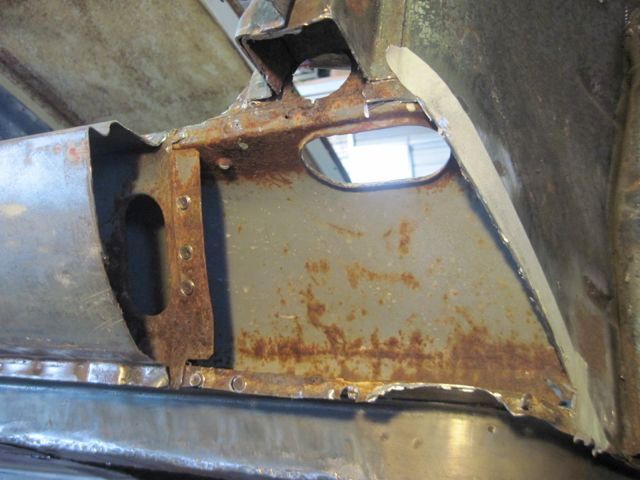
This car has rust in some bizarre places; this just below the fuse box mount:
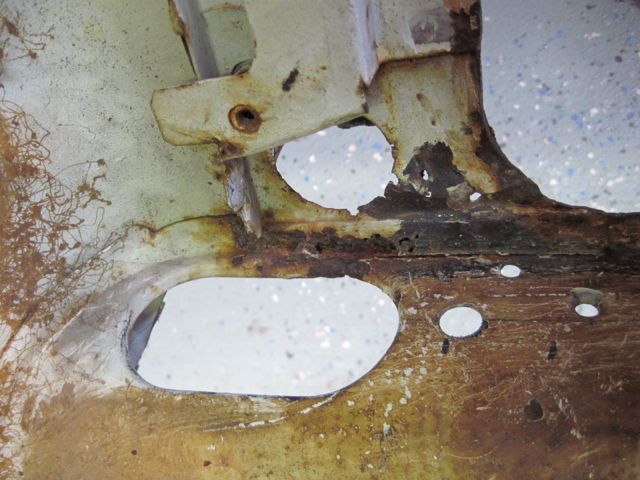
Most of the de-construction is done here, so next time I’ll start to detail some of the re-construction. Stay tuned!
Here is a look at the area before stripping it down:

It is amazing how much damage can be covered with bondo and paint. Scary:

No point in wasting time, taking the bondo off of a piece that obviously has to be thrown away and rebuilt from scratch:

I will toss it in the junk bucket and keep it till I’m done, however. Even a nasty scrap like this is helpful to recreate the contours in the replacement piece.
This is the lower front corner of the door frame, just below the hinge:

And here the inside view:

A shame the factory did not put a rock shield here. A simple piece of sheet metal would have made a big difference. You can be sure I’m going to put one in.
Starting to strip paint off the fender:

Cutting spot welds and sectioning the pieces to be cut apart:

The forward most piece of the outer rocker is cut free:

Revealing more nastyness:


Heating bondo and putty with a propane torch will soften it up, but be careful; it will burn if you get it hot enough:

There was a lot of bondo in here, covering up a slightly bent A pillar. I think this contour panel was replaced. I can’t see how you could bend the A pillar without destroying it. I’ll be looking closely at this area when I get to fitting the new doors:

Just like on the driver’s side, the bottom of this A pillar has to be cut off:

Rust never sleeps:


Starting to cut away the wheel well surround from the mid rocker and floor pan. Now having had the other side apart, I know where the lap seam is:

I had to cut another 1/2 inch off the bottom of the A pillar to get at the rusty metal under it. The tape is my guide for cutting away the damaged section:


And off it comes:


This car has rust in some bizarre places; this just below the fuse box mount:

Most of the de-construction is done here, so next time I’ll start to detail some of the re-construction. Stay tuned!
I’ll start by sectioning out this rusty bit below the fuse box bracket:
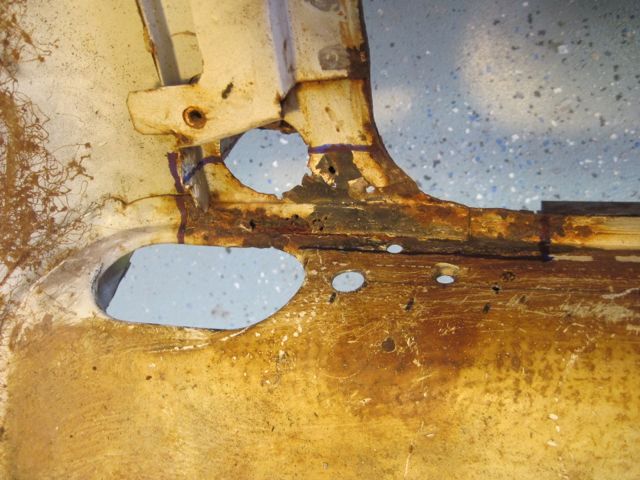
Rough cut on the repair piece:
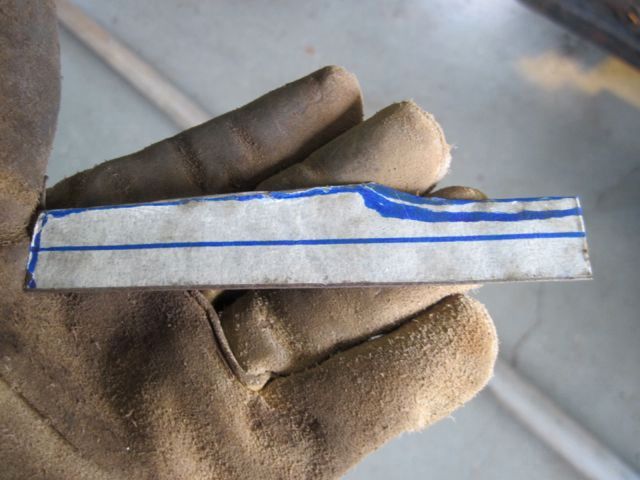
After some shaping:
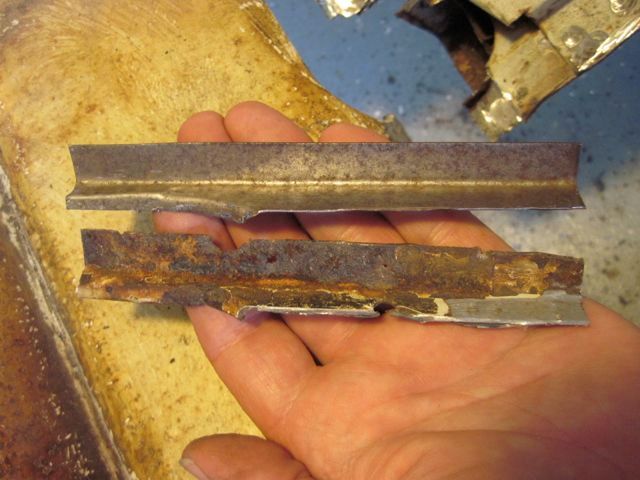
Clamping in place to weld:

Raw welding work:
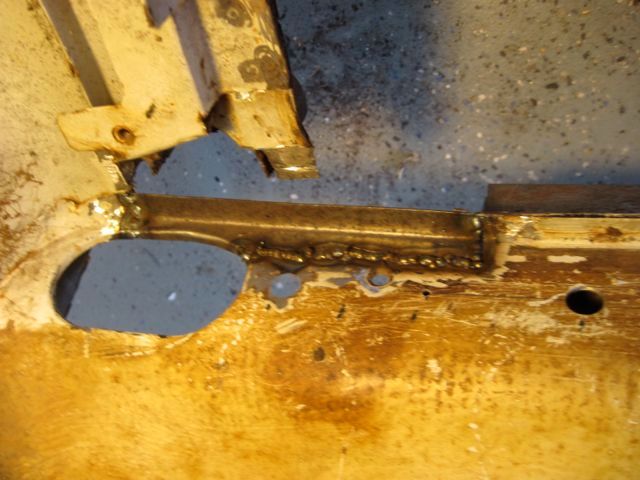
And after some smoothing:
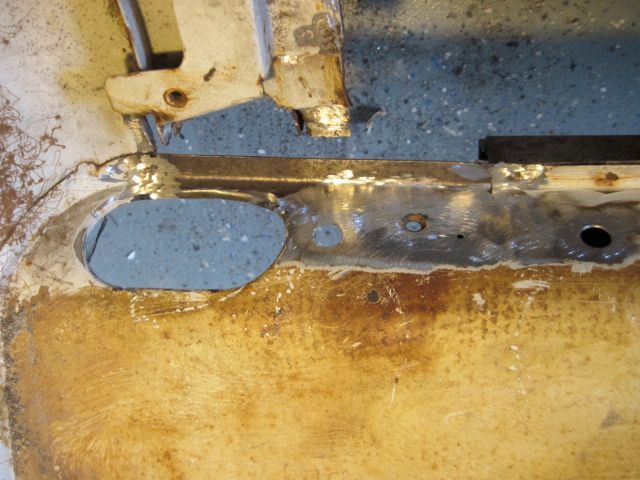
View from the inside:
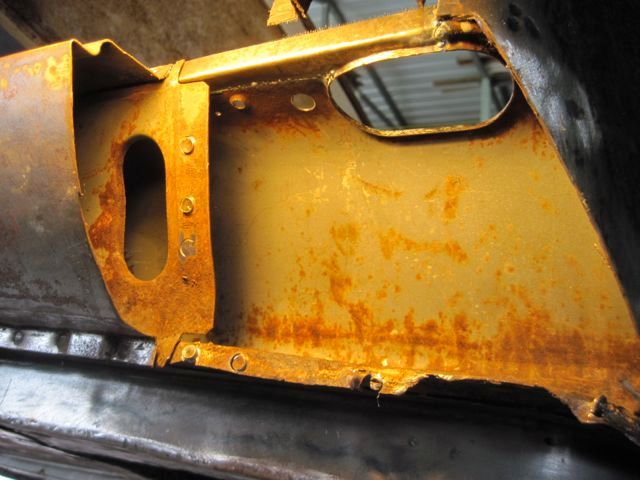
I decided to try a different approach to the floorpan corner where it curves in to meet the wheel well:
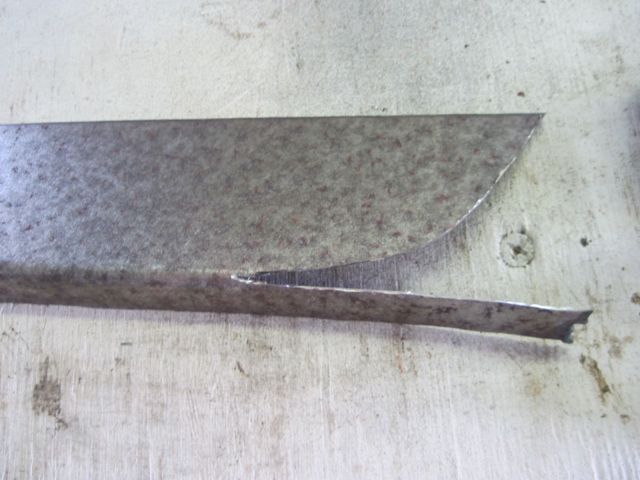
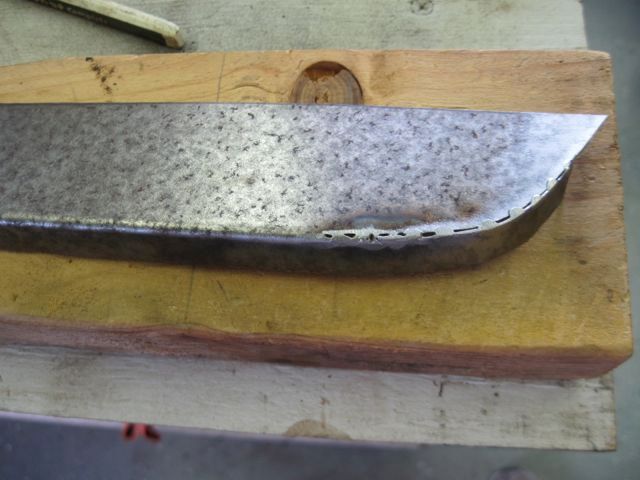
Here is the section that needs to come off; rusty and pretty beat up:
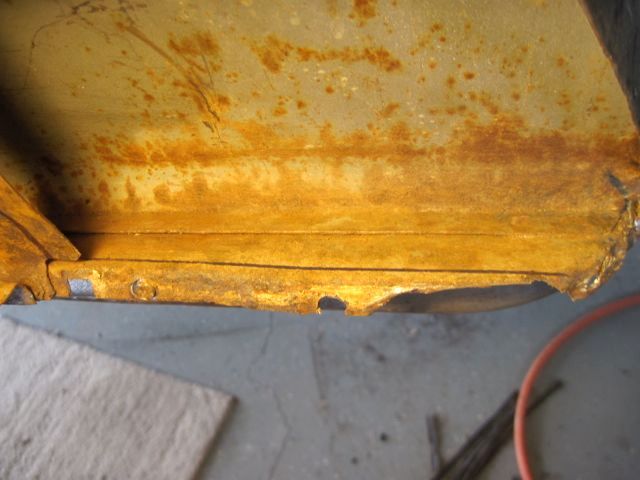
I will overlap the repair piece with the good metal that remains:

Test fitting:

A gap needs to be filled here:
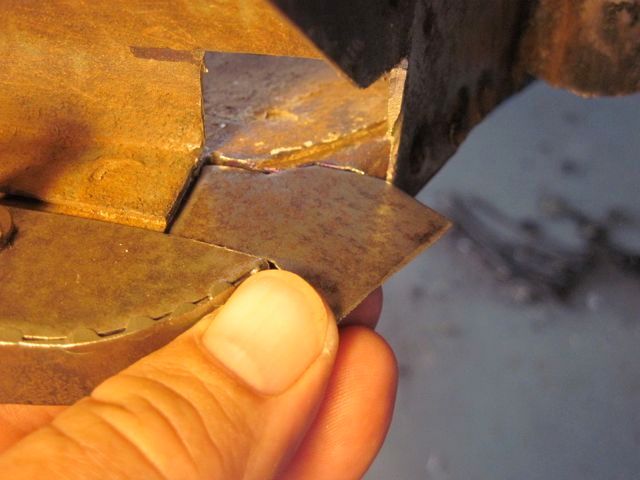
Remember I said the little pieces can be the hardest to do. It took me 4 tries to get this little bugger right:
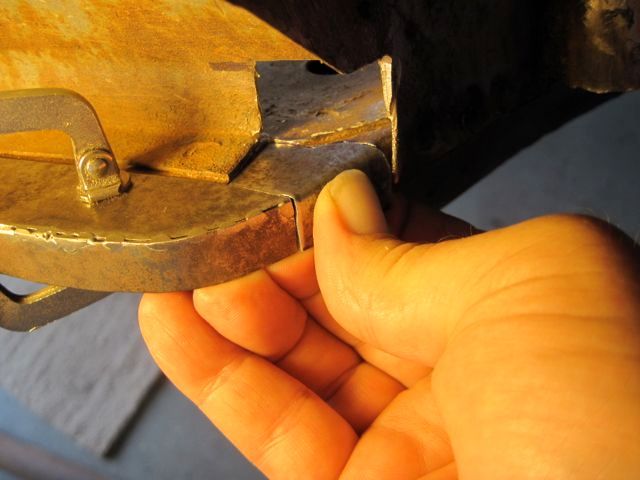
Next comes the bottom of the A pillar’s inner panel. I used a hole saw in this piece:
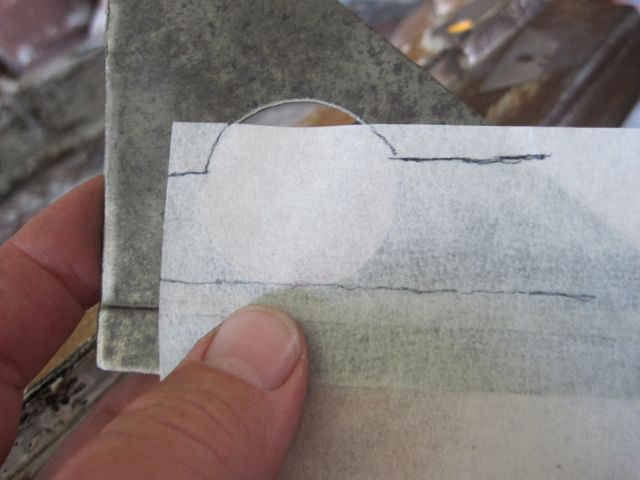
Then cut and flanged it to match the mating pieces:
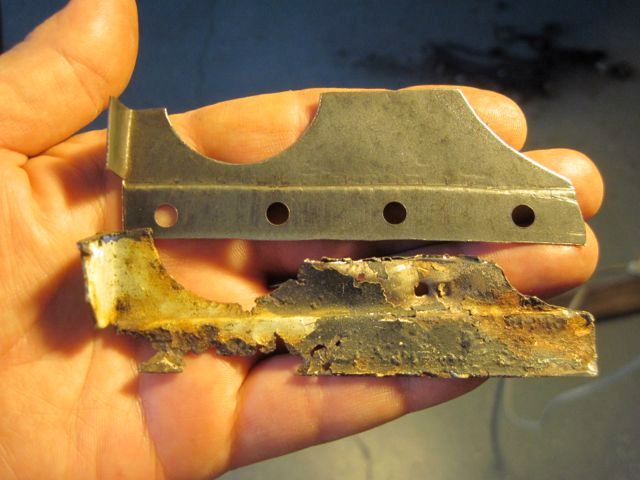
This portion of the wheel well surround, where it joins the mid-rocker, is pretty straight forward. The screws are only there because I can’t get a clamp that far back to hold them together:
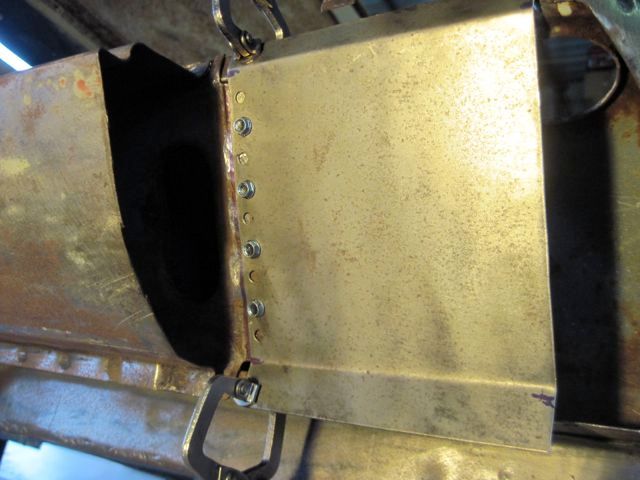
Now to start welding:
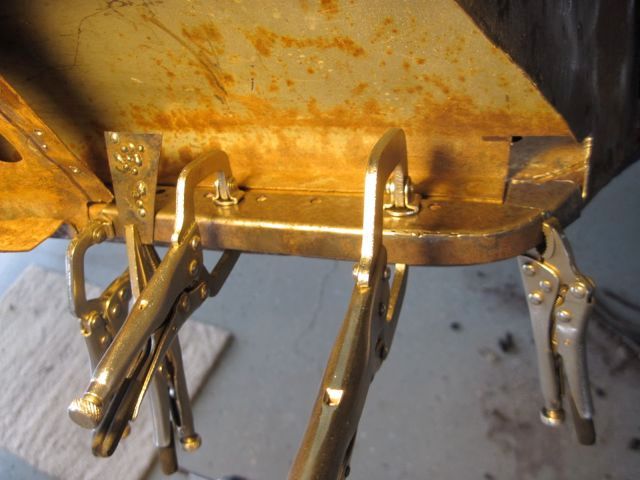
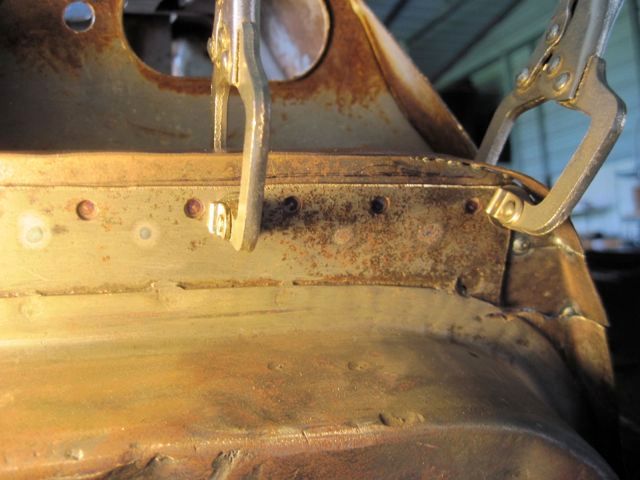

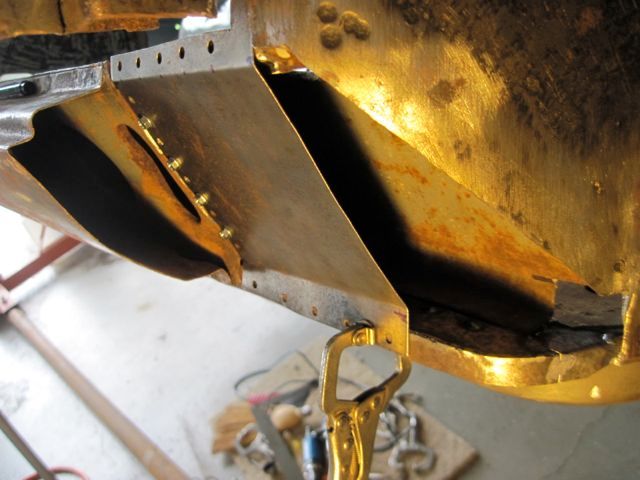
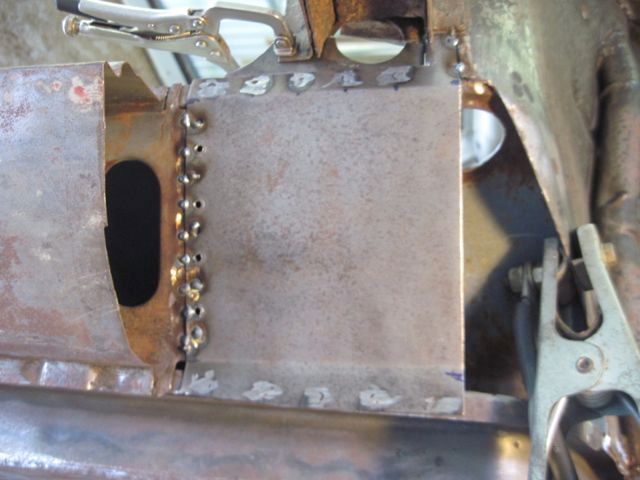
One more little patch, and a drain / access hole, while I can still get at this area:
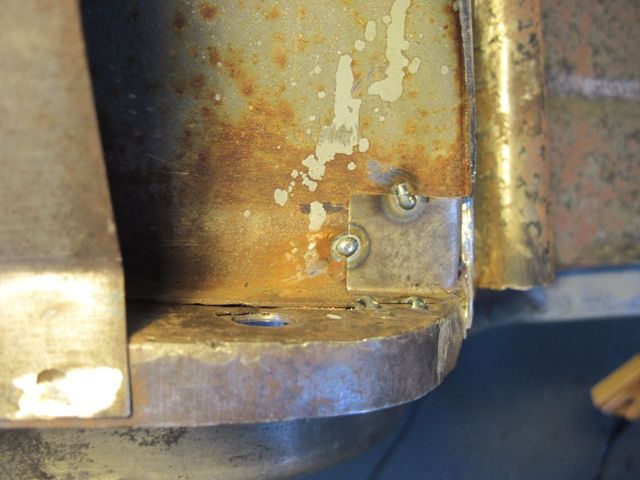
Here I’m just checking all clear, before I put in my roll cage reinforcement:
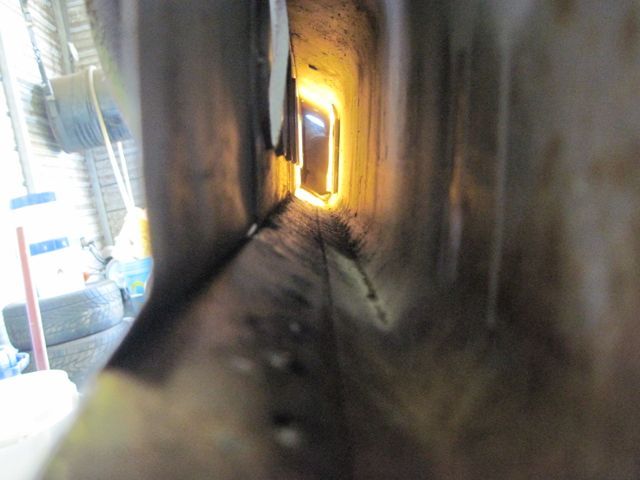
Now to patch in this contoured piece of the wheel well surround:
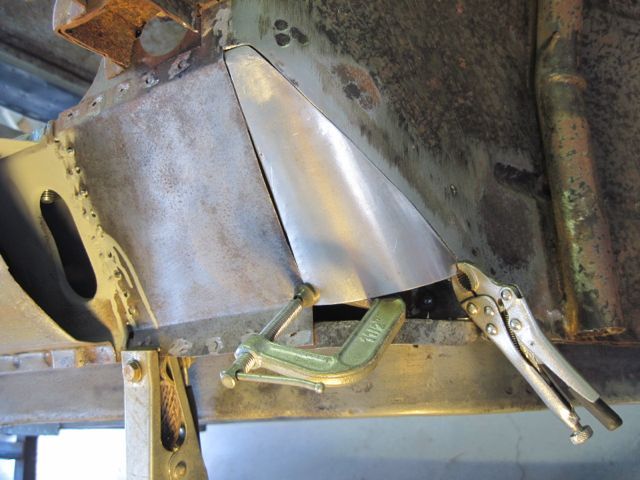
These kind of pieces are a bear to get fitted just right:
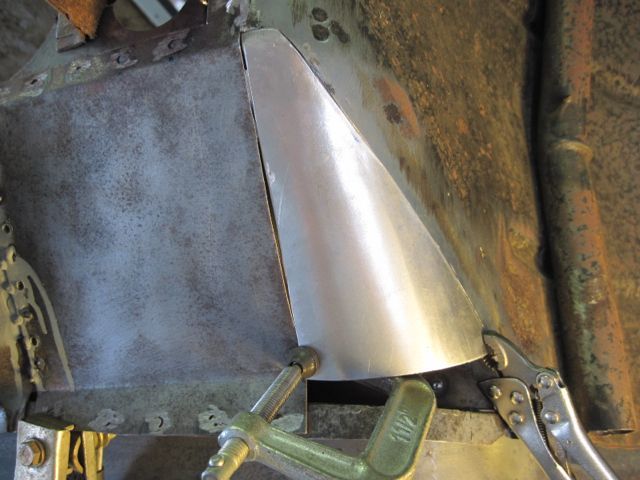
Finally time to weld:
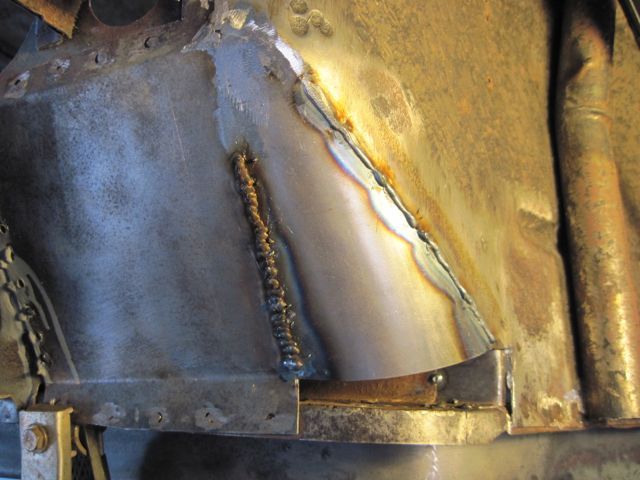
Not sure why I do not have any pics of finishing this area. I will take some if I need, to finish this part.

Rough cut on the repair piece:

After some shaping:

Clamping in place to weld:

Raw welding work:

And after some smoothing:

View from the inside:

I decided to try a different approach to the floorpan corner where it curves in to meet the wheel well:


Here is the section that needs to come off; rusty and pretty beat up:

I will overlap the repair piece with the good metal that remains:

Test fitting:

A gap needs to be filled here:

Remember I said the little pieces can be the hardest to do. It took me 4 tries to get this little bugger right:

Next comes the bottom of the A pillar’s inner panel. I used a hole saw in this piece:

Then cut and flanged it to match the mating pieces:

This portion of the wheel well surround, where it joins the mid-rocker, is pretty straight forward. The screws are only there because I can’t get a clamp that far back to hold them together:

Now to start welding:





One more little patch, and a drain / access hole, while I can still get at this area:

Here I’m just checking all clear, before I put in my roll cage reinforcement:

Now to patch in this contoured piece of the wheel well surround:

These kind of pieces are a bear to get fitted just right:

Finally time to weld:

Not sure why I do not have any pics of finishing this area. I will take some if I need, to finish this part.
quote:Thanks Garth. Did you get your block fixed after it inhaled the air cleaner screw?
Nope! It's still with the machinist. They may have sleeved the #8 cylinder already, but informed me the piston was collapsed and needed to be replaced. Only problem, Probe no longer makes pistons! Since this is a stroker engine, I couldn't just purchase any other piston to replace the damaged one, so I started looking at the stroker piston offerings from other manufacturers - was getting crazy quotes of $1,000 and up for 383 stroker pistons, but only available .030 over, which means I would have to bore my block again to punch it out from .020 to .030. So I began searching the country for a set of .020 over Probe SRS forged stroker pistons for a 351C and found a set on the East Coast. Had to buy the whole set, but it was half the cost of any others I got quotes for, and I don't need to punch out my block any further. They should arrive next week.
Thanks for asking. Now, back to your amazing work!
I really appreciate all of the great comments and feedback on this thread so far. Someone suggested that it would be a good time to start fitting the doors before I get too far along. Seemed like a good idea at the time; but that’s why I haven’t posted anything for a month. Dang what a can of worms!
I’m not done yet, but I have a solution to a difficult problem that I thought I would share with you.
Anyone who has done this already, knows what a pain it is to get the door in just the right position, then get the hinge bolts tightened up without moving the door. It’s not just a pain, it’s impossible. It’s not the bolts that hold the hinge to the door, those are easy. The flat head, countersunk screws that hold the hinge to the A pillar, cannot be tightened with the door in the closed position. They must be loose enough to allow the door to be jockeyed into position, then you open the door enough to tighten the screws, the door slips, and you start over. Again. And again. And again.
I really had to chew on this one for a while until I came up with a solution. First I spotted this obround hole on the interior side of the A pillar. This one on the driver’s side is just above the weldment that supports the dash and steering column:
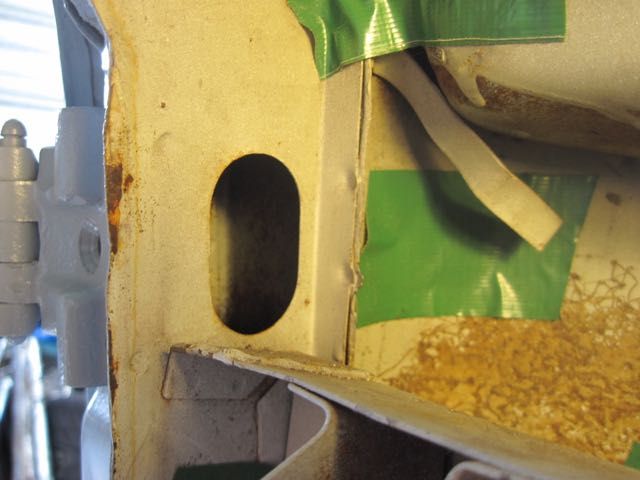
You can see the tips of the screws as the come through the captive nut plate in here, but that doesn’t do any good. Then I realized that I don’t need to get all three of them tight; one will be enough to hold the adjustment. The final piece of the puzzle is to use a nut and bolt, temporarily, in place of one of the screws. Ah-ha. I think I have the answer.
The screws here are M8 x 1.25 mm thread, and I needed a bolt that would pass through the threaded hole in the nut plate without engaging the threads. I used a 1/4 inch x 20 thread carriage head bolt. Just happened to be what I had on hand; M6 x 1 mm would work just as well for you metric guys. I welded a square bit of metal on top to keep it from turning:
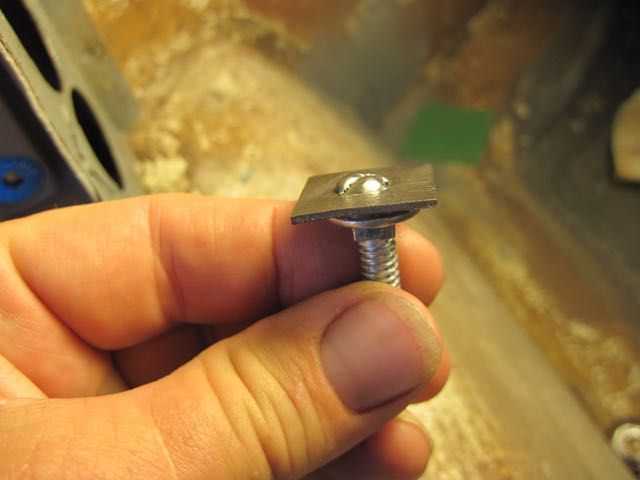
Install the through - bolt in the center hole, and the regular flat head screws in the other two positions. Tighten just snug, then back off about 1/2 turn:

Put a flat washer and nut on the through bolt, inside the A pillar:
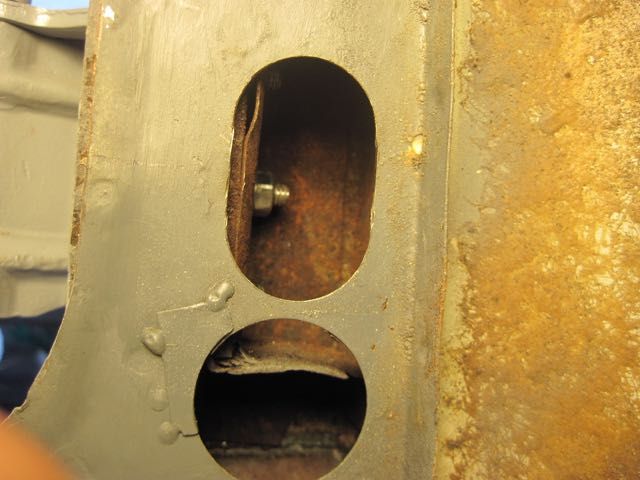
Unfortunately, the factory did not put one of these convenient holes next to the lower hinge, so I had to add it:
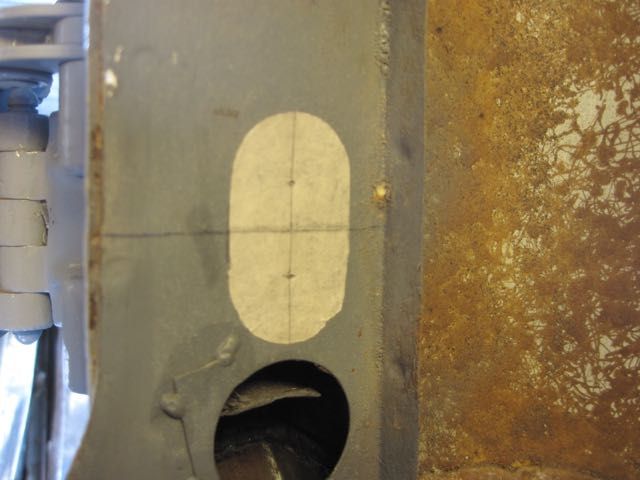
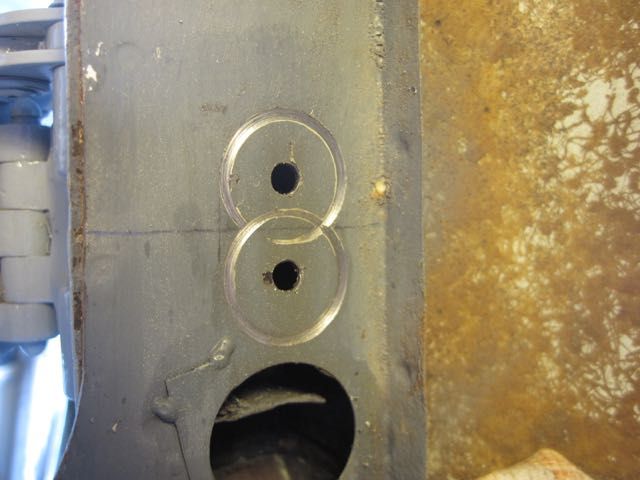
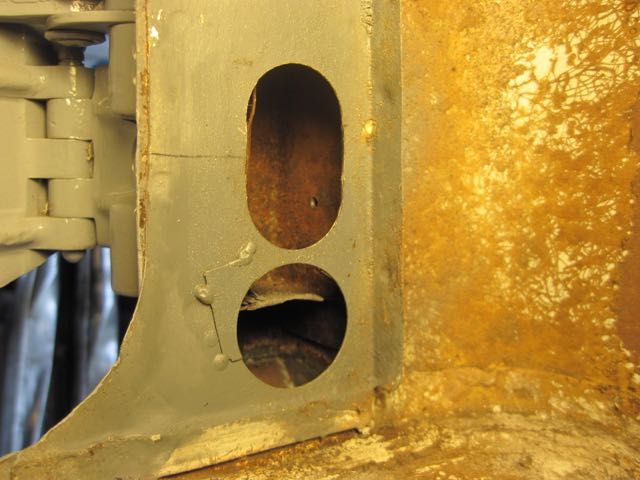
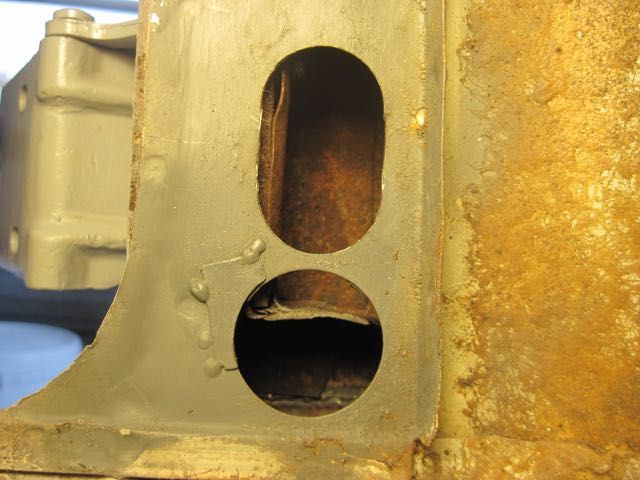
Next time I’ll add some more door alignment ideas I came up with.
I’m not done yet, but I have a solution to a difficult problem that I thought I would share with you.
Anyone who has done this already, knows what a pain it is to get the door in just the right position, then get the hinge bolts tightened up without moving the door. It’s not just a pain, it’s impossible. It’s not the bolts that hold the hinge to the door, those are easy. The flat head, countersunk screws that hold the hinge to the A pillar, cannot be tightened with the door in the closed position. They must be loose enough to allow the door to be jockeyed into position, then you open the door enough to tighten the screws, the door slips, and you start over. Again. And again. And again.
I really had to chew on this one for a while until I came up with a solution. First I spotted this obround hole on the interior side of the A pillar. This one on the driver’s side is just above the weldment that supports the dash and steering column:

You can see the tips of the screws as the come through the captive nut plate in here, but that doesn’t do any good. Then I realized that I don’t need to get all three of them tight; one will be enough to hold the adjustment. The final piece of the puzzle is to use a nut and bolt, temporarily, in place of one of the screws. Ah-ha. I think I have the answer.
The screws here are M8 x 1.25 mm thread, and I needed a bolt that would pass through the threaded hole in the nut plate without engaging the threads. I used a 1/4 inch x 20 thread carriage head bolt. Just happened to be what I had on hand; M6 x 1 mm would work just as well for you metric guys. I welded a square bit of metal on top to keep it from turning:

Install the through - bolt in the center hole, and the regular flat head screws in the other two positions. Tighten just snug, then back off about 1/2 turn:

Put a flat washer and nut on the through bolt, inside the A pillar:

Unfortunately, the factory did not put one of these convenient holes next to the lower hinge, so I had to add it:




Next time I’ll add some more door alignment ideas I came up with.
Now that is pretty slick! I like it.
Sheesh - has it really been 3 months since I added anything!? I have been making progress, but got behind with my posting, so now to get caught up.
This door fitting business has really been time consuming. It is one of those jobs that just has to be done, and cannot be over looked in a restoration. A re-paint job or some minor repairs would not be nearly this hard. But I have had to repair or replace parts of the chassis that make up the door frame, and I have “new” (not the originals) doors to fit. The originals are so rusty they cannot be reasonably repaired. The “new” doors do not fit exactly the same, but more on this issue in a bit.
Last time I detailed the way I found to tighten the door hinge screws with the door closed. To do the right side, an access hole to the lower hinge screws is needed, but the fuse holder bracket is in the way.
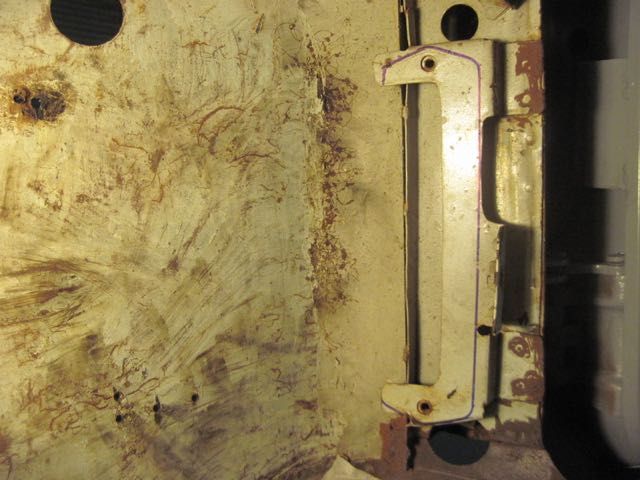
I outlined around the fuse block with a marker, just to be sure I was not about to do something dumb.
The bracket is spot welded on with 2 wide tabs and 2 small ones. I decided to cut them off, and not to try to drill out the welds. It was just easier to do this way. I will weld some new tabs on to the bracket, and put it back in with small sheet metal screws. The metal I left behind will give more thickness to screw in to.
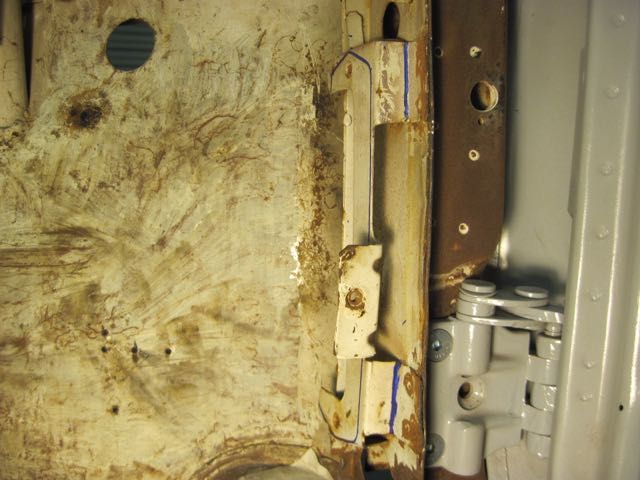
Off it comes, and ready to make the access hole for the lower hinge:

And the result:
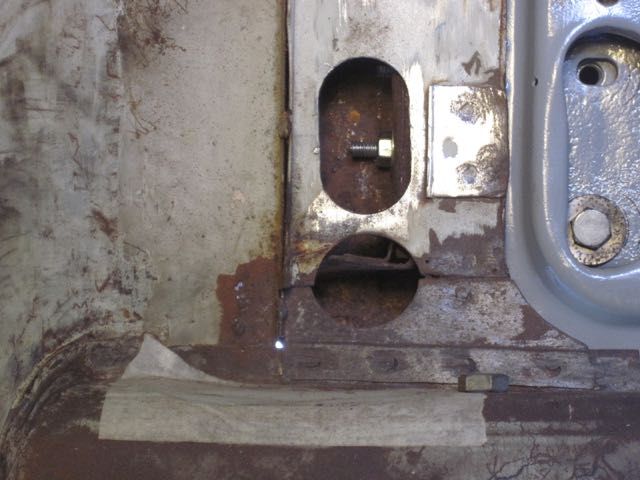
To set the height, or vertical position of the door within the frame, I made these little wood shims. They are cut pieces of cabinet shims, and marked with the thickness in millimeters:
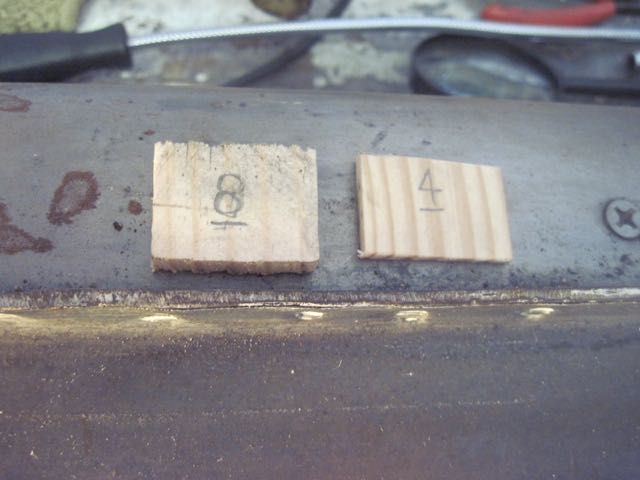
The shims go on the door sill, with double sided sticky tape to hold them (the white patches):
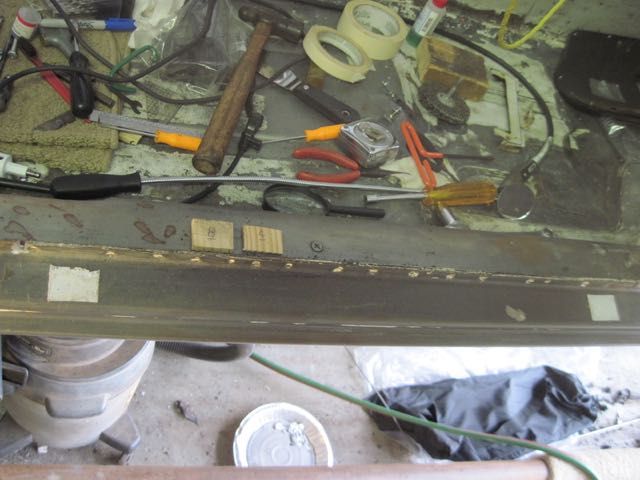
These little tools I made are clips to adjust the door in and out at the bottom:

I had to cut two small grooves in the sill flange, but this will be covered with the door seal later, so I thought no big deal:
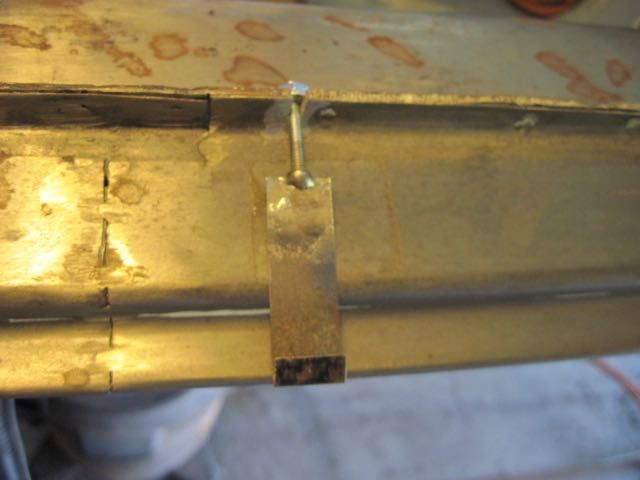
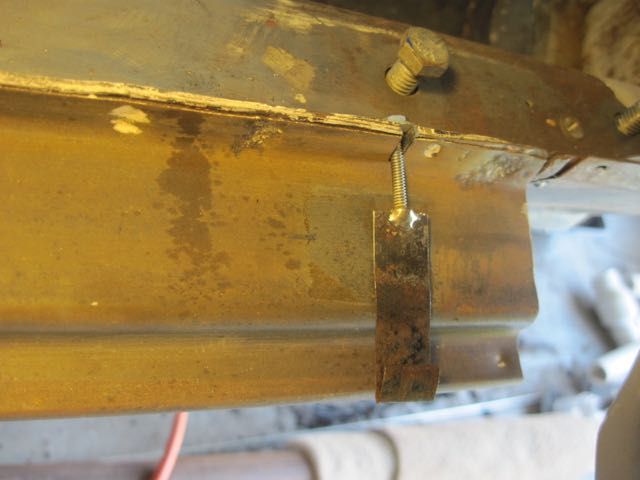
The clips grip the door in the drain slots on the underside:
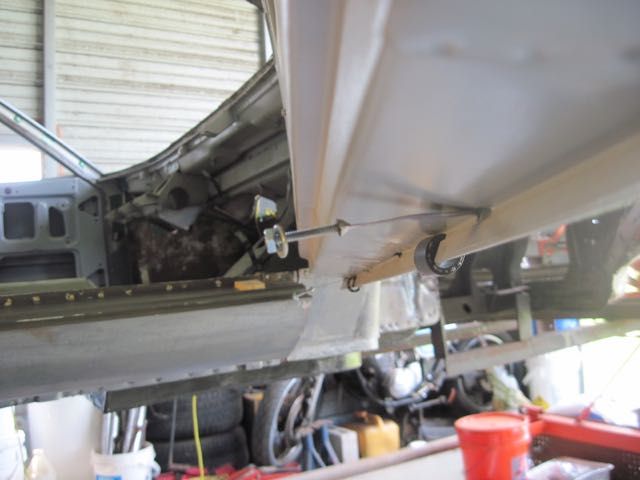
Using the adjustment clips, shims, and modified hinge access feature, it is possible to get a very good door fit with minimum fuss.
This door fitting business has really been time consuming. It is one of those jobs that just has to be done, and cannot be over looked in a restoration. A re-paint job or some minor repairs would not be nearly this hard. But I have had to repair or replace parts of the chassis that make up the door frame, and I have “new” (not the originals) doors to fit. The originals are so rusty they cannot be reasonably repaired. The “new” doors do not fit exactly the same, but more on this issue in a bit.
Last time I detailed the way I found to tighten the door hinge screws with the door closed. To do the right side, an access hole to the lower hinge screws is needed, but the fuse holder bracket is in the way.

I outlined around the fuse block with a marker, just to be sure I was not about to do something dumb.
The bracket is spot welded on with 2 wide tabs and 2 small ones. I decided to cut them off, and not to try to drill out the welds. It was just easier to do this way. I will weld some new tabs on to the bracket, and put it back in with small sheet metal screws. The metal I left behind will give more thickness to screw in to.

Off it comes, and ready to make the access hole for the lower hinge:

And the result:

To set the height, or vertical position of the door within the frame, I made these little wood shims. They are cut pieces of cabinet shims, and marked with the thickness in millimeters:

The shims go on the door sill, with double sided sticky tape to hold them (the white patches):

These little tools I made are clips to adjust the door in and out at the bottom:

I had to cut two small grooves in the sill flange, but this will be covered with the door seal later, so I thought no big deal:


The clips grip the door in the drain slots on the underside:

Using the adjustment clips, shims, and modified hinge access feature, it is possible to get a very good door fit with minimum fuss.
Add Reply
Sign In To Reply


